- Playa de las Americas
- Puerto de la Cruz
- Los Gigantes
- 5 Star Hotels
- 4 Star Hotels
- San Cristóbal de La Laguna
- Santa Cruz de Tenerife
- Teide National Park
- Tenerife Markets
- History of Tenerife
- Tenerife Map
- Weather and Climate
- Weather by Month in Tenerife

Inter-island Travel
- Tenerife Airport Transfers
- Tenerife Bus Routes and Timetables
- Tenerife Flights
- How to get to your Resort
- Exchanging Currency in Tenerife
- Prices in Tenerife
- Is Tenerife one hour ahead of the UK?

- About Tenerife History, Weather, Climate and Map of Tenerife.
- Attractions
- Cities/Towns
- How to get to your Resort Instructions on how to get to your resort by car, bus, taxi or airport transfer.
- Travel Info
Tenerife makes the perfect base to explore the Canary Islands with direct flights available to all of the other islands and ferry connections with all of the western islands as well as Gran Canaria, Lanzarote and Fuerteventura.
The majority of Inter-island flights operate from Tenerife North Airport with the southern airport used mostly for international flights. CanaryFly and Binter operate these routes using fleets of ATR 72 twin-turboprop aircraft.
Both Fred Olsen and Naviera Armas offer services between Los Cristianos and La Gomera, La Palma and El Hierro and between Santa Cruz and Gran Canaria.

Inter-Island Flights
Canaryfly Binter
Car Ferries
Naviera Armas Fred Olsen
Fuerteventura
Fuerteventura Guide
Lanzarote Guide
Gran Canaria
Canary Islands
Guide to the Canary Islands
12 Responses
Hi, what is the best method of getting to a hotel in Playa del las Americas from my hotel in Puerto de la Cruz? Thanks
administrator
I think that the best way would be to get the 343 bus from Puerto de la Cruz to the Magma bus stop near Playa de las Americas. Taxis to/from the hotels to the bus stops shouldn’t be too expensive. Otherwise, you could try to agree a price with a taxi driver to go direct, but it’s a long journey and might be expensive.
Noel Howard
Hi, We have been in Tenerife since October 19th and plan to go to Gran Canaria on January 3rd next. Do we have to do anything required to fly there since we will have been here for 10 weeks at that stage Thank you, NH.
Hi, It is my understanding that you are exempt from having to take a new test, but you will need to present a ‘declaration of responsibility for non-residents’ form along with documents that prove you arrived in the Canary Islands before the new requirement came into effect. You can read more on this and download the from here: https://turismodeislascanarias.com/en/covid-19-tests/
Karl Bailey
Hello I am going to fly from Gran Canaria to Tenerife. I was wondering how early I need to be at the airport before departure for internal flights
Hi, If you have hand luggage only, I would say an hour. If you need to check in a bag, then you should allow a bit longer.
Hi, we plan to arrive in Tenerife by ferry. Is it possible to take a bus from the ferry port to Playa de Las Americas? Are there direct buses and how long would the journey be? Just wondering if it would be better to fly to the south airport. We are coming from Gran Canaria. Thank you!
Hi, You can get the 110 bus from the Intercambiador Bus Station in Santa Cruz to the ‘Magma’ stop in Playa de Las Americas. The journey takes about 55 minutes.
Stefan Sergiu Varga
Hello. We are planning a trip to Canary Islands. We wat to go from Maspalomas to Costa Adeje, but google shows us a really really long route. We where wondering, is there any direct (more or less) both between the two? Or maybe other sugestions so we won’t have to sorund the islands?
Hi, You can either get a ferry to Santa Cruz from Puerto de las Nieves or Las Palmas. The fastest way is to fly directly to Tenerife South Airport from Gran Canaria Airport.
Is there an internal flight from Tenerife South Airport to La Gomera if so is there a time table of flights please.
Hi, No, there is no direct flight – you would need to fly from Tenerife North.
Leave a Reply Cancel reply
Your email address will not be published. Required fields are marked *
- Island hopping in the Canary Islands: the complete guide
Precious drops in the ocean!
- Ferry Tickets
The Canary Islands are the perfect destination for island hopping . The archipelago is famous for its diverse landscapes, amazing beaches, volcanic terrain, and exceptional culture. Read our complete 2023 guide with island hopping suggestions for the Canaries and start planning your trip with Ferryhopper.

The beautiful coast of Tenerife, perfect for swimming or surfing
Canary Islands: travel information and tips
The Canary Islands belong to Spain and are located in the Atlantic Ocean, opposite Morocco. The best time to visit the Canary Islands is from April to October, but their warm weather means it’s great to visit throughout the year! So, if you're thinking of visiting the archipelago during the winter or for your Christmas break, we guarantee you'll love it!
There are a total of 8 major islands and more smaller islands, and islets to explore. The smallest of the Canary Islands is La Graciosa, while the largest island is Tenerife. The archipelago has 2 capitals: Santa Cruz de Tenerife and Las Palmas in Gran Canaria.
Here are the major islands of the Canary archipelago :
- Fuerteventura
- La Graciosa
- Gran Canaria
Tip : one of the best times to visit the Canary Islands is in February , when the famous Carnival of Santa Cruz takes place.

Driving among the volcanoes on the island of El Hierro
How many days do you need in the Canary Islands?
We recommend that you stay for at least 1 week in the Canary Islands to get a feel for the culture and the extraordinary landscape. Tenerife , Lanzarote , Fuerteventura , and Gran Canaria are perfect for a longer vacation too. In case you only visit the Canaries for a short vacation break , you can stay on one of the smaller islands, like La Graciosa , El Hierro , La Palma , or La Gomera .
The Spanish archipelago is a diverse destination with many holiday options. If you want to fully experience the local culture and to visit many impressive landscapes, you can travel by ferry between the islands.
Your island-hopping extravaganza in the Canary Islands can last from a single day to a whole summer!
Why are they called the Canary Islands?
The name “Canary Islands” literally means “islands of dogs” , deriving from the Latin phrase “canariae insulae”. The island group owes its name to the dog breeds found on the islands since ancient times.
As for yellow canaries, there might be some (why not?), but there's no connection to the name of the archipelago.
Tip : want to introduce your doggo to a local Canarian breed? Learn how to travel by ferry in Spain with your pet .

Canarian hound enjoying a sunny day on the beach in Lanzarote
Island hopping and ferry travel in the Canary Islands
Traveling by ferry in the Canary Islands is easy . There are frequent ferry connections between all the islands. You can catch a ferry throughout the year, and go island hopping with one of the following ferry companies:
- Líneas Romero
- Fred. Olsen Express
- Naviera Armas
- Biosfera Express
How do you get around the Canary Islands?
You can get around the Canary Islands by ferry or plane. There are 8 major airports and more than 16 large ports .
The main transport hubs of the Canary Islands are Tenerife and Gran Canaria. From these 2 islands, you can travel by ferry to the whole archipelago.
Ferry routes in the Canary Islands
There are several routes to choose from when it comes to getting around the Canary Islands. Have a look at some of the most popular crossings below and find more info about ferry routes between the ports of the Canaries.
- From Gran Canaria to Fuerteventura : there are up to 5 daily ferry crossings from Gran Canaria to Fuerteventura . Tickets start at around €47 , and the journey duration ranges from 2 to 7 hours .
- From Lanzarote to La Graciosa : the Lanzarote - La Graciosa ferry route is available with 16 daily crossings on average. It takes 25 minutes to reach La Graciosa and tickets are €15 .
- From Tenerife to La Gomera : the Tenerife - La Gomera ferry crossing takes place at least 5 times daily . The journey duration is 50 minutes to 1 hour and tickets start at around €43 .
- From Lanzarote to Fuerteventura : ferries from Lanzarote to Fuerteventura are in operation daily with several crossings. The cheapest ferry tickets to Fuerteventura are €17.50 . The trip takes around 25-35 minutes .
Have a look here for more information about ferry schedules in Spain in 2023 .
Tip : you can also get to the Canary Islands by ferry from mainland Spain. There are regular routes departing from the ports of Huelva and Cádiz . Read about the mainland Spain - Tenerife ferry schedules for example.

The Naviera Armas ferry on the route from Tenerife to Fuerteventura
Popular island-hopping itineraries for the Canary Islands
There are many ways to explore the Canary Islands. Whether you’re in the archipelago for a short time or you’re having a multi-week vacation, it is worth visiting some of the beautiful islands.
Here are some island-hopping suggestions by the Ferryhopper Team:
One-day island-hopping in the Canary Islands
The Canary island group is great for short island-hopping trips, as there are many islands and islets with frequent ferry crossings. Some of the best short trips are: Lanzarote - Fuerteventura and Lanzarote - La Graciosa.
Lanzarote - Fuerteventura island hopping
For a single-day island-hopping excursion, you can catch the ferry from Lanzarote to Fuerteventura. Lanzarote is a beautiful island, great for relaxing holidays and endless exploration.
Before you hop on the ferry to Fuerteventura, make sure you visit the national park of Timanfaya with its impressive lunar-like hills and swim at one of the magical beaches in the south, such as Papagayo.

Breathtaking volcano at the Timanfaya National Park in Lanzarote
To get to Fuerteventura, you need to catch the ferry from the port of Playa Blanca on the southern coast of the island. There are at least 20 daily crossings from Playa Blanca to the port of Corralejo in Fuerteventura. The sailing duration is really short, just 25-35 minutes , and it’s ideal for island hopping. Also, tickets to Fuerteventura from Lanzarote start at around €17 .
We recommend you start your island-hopping trip around 08:30 to make the most of it! Once you arrive at the port of Corralejo, you will find yourself on a beautiful beach, where you can have your first quick swim. From the port, you can be in the Corralejo Natural Park in 10 minutes by car. Walk among impressive sand dunes and admire the view of the ocean.
Continue your trip by visiting the capital , Puerto del Rosario. Explore the local markets , grab a quick coffee and snacks, and head to the beach of Castillo in Caleta de Fuste.
After a few relaxing moments, you can start driving to the southernmost part of the island. Pass by impressive landscapes, until you reach the Natural Park of Jandía , where you can hike among green hills, rocky beaches and sand dunes.
Make your way inland and try delicious papas arrugadas and majorero cheese at the village of Antigua. Explore the island’s towns and villages such as La Oliva and Lajares, before driving further north to the famous Popcorn Beach , where you can take amazing photos with the popcorn-like rhodoliths. This would be your final stop before getting back to the port of Corralejo to catch the last ferry at 20:00 .
Tip : if you prefer to stay on the northern part of the island, you can catch a boat from Corralejo to the islet of Lobos , a destination of great natural beauty, just 15 minutes away from Fuerteventura.
Extra tip : with so many ferry crossings, you can always return to Fuerteventura the following day. Surfers, in particular, will love riding the waves at one of the best surf spots in the Canaries : the Bubble.

The Morro Jable lighthouse on the Jandía peninsula in Fuerteventura
Lanzarote - La Graciosa island hopping
The ferry route from Lanzarote to La Graciosa is one of the best island-hopping adventures you can try in the Canaries! The two islands are frequently connected and are very close. Also, island-hopping tickets are only €15 one-way with Líneas Romero and Biosfera Express.
So, head to the port of Órzola in Lanzarote and catch the 08:30 ferry to La Graciosa! The crossing only takes 25 minutes and, even though you cannot take your vehicle to La Graciosa, there are several transportation options on the island.
Once you reach La Graciosa, you will realize it is quite different from the rest of the Canaries, as it is very quiet and almost entirely untamed. We recommend that you focus on the outdoor exploration of the island, visit its majestic beaches , go hiking, enjoy the sunset from one of the awe-inspiring hills, and go on a jeep safari as well!
4x4 vehicles take visitors around the island to explore the must-see spots of La Graciosa, such as the Las Conchas beach and the Amarilla Mountain. You can also try snorkeling, diving and cycling!
Our favorite activity in La Graciosa is going on a boat tour around its coast. So, if you have enough time before you catch the last ferry back to Lanzarote which is usually around 19:00, hop on a boat and try to catch a glimpse of the magnificent dolphins that hang around this magical part of the Atlantic Ocean.
Tip : La Cocina beach is one of the most popular spots for dolphin-watching in La Graciosa.

The unspoilt beach of La Cocina in La Graciosa
Multi-day island hopping in the Canary Islands
The Canary group consists of large and small islands with impressive nature and beautiful sites. There’s something for everyone in the Canaries. From family-friendly attractions and calm beaches to extreme water sports and hardcore hiking, each island has a special tapestry of experiences.
Find some of the best multi-day island hopping trip suggestions in the Canary Islands below.
La Palma - La Gomera - Tenerife island hopping
For an extended island-hopping trip, you can travel by ferry from the island of La Palma to La Gomera and then catch the ferry from the port of La Gomera to Tenerife . In La Palma, you can hike along the impressive Volcano Route , go scuba-diving in Cancajos and visit the old town of Santa Cruz.

Hiking among volcanoes on the island of La Palma
Start your island-hopping vacation by catching a ferry from the port of Santa Cruz in La Palma to San Sebastián in La Gomera early in the morning. You’ll arrive in La Gomera in a little less than 4 hours . The port of San Sebastián is located on the eastern coast of the island.
The black-sand beach of San Sebastián near the port is a worthy first stop right after you drop off your luggage at the hotel. Enjoy the clear waters and head to the city center for a delicious meal or a short walk around the town. The Torre del Conde Park is one of the best parks in the Canary Islands.
La Gomera is an adventure-lover’s paradise, so you should visit some of the impressive natural sites, such as the Garajonay National Park and the Roques viewpoint. This is one of the best places to admire the ocean view and take amazing photos with a beautiful background.
Follow the island’s trails either by bike or on foot, and get to witness the grandeur of nature in an untouched landscape. For the thrill-enthusiasts out there, there are also whale-watching and horse-riding centers!

Hiking to Alto de Garajonay, the highest point on the island of La Gomera
You’ll need at least 3 days to explore the whole island, before catching the ferry to Tenerife. There are around 5-6 daily crossings between La Gomera and Tenerife, so there is a lot of flexibility for you to plan your trip.
We recommend catching the ferry from San Sebastián to Los Cristianos . The port of Los Cristianos is on the southern coast of the island and the journey duration is less than 1 hour .
While in Tenerife, make sure you visit some of the most majestic beaches . El Duque, Antequera and San Marcos are some of our favorite coves on the island. You can go hiking, visit the Siam Water Park and play golf at one of the golf courses . The Teide National Park and the Orotava Valley are surely worth a visit. You will be amazed by the incredible natural landscapes of the island.
If you want to experience the local way of life and taste amazing food, you can spend a morning browsing the Mercado Municipal Nuestra Señora de Africa in Santa Cruz. This amazing local market has everything you need for a great day in the capital: cafes, bars, shops, and traditional products.
You’ll need at least 5 days to explore the island of Tenerife. From there, you can catch a flight back home or travel by ferry to Huelva and Cádiz in mainland Spain.

The remote beach of Antequera on the northern coast of Tenerife
Useful tips about island hopping in the Canary Islands
Here are some useful travel tips about island hopping in the Canary Islands:
- We recommend that you drive or rent a vehicle when going island hopping in the Canary Islands. Although public transportation is good on most of the islands, a private vehicle gives you freedom to explore every hidden spot.
- Island hopping in the Canaries is all about nature exploration and amazing landscapes. Bring your best hiking shoes to walk comfortably among the hilltops and volcanoes.
- One-day island hopping is great if you’re short on time. Make sure you bring enough water and snacks for the whole group; you'll surely feel hungry spending a whole day on the road.
- One of the best ideas for island hopping in the Canary archipelago is to plan your trip so that you fly back home from the last island-hopping stop of your itinerary.
- Most of the islands have multiple ports , where you can catch a ferry. Make sure you find accommodation close to the port of departure to minimize traveling time.
- For the latest 2023 ferry schedules in the Canaries , follow the Ferryhopper updates!
Book island hopping tickets for the Canary Islands online
On Ferryhopper, you can easily book island-hopping tickets for the Canary Islands. Find all the information you need about available ferry routes on Ferryhopper’s Map of ferries , compare ferry companies and itineraries, and plan your trip in the Canaries with confidence.
Latest article

Keep on reading
- Ferries in Croatia: schedules and prices for 2024 April 25, 2024
- Formentera ferries up to -30%: Baleària low-season offer April 24, 2024
- Flexi: new booking modification service on Ferryhopper April 23, 2024
- Philippines
- New Zealand
- Netherlands
- United Kingdom

Ah, the Canary Islands – a land of smoke-belching volcanos, black-sand beaches, barreling surf breaks, and buzzy resort towns where end-of-holiday tans are all but guaranteed. This sunny archipelago is considered one of the greatest spots in Spain, and, for some travelers, hitting just one island is simply never enough. Cue this guide to how to travel between the Canary Islands…
Here, we’ll delve into the main ways you can trade one for another mid-trip, no matter whether that means going from the lush laurel forests of Gran Canaria to the whitewashed towns of inland Lanzarote , the carnival streets of Santa Cruz de Tenerife to the teal bays of Fuerteventura, or something else entirely.
The good news is that there are pretty darn good links between this set of Spanish isles. Flights and ferries combine to offer a whole load of different options, both quick and interesting, affordable and comfy. Let’s dig a little deeper…
Table of Contents
An intro to the geography of the Canary Islands
First thing’s first: Let’s get a ballpark feel for the geography of the Canary Islands. Doing that should give you an idea of what it’s like to travel around this much-vaunted Spanish archipelago, what sort of travel times you can expect between the different destinations, and what transport options are on the menu.
Find A Travel Buddy!
Set out in the Atlantic Ocean just 62 miles off the sun-scorched coast of North Africa, this autonomous region of Spain – the southernmost, just so you know – is pretty darn remote. It’s a four-hour flight in from London before you even get to start hopping from isle to isle. Thankfully, there are oodles of connections and multiple entry points. Picking the right one is certainly worth thinking about when planning a cross-island jaunt, too, because some are better starting positions than others.
In total there are eight main islands in the group, but a whole scattering more smaller islets that have tiny populations, and, on top of that, oodles of rocks that are little more than perches for seagulls above the swells. The ones we’ll focus on here are the eight main islands since they are by far the ones that you’re most likely to want to visit for your holidays.
Said isles fall into two main groups: The western and the eastern group. There’s a strait of about 58 miles dividing the two sets, but they are more discernable thanks to their geography – the western isles are lusher and more altitudinous, while the eastern group is more rugged and volcanic. Here’s a closer look at which islands belong to which group:
- The western group: Tenerife, Gran Canaria, La Gomera, La Palma
- The eastern group: Fuerteventura, Lanzarote.
In total, all the islands in the Canaries span a section of the Atlantic that’s about 300 miles long from east to west. The biggest divide is between the two groups, but it’s still navigable and easy to cross, as you shall see…
How to travel between Canary Islands – a quick overview
Now we’ve got the geography lesson out of the way, let’s take a look at how you can hop and cross that 300 miles of Atlantic Ocean from west to east, east to west, all in search of perfect beaches and the best volcano hikes. Let’s begin by stating the obvious: There are only two ways to cross from isle to isle, by sea or by air. To put it another way, by plane or by boat.
Mhmm, there are no bridges that link any of the isles, no underwater tunnels, no causeways. You’re going to have to ditch the wheels for this one. The good news is that actually makes things pretty simple, as you always know there are only ever two choices for getting from A to B in these parts.
Generally speaking, flying is considered the fastest option while sailing is more relaxed. However, there are some routes that you might have to do by one method simply because there is no boat or flight connection on the menu. That’s why it’s worth getting to know a bit about both modes of transport…
How to travel between Canary Islands by plane
Here’s the good news: Every single major island of the eight in the Canaries has its own airport, while Tenerife – one of the most popular – even has two. That probably makes this one of the best-connected regions for aviation in the whole of Europe, although most of the terminals are pretty small and only host a handful of carriers.
Talking of carriers…there are two main names to know about when it comes to internal flying here. Let’s take a quick look at each in turn:
- Binter Canarias – The biggest of the two carriers who operate domestic routes throughout the Canaries, Binter, as it’s known for short, has an encompassing array of links between major islands but also serves international destinations in mainland Spain and other Atlantic archipelagos like Cabo Verde.
- Canaryfly – A relatively new name on the block, Canaryfly was founded in 2008 and currently runs flights on eight of the most popular routes in the chain.
Both of the above operate airplanes designed specifically for short haul carrying. That means no massive Boeing and Airbus models, but rather smaller prop planes built by Bombardier and the like. The upshot? Capacity tends to be smaller so flights can sell out faster, but there’s also not an overload of demand and there are often multiple departures each day on the most popular routes.
Route wise, things are pretty good when it comes to moving from major islands to other major islands. For example, you can get upwards of 10 connections a day on Binter Canarias between Lanzarote and Gran Canaria. The same can’t be said for getting to smaller islands like La Gomera, which only has two or three daily links to Gran Canaria, and sometimes no links to other islands at all, meaning a stopover will be needed if you want to do certain legs in a single trip.
Prices tend to be VERY attractive for flights. As an example, springtime fares on Binter from Tenerife North to La Palma can be as low as €12.50 ($13.15) each way, while connections on the most popular routes rarely swell past €27 ($28.40) each way. These are also full-service fares, mostly allowing for some changes and with a checked baggage allowance of 20kg per person (10kg for infants). Not bad, eh?
The truth is that flying from Canary to Canary is now the number-one choice among travelers. Dropping airfare and high convenience means it’s very often the best way to get from A to B, especially when looking to move quite far across the archipelago, say from Lanzarote in the east all the way to La Palma in the west.
How to travel between Canary Islands by boat
If you don’t have a head for heights or want to travel slow, then there’s always the option of the boats. At least four big companies still offer a comprehensive array of island-to-island links here, including Armas , Biosfera Express, Líneas Romero, and Fred Olsen. Some specialize in different regions of the Canaries, while others cover the whole shebang.
Laying out every route there is by ferry in the Canaries would take a short book but suffice to say there are lots to pick from. A good starting point for planning a trip is to get to know the major ports of each island. That’s Arrecife in Lanzarote, for example, but Las Palmas in Gran Canaria, and then much smaller Puerto de la Estaca over in El Hierro. Knowing the places where the boats depart from makes it easy to search for routes out to the places you want to go, helping you put together island-hopping itineraries in full.
Ferry links naturally take longer than connections in the air. While a flight from Lanzarote to Gran Canaria is in the range of 45 minutes, a boat trip can clock up 5.5-6.5 hours in all. It’s certainly not for commuters or hurried vacationers. In fact, one of the great draws of the trip by water is the journey itself – it’s not unusual to spot dolphin pods and whales as you go, while the vistas of other islands passing by can be wonderful.
Sadly, the prices don’t seem to mirror the extra effort it takes on many routes, so ferries in the Canaries are a bit of a labor of love. You can pay under €20 for a ride from Arrecife to Gran Canaria by plane but will have to fork out nearly €100 for the same trip done by the sea!
Of course, the major upside of ferry travel is that you can transport more than just yourself and your baggage. You can take whole cars and motorbikes if you like. However, if you plan on doing that and are renting a car, it’s certainly worth checking with your hire company that their policy allows for inter-island travel.
How to travel between Canary Islands – our conclusion
There are two main ways to travel from Canary Island to Canary Island: Boat and plane. Most travelers will try the latter first these days. That’s because flying is not only a whole load quicker but also cheaper in many cases. It’s also now possible to get to all eight of the major isles by the skies, though some journeys might require a stopover.
Ferries are slower and tend to be more expensive when it comes to getting between the major islands. Reasons you might want to take them include the ability to transport cars and more luggage, but also the pleasantness of the ride itself (whale spotting is a possibility, you know?). Also, short ferry rides to a minor islands, like to La Graciosa from Lanzarote, are often the ONLY option on the menu.
Destinations
- North America
- South America
- Group Tours
- Cookie Policy
- Privacy Policy
- Terms & Conditions
© 2022 Journeying The Globe. All Rights Reserved.
Got a Travel Question?
Ask questions, get inspired, and plan your next adventure with us! Join our free Facebook group for travelers and connect with a global network of passionate explorers.
JOIN FOR FREE
- A Guide To Island Hopping...
A Guide To Island Hopping Around The Canary Islands

The Canary Islands lie approximately 100 kilometres from the south coast of Morocco. An archipelago of seven main islands, they may be part of Spain, but seem to have more in common with the Caribbean due to their laid-back vibe, island time and stunning beaches. Many of the Canary Islands have been awarded UNESCO Biosphere Reserve status because of their unique volcanic landscapes and national parks. Here’s our guide to island hopping between them.
Lanzarote may be a famous package holiday and clubbing island, but look beyond this and you’ll soon discover what it’s really about. An alien-like landscape of red and black volcanic rocks, Lanzarote is also known for its excellent wines, of the Malvasia variety. Don’t leave without visiting some of its otherworldly lava tubes, some of which you can even go inside. Its excellent climate, long sunny days and dramatic landscapes also means that Lanzarote is popular with athletes and sports teams, many of whom come here to train for Olympic swimming, running and cycling. Getting there Lanzarote is the northernmost Canary Island and is home to Arrecife Airport, serving many European destinations, as well as flights to mainland Spain. There is one ferry route from Lanzarote to Fuerteventura, operated by three different ferry companies and offering daily sailings, taking just 25 minutes.

Fuerteventura

Gran Canaria
Home to the capital of the Canary Islands, the historic and vibrant Las Palmas, Gran Canaria is known as a continent in miniature. In one day here you can see lush volcanic craters, desert-like sand dunes at Maspalomas, beautiful beaches and rocky barren hills. It’s also a top wellness destination, offering many spa hotels as well as some of Europe’s biggest thalassotherapy centers. Getting there Las Palmas de Gran Canaria international airport is the busiest in the Canary Islands in terms of cargo and passenger traffic. It’s served by many airlines from all over Europe and also has many connections to West Africa. There are two ferry routes that run between Gran Canaria and Tenerife, mostly between the towns of Las Palmas and Santa Cruz de Tenerife, offering a total of 64 sailings per week.

The largest island in the Canaries, Tenerife is known for its party vibe and wild clubs, but it has so much more to offer, whether it’s nature, sports or beaches that you’re after. Tenerife is home to a total of eight golf courses with modern facilities, which you can enjoy all year round, and is also one of the Canaries’ top whale watching destinations – 26 species have been spotted off the coast here, including pilot whales, baleen whales and even the mighty blue whale. Tenerife also boasts Spain’s highest mountain, and the third highest island volcano in the world – Mount Teide, located within the UNESCO World Heritage Teide National Park. Getting there Tenerife is home to two international airports, the largest of which is Tenerife Sur, the second biggest in the Canary Islands and served by many international and budget airlines to a variety of European destinations. Tenerife also lies within easy reach of Gran Canaria and La Gomera by ferry. Ferries go from Los Cristianos de Tenerife to San Sebastián de La Gomera and take around 40 minutes.

La Gomera is one of the most enchanting and magical of the Canary Islands, where some of the streets are made of sand and there’s an ancient whistling language called Silbo. Explore La Gomera via its 650 kilometres worth of walking trails, taking you to some of its most stunning locations. Getting there La Gomera has one domestic airport, serving Tenerife North only, and offering two return flights per day. There is just one ferry between La Gomera and La Palma, operated by two ferry companies and taking around one hour 50 minutes.

La Palma is called the beautiful island due to its stunning landscapes of soaring volcanos, verdant forests and paradisiacal beaches. Because of its clear skies and lack of pollution, La Palma has also become known as one of the world’s best locations for star gazing, and was certified the first Starlight Reserve on Earth by the UNSECO Starlight Initiative . Getting there La Palma has one main airport, which is served mainly by Binter Canarias and CanaryFly, with island-hopping flights from Tenerife and Gran Canaria. It also serves a variety of other European destinations such as the UK, France, the Netherlands, Belgium and Germany. There are two ferry routes between Tenerife and La Palma, offering a total of 28 sailings per week.

El Hierro may be one of the smallest and most rural of the islands, but it’s also one of the most forward-thinking, with schemes in place to become completely self-sufficient in electrical energy. It’s also one of the best islands for for diving, boasting a marine reserve, home to an incredible 46 dive sites and a large variety of marine life. Getting there El Hierro has one domestic airport offering flights to Tenerife North and Gran Canaria only. There is one ferry route between El Hierro and Tenerife operating weekly and taking around two hours 15 minutes.

Since you are here, we would like to share our vision for the future of travel - and the direction Culture Trip is moving in.
Culture Trip launched in 2011 with a simple yet passionate mission: to inspire people to go beyond their boundaries and experience what makes a place, its people and its culture special and meaningful — and this is still in our DNA today. We are proud that, for more than a decade, millions like you have trusted our award-winning recommendations by people who deeply understand what makes certain places and communities so special.
Increasingly we believe the world needs more meaningful, real-life connections between curious travellers keen to explore the world in a more responsible way. That is why we have intensively curated a collection of premium small-group trips as an invitation to meet and connect with new, like-minded people for once-in-a-lifetime experiences in three categories: Culture Trips, Rail Trips and Private Trips. Our Trips are suitable for both solo travelers, couples and friends who want to explore the world together.
Culture Trips are deeply immersive 5 to 16 days itineraries, that combine authentic local experiences, exciting activities and 4-5* accommodation to look forward to at the end of each day. Our Rail Trips are our most planet-friendly itineraries that invite you to take the scenic route, relax whilst getting under the skin of a destination. Our Private Trips are fully tailored itineraries, curated by our Travel Experts specifically for you, your friends or your family.
We know that many of you worry about the environmental impact of travel and are looking for ways of expanding horizons in ways that do minimal harm - and may even bring benefits. We are committed to go as far as possible in curating our trips with care for the planet. That is why all of our trips are flightless in destination, fully carbon offset - and we have ambitious plans to be net zero in the very near future.

Places to Stay
The best spa hotels in the canary islands.

The Best Resorts in Fuerteventura, the Canary Islands

The Best Luxury Hotels in Fuerteventura

The Best Villas in Fuerteventura, the Canary Islands

The Best Hotels With Swimming Pools in the Canary Islands

The Best Luxury Hotels to Book in Lanzarote

Where to Stay in the Canary Islands to Catch Some Winter Sun

Guides & Tips
Somewhere wonderful in the canary islands is waiting.

The Best Resorts in Lanzarote, Spain

The Best Destinations for a Remote-Working Retreat

Where to Book a Stay in Lanzarote, Spain, for a Beach Holiday

A Wine-Lover's Guide to the Canary Islands
Culture trip spring sale, save up to $1,100 on our unique small-group trips limited spots..

- Post ID: 972266
- Sponsored? No
- View Payload
- Costa Teguise
- Playa Blanca
- Puerto del Carmen
- Puerto Calero
- Top 5 All Inclusive Hotels in Lanzarote
- Top 5 Luxury Hotels in Lanzarote
- Tourist Attractions
- Towns & Villages
- Lanzarote Tours
- Lanzarote Markets
- Weather by Month in Lanzarote
- Lanzarote Airport Transfers
- How to get to your resort
- Lanzarote Bus Routes and Timetables
Inter-island Travel
- Exchanging Currency in Lanzarote
- Prices in Lanzarote
- Is Lanzarote one hour ahead of the UK?

- Where to Stay in Lanzarote Need help deciding where to stay in Lanzarote? Use our guide to Lanzarote’s tourist resort towns to help you choose.
- Lanzarote Tourist Attractions A list of the most popular places and attractions to visit during your stay in Lanzarote
- Lanzarote Towns & Villages Towns and villages to visit during your holiday in Lanzarote
- Lanzarote Tours Tours of Lanzarote via air-conditioned mini-bus – simply book your tour and get picked up and dropped off from your Hotel or Accommodation. All of these tours are limited to a maximum of 14 people and include entrance fees to the tourist attractions. These tours are also limited to one language per tour to ensure that visitors get the best possible experience.
- Travel & Transport Lanzarote Travel and Transport
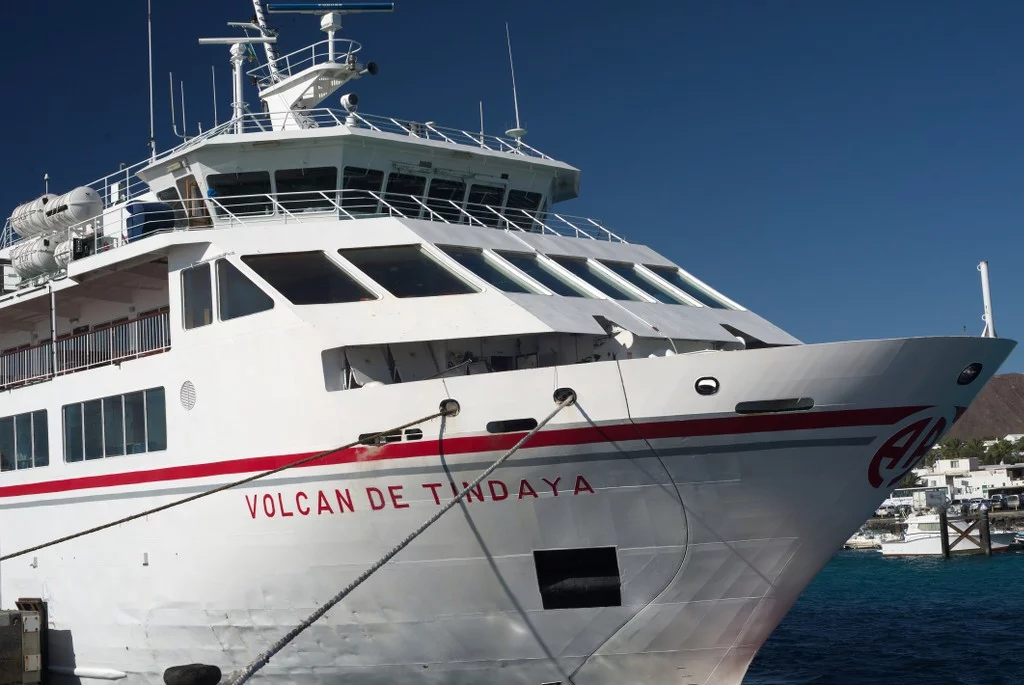
Small Islands The small islands of La Graciosa and Isla de Lobos are also accessible. A ferry leaves from Orzola in the north of the Island for La Graciosa and several excursions provide day-trips to Isla de Lobos (a small island to the north of neighbouring Fuerteventura).
Fuerteventura Fuerteventura is easily accessible by Ferry from Lanzarote and the journey can take as little as twenty minutes. Fred Olsen, Naviera Armas and Lineas Romero all operate ferries on the Playa Blanca – Corralejo (Fuerteventura) route. The Lineas Romero ferries are for foot passengers only.
Click here to compare Ferry Prices
Gran Canaria Naviera Armas operate a ferry between Arreife and Las Palmas, though many opt to make the shorter crossing to Fuerteventura, drive the length of Fuerteventura and use the high-speed ferry crossing from Morro Jable to Las Palmas. Trasmediterranea offer less frequent connections with Tenerife, La Palma, Gran Canaria and Cadiz in mainland Spain.
Flights Binter operate frequent (several times daily) direct flights to Santa Cruz in Tenerife, Tenerife South and to Gran Canaria, from where it is possible to get to all of the other Islands.
Airlines Binter
Ferries Lineas Romero Trasmediterranea Naviera Armas Fred Olsen
Island Information Overview of the Canary Islands Gran Canaria Fuerteventura Tenerife
Further Reading
Leave a reply cancel reply.
Your email address will not be published. Required fields are marked *
Which of the Canary Islands is best for you?

Sep 2, 2021 • 13 min read
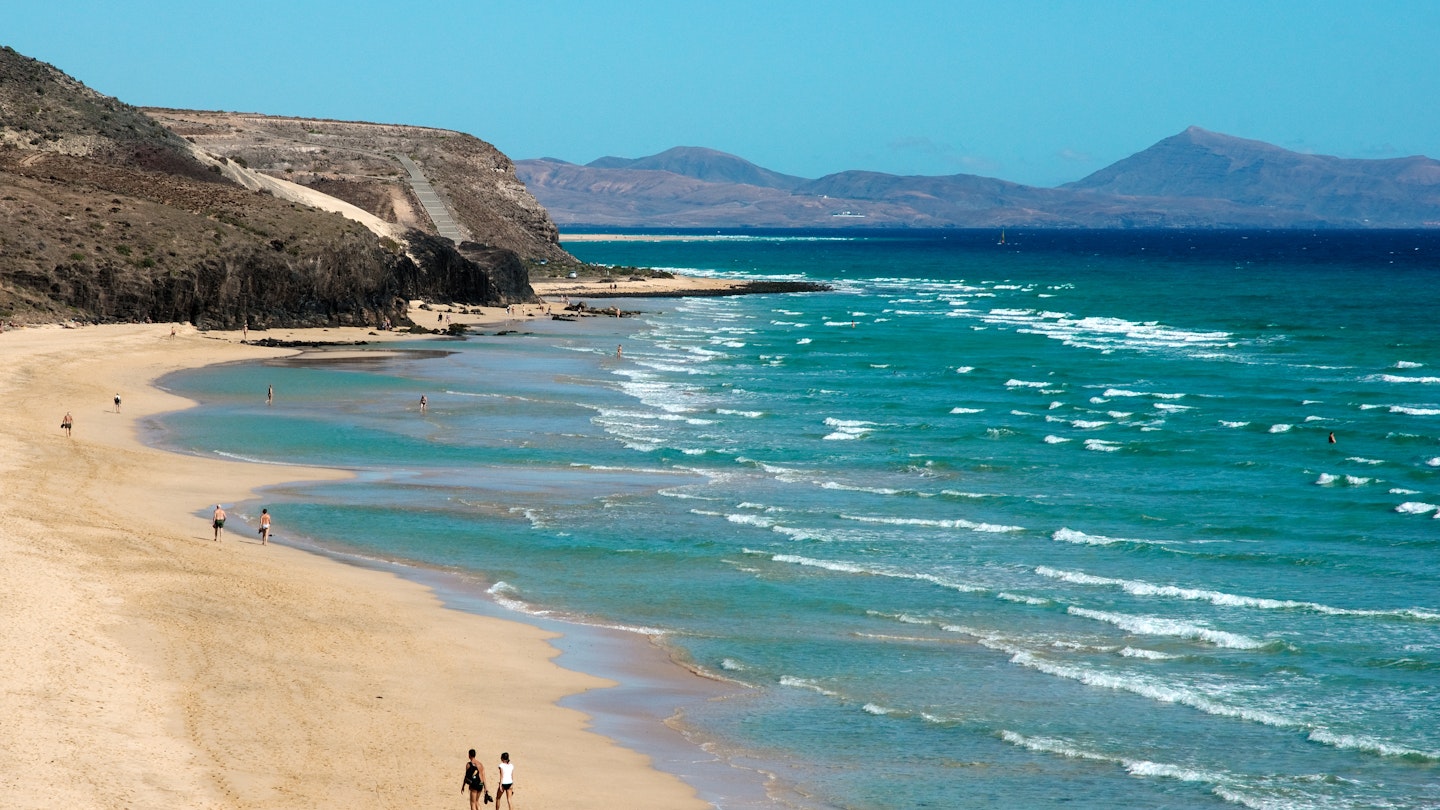
Each of the eight Canary Islands has its own distinct character and appeal for travelers © Andreas Weibel / Getty Images
Eerily beautiful lava-sculpted mountains, rippling sugar-white and bare black-rock beaches, distant villages teetering atop ridges, tumbling pine forests full of churning mists and exhilarating hikes, and plenty of sun-toasted resorts – Spain’s far-flung Canary Islands are deservedly one of Europe’s most popular destinations.
Many travelers become so enamoured with the Canary Islands that they return year after year, often exploring a different island every trip. But where to start? While the eight Canary Islands make up the archipelago west of Morocco’s Atlantic coast, each island has its own distinct charm, character and appeal. No matter your travel style, here’s a guide to finding the Canary Island that's best for you.
Parts of Spain now require a health pass from visitors to enter indoor spaces

Best island for mountains, hiking and food
Beyond the British-geared tourist resorts sprinkled across the island’s south, Spain’s formidable tallest peak – snow-dusted 12,523ft-high El Teide – puts age-old favorite Tenerife on almost every las Canarias itinerary. Combined with the surreal Unesco-listed 73-sq-mile Parque Nacional del Teide, this impossibly spectacular volcanic moonscape serves up some of the most exciting hiking in all of Spain. Only 200 walkers a day can tackle the five-hour ascent to the summit: book ahead online . Across the island, other jaw-droppingly beautiful walks lead past charismatic villages, through perfumed Canarian pine woods or down plunging valleys such as the 4-mile (6.5km) Barranco del Infierno .
And then there’s the blossoming, ever-more sophisticated local food scene. Tenerife is the only Canary island blessed with Michelin stars – six at last count, with temples to haute cuisine running from Martín Berasategui’s two-star, Basque-inspired M.B to the Padrón brothers’ seafood sensation El Rincón de Juan Carlos .
Where to stay on Tenerife
Finding a room is generally not a problem in Santa Cruz and in the north of the island (apart from at Carnaval time), but the same cannot be said for the southern resorts, particularly around Los Cristianos and Playa de las Américas; book in advance when possible. Hotel Alhambra in La Orotava sleeps guests in an art-packed 18th-century manor.
Where to eat on Tenerife
Visitors can ditch the resort buffets in favor of more appealing and imaginative dishes, ranging from traditional Canarian cuisine, typified by robust homestyle cooking, right through to the tantalizing haute cuisine of gastro temples, where innovative chefs serve some fabulously novel fusion combinations. Tenerife's capital city of Santa Cruz de Tenerife hosts an array of outstanding restaurants. Try Guannabi for creatively executed Mediterranean-fusion dishes in a delightfully converted Canarian house.
How to get to Tenerife
Two airports serve Tenerife: Tenerife Sur Airport handles international flights, while almost all inter-island flights (plus a few international and mainland services) use the older and smaller Tenerife Norte Airport. Ferries also travel to Tenerife from the other Canary islands, but flying is the fastest way to travel between the islands, and prices are very competitive.

Gran Canaria
Best island for mountains, history and food.
The most populous among the islands, often-maligned Gran Canaria proves as inspiringly diverse as the Canaries’ deliciously varied cuisine. Swirls of mist-cloaked mountains give way to desert-like fields and lush laurel and pine forests (and, yes, a few packed-out tourist resorts), while intriguing pre-Hispanic sights like Gáldar’s Cueva Pintada conjure a picture of the archipelago’s original inhabitants, the Guanches. Explore further on a twists-and-turns road trip through the island’s high-altitude center, whose beauty and drama peak at top-of-the-world cave-village Artenara, before stocking up on creamy queso de flor (flower cheese) and other local goodies at a farmers’ market. Soak up the distinctive Canarian architecture in soulful capital of Las Palmas de Gran Canaria , Spain’s ninth-largest city.
Where to stay on Gran Canaria
Gran Canaria arguably has the best range of accommodations in the Canaries, depending on whether you want to wake up to sounds of birdsong, the surf or surrounded by the vigor and excitement of a Spanish-mainland-style city. The bright, colorful and welcoming La Ventana Azul hostel is spectacularly located right on the beachfront and has a rooftop terrace and free snorkel rental.
Where to eat on Gran Canaria
The breathtaking topographic disparities and climatic variations, including contrasting humid trade winds and dry desert-air currents, all help to generate a diverse patchwork of agricultural produce. Along with the aquacultural goods on offer, Gran Canaria's pantry is rich and bountiful. Add to that the farmers' markets and fish markets and you will discover a tempting abundance of food choice. You'll find outstanding "eco-fusion" cuisine at Llévame al Huerto .
How to get to Gran Canaria
Gran Canaria Airport has direct flights to destinations throughout Europe, as well as all of the Canary Islands. Two passenger harbors on Gran Canaria offer inter-island ferries.
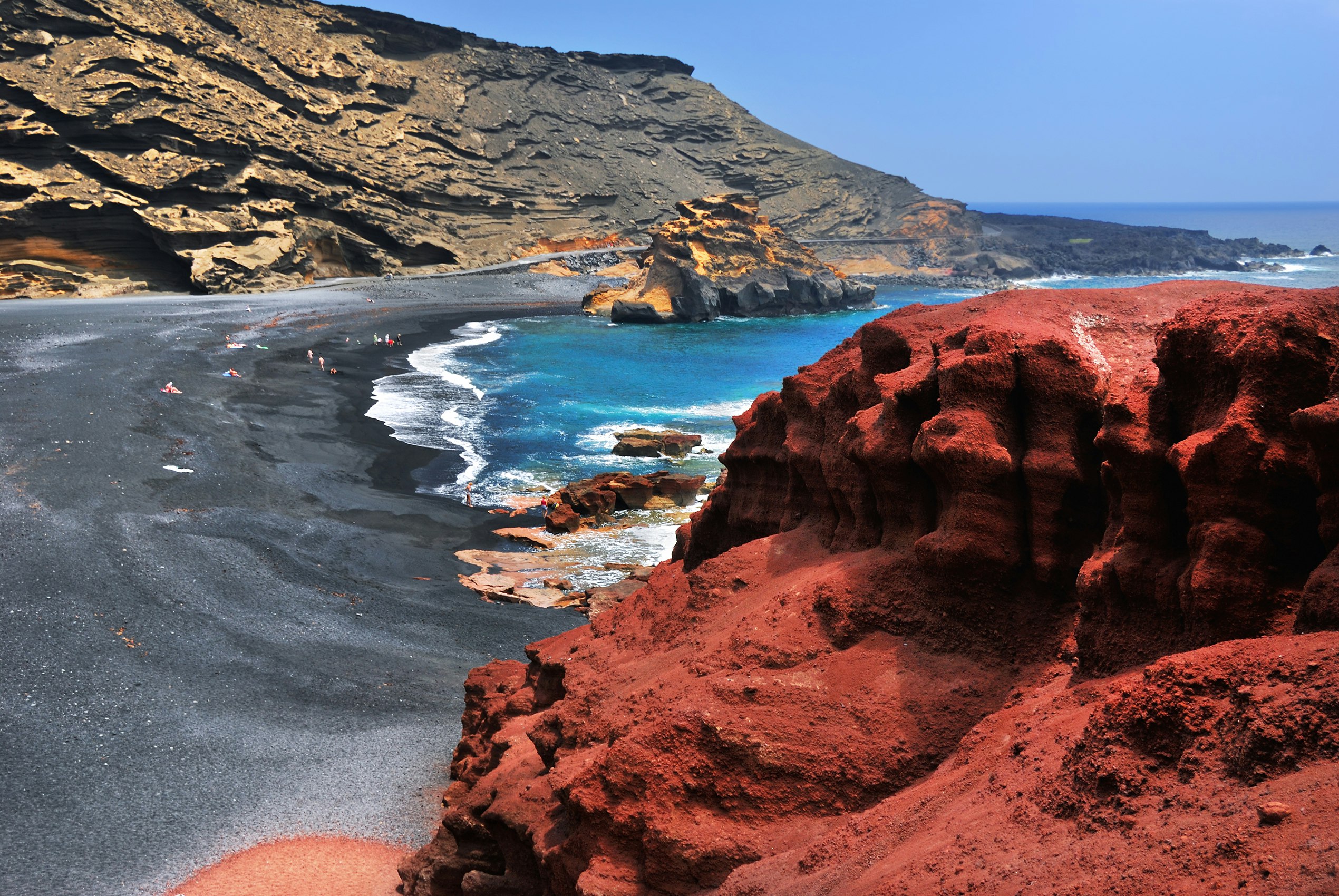
Best island for landscapes, art and architecture
An entrancing world of brooding volcanic cones, glinting black-pebble beaches, thundering Atlantic surf and the odd palm-spangled valley, Lanzarote feels like a giant color-shifting natural canvas. So it’s no surprise that the island is tightly tied to 20th-century artist and environmental campaigner César Manrique, whose impossible-to-miss influence you’ll uncover around every corner – from the whitewashed, sky-blue-windowed homes of mellow coastal villages like La Caleta de Famara, Arrieta and El Golfo to the inimitable lava-field house at the Fundación César Manrique . At the heart of it all lies the 20-sq-mile Parque Nacional de Timanfaya. Savor this otherworldly volcanic landscape by scrambling up the sprawling Caldera Blanca on a 5.5-mile (9km) hike at the park’s edge.
Where to stay on Lanzarote
Much of Lanzarote’s accommodations are in self-catering apartments, private villas and sprawling resorts, which you'll find in Puerto del Carmen, Costa Teguise and Playa Blanca. That said, there's a growing number of wonderful independent hotels dotted around, especially in the island's wine-growing region and northern reaches – and places like these play a key role in giving travelers an insight into the fascinating Lanzarote that lies beyond its beach resorts. Artfully reimagined bodega Buenavista Lanzarote offers five eco-conscious "country suites" amid volcanic vineyards.
Where to eat on Lanzarote
Canarian cuisine stands strong on Lanzarote, but with its own delicious twists, including local goat's cheese, roasted meats and three styles of the much-loved mojo (spicy sauce made from coriander, basil or red chili peppers). There are wonderful restaurants all over the island (both local-style and creatively international), with the best food found well beyond the resorts. Canarian-international La Cantina is a beloved dining spot in delightful Teguise.
How to get to Lanzarote
Aeropuerto César Manrique–Lanzarote has an array of flights to and from Europe, as well as Gran Canaria, Tenerife and La Palma. Other Canary islands are accessible with stopovers in Gran Canaria and Tenerife. From Arrecife's Puerto de los Mármoles, ferries connect with Gran Canaria and on to Tenerife and La Palma. From Playa Blanca, there are regular ferries to Corralejo on Fuerteventura.

Fuerteventura
Best island for beaches and water sports.
A Unesco Biosphere Reserve since 2009, the second-largest Canary island (after Tenerife) lures visitors with its dazzling beaches, year-round sunny climate and raw lunar-like beauty. Wind-lashed and evocatively arid, Fuerteventura is graced by the archipelago’s dreamiest sands: the honey-colored dunes of the protected Parque Natural de Corralejo , surf-mad El Cotillo (originally a fishing village) and blissfully undeveloped pale-gold Playa de Cofete on the island’s southern tip. You can go surfing, sailing, windsurfing, kitesurfing and diving (even freediving), and venture out on some excellent hikes, including around the Isla de Lobos nature reserve.
Where to stay on Fuerteventura
Corralejo and Morro Jable have the most beds, although casas rurales (village or farmstead accommodations) are increasingly sprouting up in the rural interior. Chic minimalist Avanti makes a stylish adults-only base in Corralejo.
Where to eat on Fuerteventura
More than any other Canary island, Fuerteventura’s traditional cuisine is simple and essentially the result of poverty, but is today marked by the quality and freshness of its ingredients. Restaurante Avenida rustles up classic Canarian cuisine.
How to get to Fuerteventura
Fuerteventura airport has direct flights to Gran Canaria and Tenerife, from where you can fly on to the other islands. Ferries depart for Lanzarote, Gran Canaria and Tenerife.
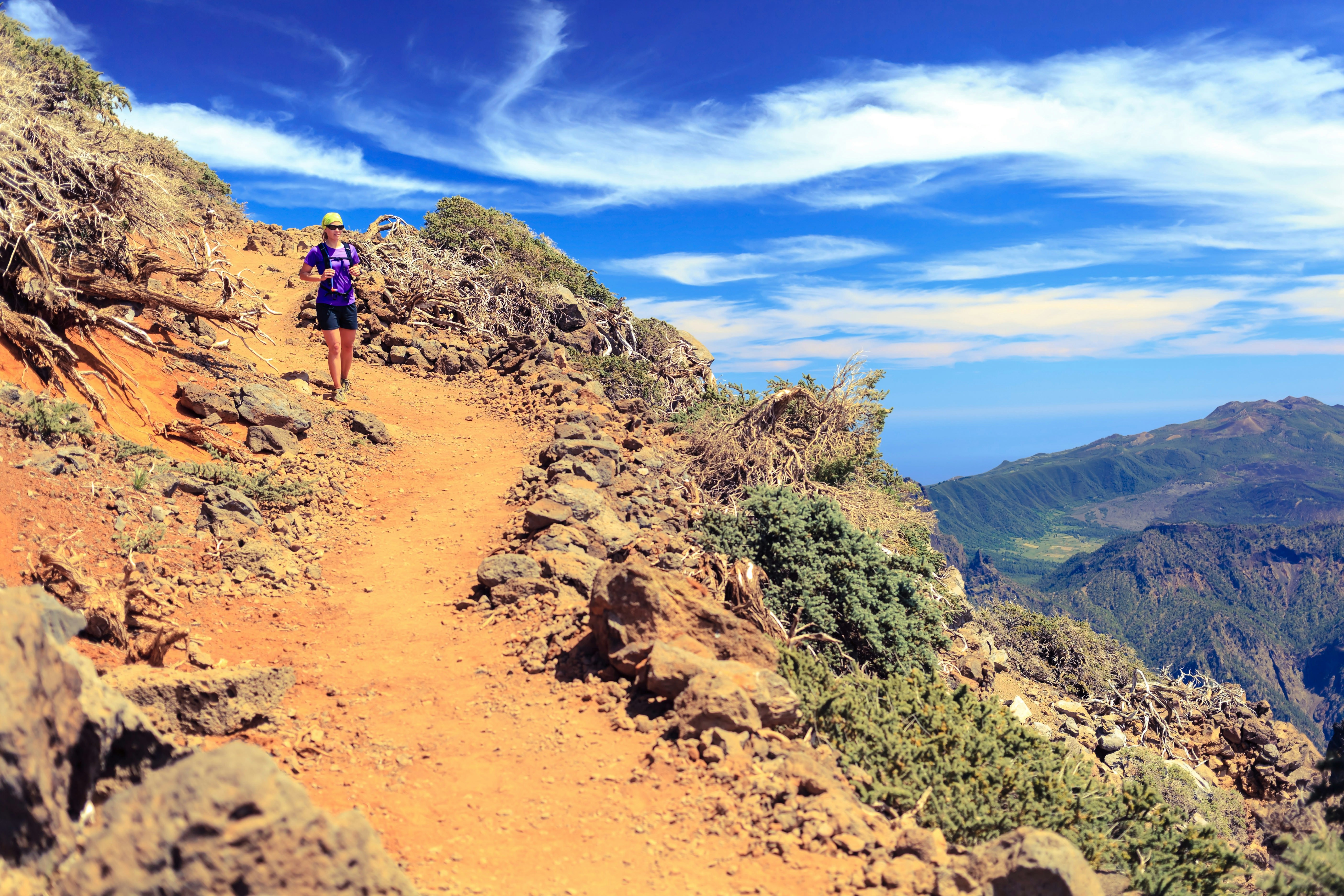
Best island for nature and hiking
It’s impossible not to fall for gorgeously green, refreshingly under-touristed La Palma , with its hushed pine groves, steep rainforested hills and architecturally rich capital Santa Cruz de la Palma , filled with graceful 16th-century mansions. Around 528 miles (850km) of walking routes meander across the island, the most thrilling of them centered on the unmissable 18-sq-mile Parque Nacional de la Caldera de Taburiente, whose 5-mile-wide depression was created by a volcano collapsing in on itself. The 7-mile (11.4km) round-trip climb to the 6082ft-high summit of Pico de Bejenado is a view-laden showstopper of scattered pines, sharp ridges and mysterious petroglyphs.
Where to stay on La Palma
La Palma has an appealing choice of accommodations suiting all tastes but without the bloated beach resorts on other islands. If you want to live more like a local or in a rural villa with a swimming pool, choose one of the casas rurales for rent across the island. Beamed ceilings set the boutiquey scene at Santa Cruz’ intimate Hotel San Telmo .
Where to eat on La Palma
The diverse landscapes of "La Isla Bonita" are set to an equally varied and mouthwatering culinary backdrop. Santa Cruz de la Palma offers a tempting range of international and local cuisine, rounded off by a superb cafe or two. Elsewhere, the island is speckled with culinary choice, from handsomely located tapas restaurants in El Paso to select Canarian in the volcanic south or excellent seafood restaurants overlooking dazzling views of the sapphire sea. Book ahead to sample the fresh-produce cooking at locally loved restaurant Enriclai .
How to get to La Palma
La Palma’s airport keeps the island well connected to the rest of the archipelago, with several flights daily to Tenerife and Gran Canaria, and occasional direct flights to some of the other islands. There are flights to La Palma from European destinations such as London, Manchester, Frankfurt, Paris, Madrid, Amsterdam, Brussels and Barcelona. Ferries head to Tenerife, La Gomera and Gran Canaria.
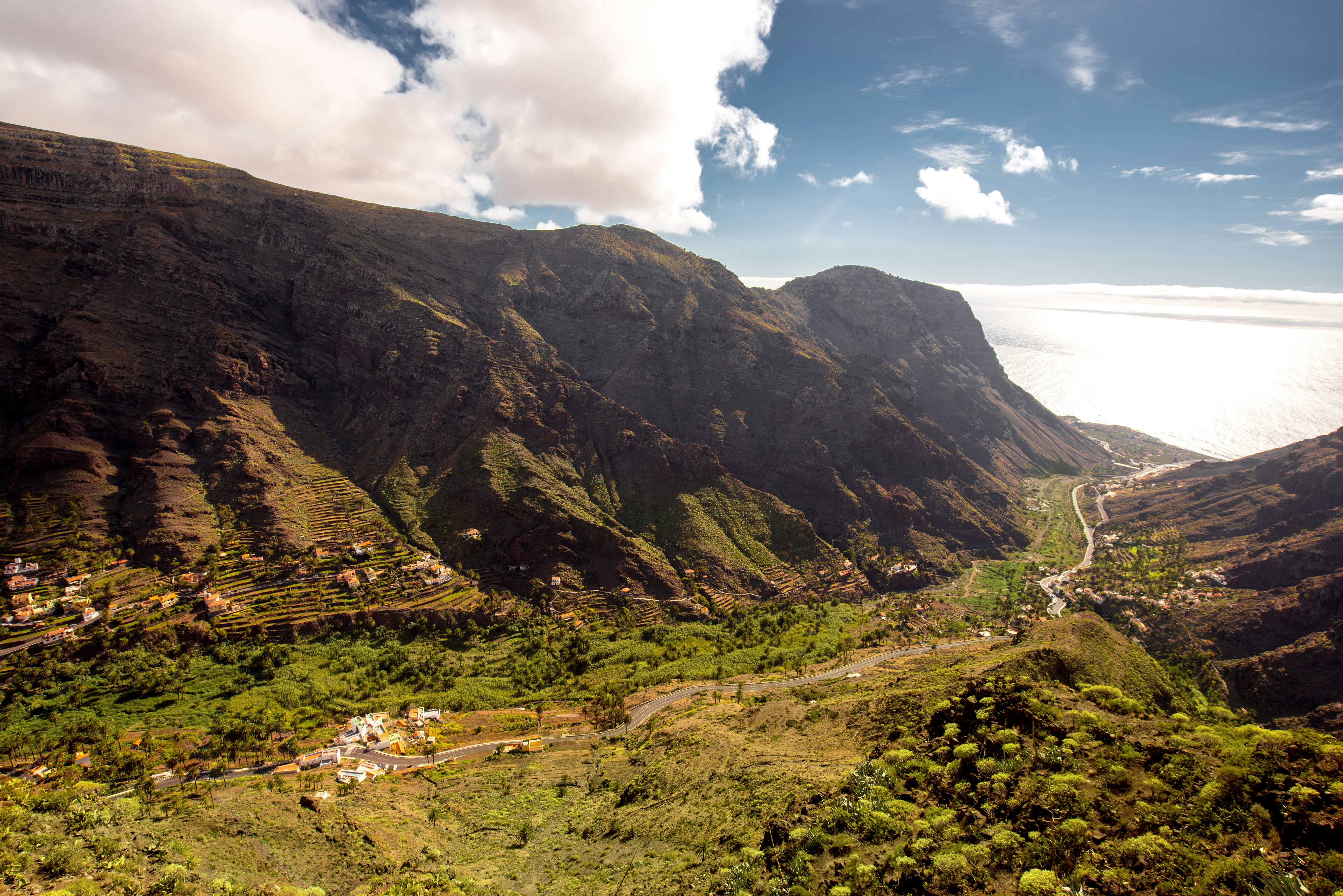
Best island for hiking
Cascading down thickly forested hillsides and precipitous valleys from the wind-battered 4878ft-high Alto de Garajonay, bohemian La Gomera is a hiker’s dream. The fairytale-like 15-sq-mile Parque Nacional de Garajonay at the heart of the island bursts with trails tracking through misty ancestral laurisilva forest (try the 6.5-mile downhill Alto–Hermigua hike ), while elsewhere, thrilling paths cling to sheer valley walls or meander along the blackened volcanic coastline. When you’re all hiked out, stroll the pastel-painted streets of sea-hugging capital San Sebastián de la Gomera and dig into hearty local specialities like potaje de berros (watercress stew), miel de palma (palm honey) or fresh goat’s cheese.
Where to stay on La Gomera
The island has, so far, kept grand-scale tourism at bay, and most lodging is in small rural hotels, family-run pensiones, refurbished farmhouses and self-catering apartments. There are also plenty of appealing casas rurales , many of which were abandoned by emigrants and have since been refurbished for tourists. La Gomera's top hotel is the Parador de la Gomera , in the style of a 15th-century Canarian mansion.
Where to eat on La Gomera
La Gomera's cuisine is classic, simple Canarian, starring fresh seafood, meaty mains, hearty stews such as potaje de berros (watercress stew) and, of course, patatas arrugadas (wrinkly potatoes) with lashings of mojo . The island's international community has introduced a few other flavors too, especially in Valle Gran Rey, which hosts some good fusion and vegetarian restaurants alongside its traditional offerings. Don’t miss the outstanding home cooking at much-loved restaurant Casa Efigenia .
How to get to La Gomera
Aeropuerto de La Gomera has several daily flights to Tenerife. Ferries from Tenerife and La Palma arrive into San Sebastián’s busy port. The vast majority of people arrive here on day trips from Los Cristianos, Tenerife.

Best island for diving, hiking and escaping it all
Those who make it as far as the Canaries’ westernmost island quickly realize they’re onto something special. Ringed by glittering natural pools and impenetrable volcanic cliffs, El Hierro has been a protected Unesco Geopark since 2014, and plans are under way to transform it into the world’s first energy-self-sufficient island. Here, on what feels like the edge of the earth, quiet hiking trails such as the historic 16-mile (27km) Camino de la Virgen weave through flower-filled fields and scented pine forests. Other paths, like the spine-tingling 2.7-mile (4.4km) Camino de Jinama , traverse sheer cliff faces above lava-hewn landscapes. Meanwhile, the warm, glass-clear Atlantic waters off El Hierro’s craggy coastline unveil the finest diving in the Canaries, especially around the tranquil Mar de las Calmas near sunny La Restinga in the south.
Where to stay on El Hierro
El Hierro's accommodation scene isn't the most exciting in the Canary Islands, but you aren't here for flashy resorts. The best places to stay are charming rural hotels and private casas rurales , and there are plenty of budget-friendly self-catering apartments across the island. Stay at boho-rustic converted bodega El Sitio , which hosts yoga retreats.
Where to eat on El Hierro
Food on El Hierro might be unpretentious, but it's delicious, much of it produced on the island or off its coasts. The lack of tourist traffic ensures restaurants are catering mainly to a local clientele, which means higher standards. Dine at the elegant Restaurante Mirador de la Peña , designed by César Manrique.
How to get to El Hierro
El Hierro's tiny airport has just a few flights to Tenerife and Gran Canaria, where you can take onward transport to the rest of the archipelago. Naviera Armas has one daily sailing Sunday to Friday between El Hierro's Puerto de la Estaca and Tenerife's Los Cristianos.

La Graciosa
Best island for beaches and going back to basics.
Named the eighth Canary Island in 2018, serene sand-swept La Graciosa lies just a half-hour boat ride north of Lanzarote. On this low-lying beauty of an island, wild honey-gold beaches wrap around scorched volcanic cones, and the only way to explore is on foot, by bicycle or by rented jeep. Most visitors arrive on day trips from Órzola on Lanzarote, but if you stay a few nights on La Graciosa, you’ll feel worlds away from the Canary Islands’ buzz. Hike or bike over to remote Playa de las Conchas or secluded Playa Francesa before settling in for a seafood feast in low-key "capital" Caleta de Sebo.
Where to stay on Isla Graciosa
Accommodations on Isla Graciosa are mostly in simple, comfortable pensiones or private apartments. Pensión Enriqueta has great-value, no-fuss rooms and a lively restaurant in Caleta de Sebo.
Where to eat on Isla Graciosa
You'll enjoy excellent fresh seafood at most of Caleta de Sebo's mellow restaurants, including Casa Margucha and El Veril .
How to get to Isla Graciosa
Biosfera Express and Líneas Romero run ferries between Órzola and Caleta de Sebo.
Best time to visit the Canary Islands
High season: december to april and july to august.
- Coincides with Christmas, Carnaval season and Easter.
- Accommodation prices are highest in January and February.
- Midsummer, especially August, is vacation time on the Spanish mainland, so expect more visitors.
- July and August are the hottest months of the year, but temperatures rarely climb higher than 100°F (38°C).
- Rain is possible from January to March, especially in the mountains.
Shoulder Season: May to June and September to November
- Temperatures average around 82°F (28°C), and nights are cooler.
- Fewer tourists visit in the fall overall.
- Higher altitudes, particularly in Gran Canaria, Tenerife and El Hierro, can be far cooler with some fog.
This article was originally published in August 2019.
You might also like: Hidden Tenerife: best places to avoid the crowd Hiking in Gran Canaria: the island’s best walks The unsung Canary Island: exploring La Gomera
This article was first published August 2019 and updated September 2021
Explore related stories
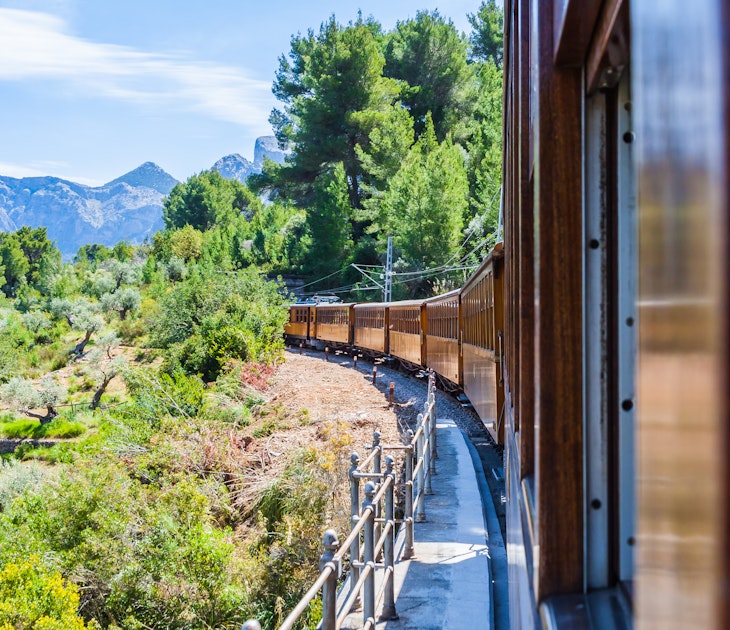
Train Travel
Apr 3, 2024 • 15 min read
The trains in Spain are exceptional and far-reaching.

Mar 14, 2024 • 16 min read
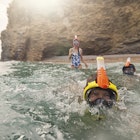
Mar 7, 2024 • 10 min read

Feb 1, 2024 • 14 min read

Jan 31, 2024 • 6 min read
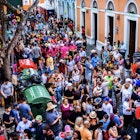
Jan 26, 2024 • 6 min read
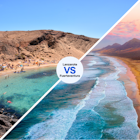
Dec 11, 2023 • 6 min read

Oct 25, 2023 • 7 min read

Sep 29, 2023 • 9 min read

Jul 26, 2023 • 6 min read

Live it up, Las Palmas!
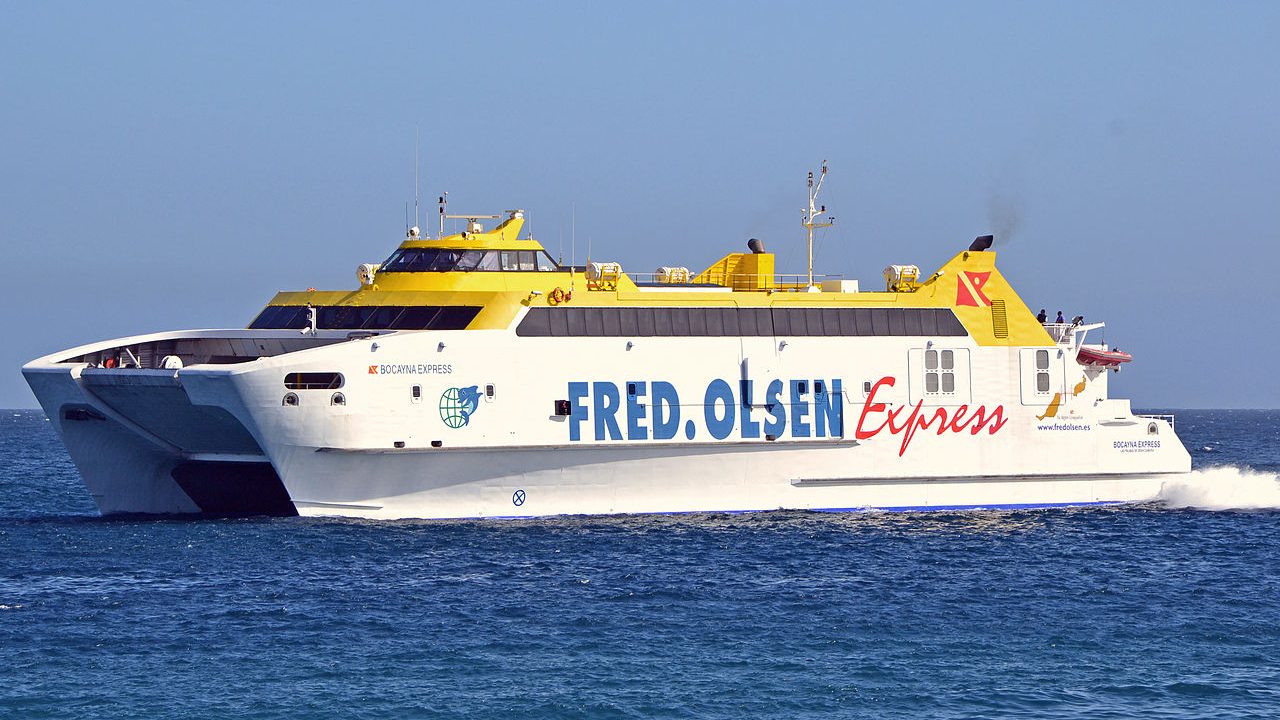
Inter-island travel Canary Islands
The main/official Canary Islands are Tenerife, Fuerteventura, Gran Canaria, Lanzarote, La Palma, La Gomera, El Hierro and La Graciosa, plus there are more islands like Alegranza, Isla de Lobos, Montaña Clara, Roque del Oeste and Roque del Este. Enough to explore! There are two ways to travel between the islands; ferry or flight. Flights between…
The main/official Canary Islands are Tenerife, Fuerteventura, Gran Canaria, Lanzarote, La Palma, La Gomera, El Hierro and La Graciosa, plus there are more islands like Alegranza, Isla de Lobos, Montaña Clara, Roque del Oeste and Roque del Este. Enough to explore!
There are two ways to travel between the islands; ferry or flight.
Flights between the Canary Islands
The two main airlines on the Canary Islands are Binter Canarias and CanaryFly .
Binter Canarias has been operating since 2002 and flies to/from El Hierro, Fuerteventura, Gran Canaria, La Gomera, Lanzarote, La Palma, Tenerife Norte and Tenerife Sur. They also have some destinations on the peninsula, plus flights to some airports in France, Italy, Portugal and four destination in the continent of Africa.
CanaryFly started operating in 2008 and offers only inter-island flights.
Both airlines have a good reputation and normally it’s just a matter of comparing prices to choose one airline over the other for inter-island travel. They often have discounts and residents even get a 75% discount on flights between the island and flights to the peninsula.
Did you know that you can fly (direct!) to 126 destinations from Gran Canaria? Check the national and international destinations here .
Ferries between the Canary Islands
Another option for inter island travel between the Canary Islands, is to take the ferry. There are four companies that you can book; all other ones are intermediairs.
Residents of the Canary Islands get a 75% discount on the ferry.
Fred Olsen is probably the most known and has the most connections between the islands and between the peninsula. The ferry is usually more expensive than a flight, but is more convenient if you want to bring a car, bicycle or pet. Check their full schedule here .
Naviera Armas is another big ferry company, with ferries between the Canary Islands and the peninsula. Check their full schedule here .
Lineas Romero is a smaller ferry company and only offers ferries between Lanzarote – La Graciosa and between Lanzarote – Fuerteventura. For bookings and more info check their website .
Biosfera Express is the smallest company and only offers ferries between Lanzarote and La Graciosa for fixed prices. You can book your ferry ticket here .
Follow @liveituplaspalmas on Instagram
Are You A Remote Worker, Local Professional, Immigrant, Digital Nomad Or Expat In Gran Canaria?
Or do you simply want to connect with an awesome international community? Join here! Besides a welcoming community with lots of information and events, you’ll also get 10% discount on surf lessons , 10% discount on diving and access to more exclusive deals !
Join us Tuesday’s at Bar San Remo for our weekly community meetup!

Eurofins in Gran Canaria: For Clinical Analysis and Blood Tests

Getting The Best Sports Massage In Las Palmas de Gran Canaria

Playing Beach Tennis In Las Palmas de Gran Canaria

Does Gran Canaria Have Daylight Saving Time?
Discover more from live it up, las palmas.
Subscribe now to keep reading and get access to the full archive.
Type your email…
Continue reading
- Things to do
Explore > Destinations > Spain > What to Know for Visiting the Canary Islands
What to Know for Visiting the Canary Islands
Located off the coast of northwestern Africa, the Canary Islands are a tropical paradise and an excellent destination for beachgoers and adventurers. Whether you want a luxurious beach retreat or an adventurous outing, here are some travel tips for traveling in the Canary Islands and advice to make the most of your visit.
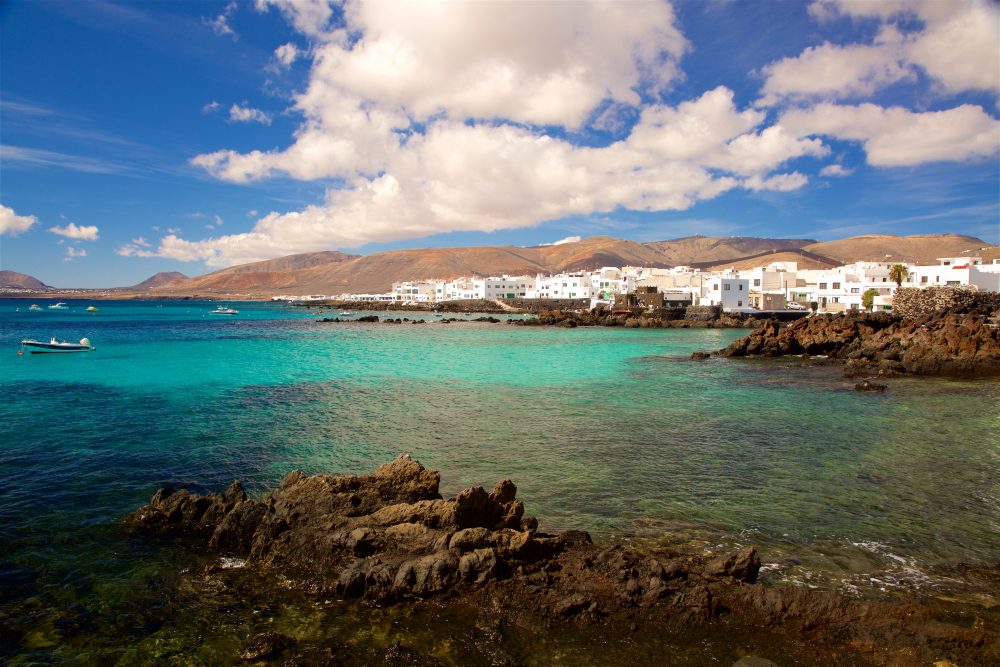
The height of the tourist season in the Canary Islands is during the winter and summer. Many people from cold climates travel in winter for an island retreat, and summer is a popular time for families. What to know before you go is to travel during the spring months of March to May and fall months of September to November. Traveling during these months will give you the same pleasant, sunny weather and warmth as the peak season, as well as lower travel rates and fewer crowds.
How to Get Around
All of the Canary Islands have airports, but if you’re coming from the U.S., you’ll have to take a flight to a European city and connect to the islands. Once you arrive on the Canary Islands, you’ll have several options for how to get around. The islands are connected by inter-island ferry services, and you can get around the islands themselves with buses or taxis. Many travelers prefer to rent a car to have the freedom to tour and explore on their own time.
Which Island to Visit
The Canary Islands vary significantly, so it’s good to know before you go and plan which island will have the best experiences for your interests. If you’re going to spend your time on the beach or enjoying watersports, Fuerteventura is the best option, while Gran Canaria and Las Palmas offer diverse landscapes of rainforests, beaches, and mountains for outdoor enthusiasts. If you want a more cultured experience, Lanzarote is the best choice. If you want hiking and remote scenery, El Hierro and La Gomera are perfect. For a mix of everything, visit Tenerife and its beautiful beaches .
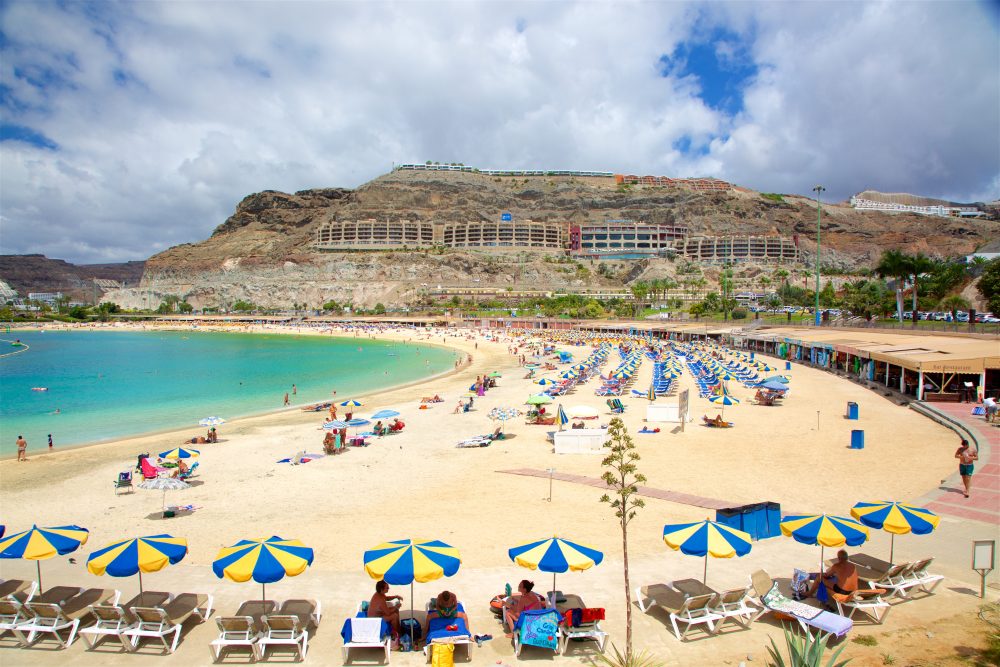
What to See
Depending on where you choose to stay during your trip, the Canary Islands boast an array of must-see sights and attractions. Some of the highlights you’ll wish you knew include the Teide National Park and its massive volcano, Timanfaya National Park , Caldera de Taburiente National Park, Siam Park , Playa Blanco, and the Natural Dune Reserve of Maspalomas. You could also see the botanic park, aviary, and dolphinarium of Palmitos Park, the Cactus Garden, and the Pyramids of Güímar, an ethnology park with stone pyramids.
What to Pack
The average temperature of the Canary islands is 75°F year-round, though some areas can get cooler or hotter. When you’re packing for your trip, it’s good to anticipate weather changes and bring plenty of clothing options, such as a light jacket or sweater, closed-toe shoes that are comfortable to walk in, and hats to protect yourself from the sun. You’ll also want to bring a swimsuit, shorts, short-sleeved shirts, and sandals for hot days. You may want to bring a small backpack or a large tote bag to carry extra layers, water, and other supplies if you plan to hike or spend a long day at the beach.
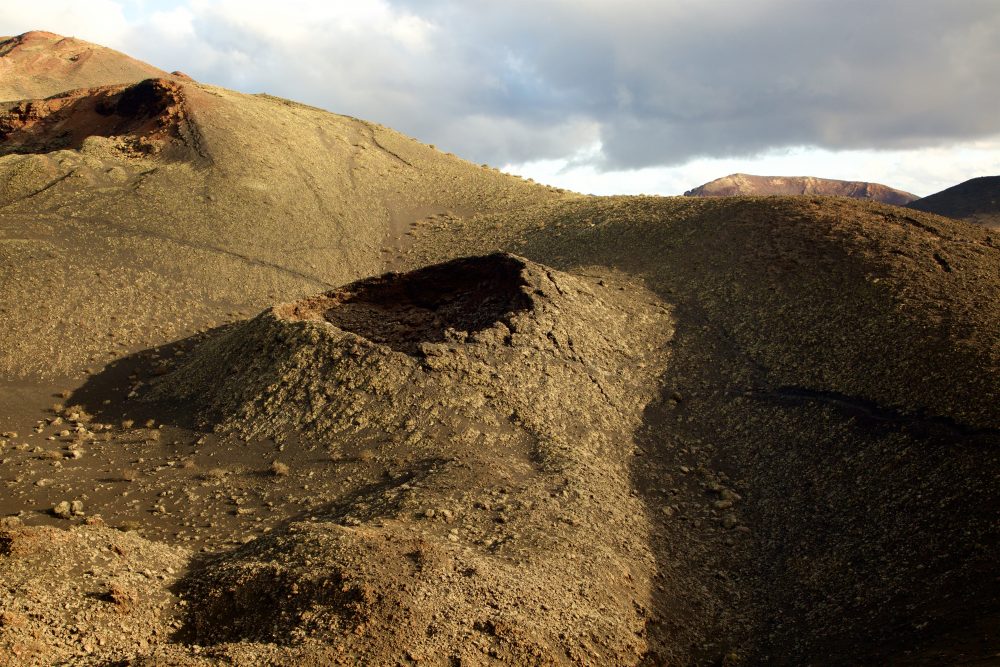
Understand the Local Culture and Customs
The Canary Islands are part of Spain, so many of the locals speak Spanish. You’ll also find some people speak the native language, Silbo. The culture varies from island to island, and the island people are set apart from mainland Spain by Latin American influences. Most places accept credit or debit cards and euros. Carnival is a big event in the Canary Islands, much like in Brazil, and takes place in February in Tenerife. If you plan on going to Carnival, it’s best to book well in advance and plan your trip early.
Safety Tips
The Canary Islands are a safe travel destination, but it’s best to exercise caution when traveling. Popular tourist areas are the most likely places you’ll encounter petty theft, so be sure to keep your valuables with your or safely locked away in the hotel safe. Try not to bring your valuables to the beach, and if you must, be sure they’re always attended. If you’re going to be spending time on the beach or in the parks, use a lot of sunscreen to avoid sunburn and drink plenty of water.
What to Eat
The Canary Islands have restaurants that cater to virtually every cuisine and budget. If you want to experience the local flavors and culinary culture of the islands, you should try the seafood. Many local restaurants serve delicious, fresh-caught seafood-based dishes like sea bream and parrotfish with locally grown vegetables or potatoes with spicy pepper sauce. You should also sample some of the island’s local wines, which are made from grapes grown and cultivated in volcanic ash soil for a unique flavor.
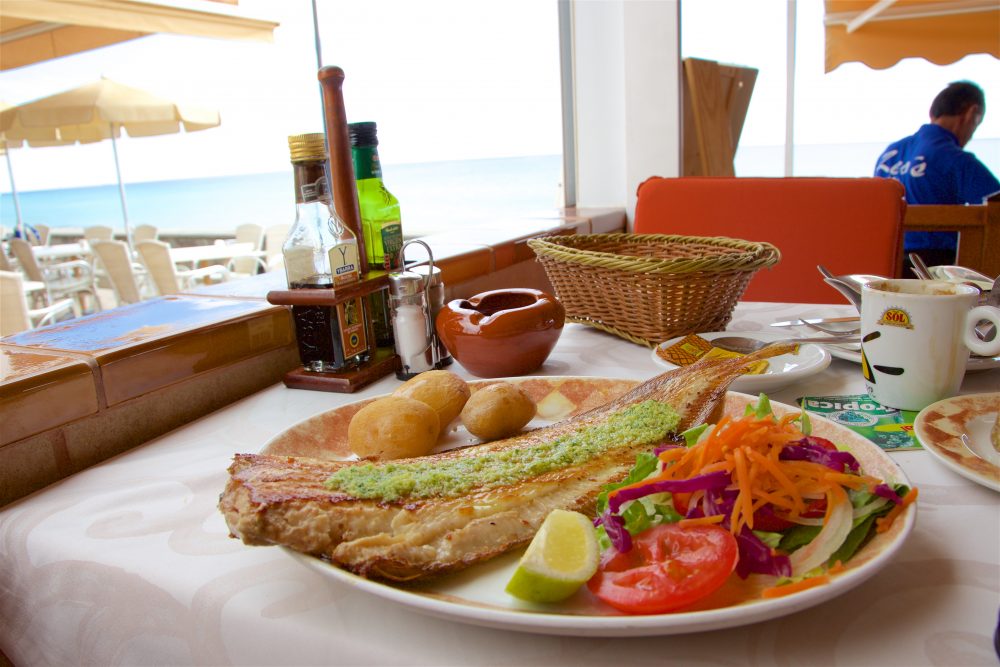
Know Local Restaurant Etiquette
Though it’s appreciated, tipping is not required in the Canary Islands. Members of the wait staff receive full wages and don’t rely on tips. Spanish meals tend to last longer than they do in the U.S. as well, so the wait staff won’t rush you. Mealtimes are also different, so it’s good to know before you go. Lunch usually takes place between 12 p.m. and 4 p.m., with a long break until around 7 p.m. for dinner. Many locals eat lunch later in the afternoon and don’t have dinner until after 9 p.m.
Traveling to the Canary Islands on a Budget
If you’re traveling to the Canary Islands on a budget, one of the best travel tips is to choose one island destination and spend your time there. Ferries and planes can add up, especially if you’re trying to pack all of the islands into one trip. It’s also best to travel during the shoulder or off-season and book early to get the best rates on travel and accommodations. If you have a lot of things you want to see during your trip, you can book a tour or package to save.
From its world-class resorts and pristine beaches to its fascinating attractions and diverse landscapes, there’s something for everyone in the Canary Islands. Now that you have all the essential information before visiting the Canary Islands, you’re ready to plan your trip. Visit Expedia to check out deals on Canary Islands vacations and prepare for the time of your life!
More Articles With Destinations
Finding wheelchair-accessible things to do in London can often be a tricky task that require extra research and planning but a new app will help you find all the best accessible attractions and restaurants.
Join a Disney podcaster and mega fan for some insider tips.
He's analyzed this year's forecast, researched the historical likelihood of Christmas Day snow, and stirred in a bit of weatherman’s intuition to come up with his holiday list.
UAE's capital is an ultra-modern city where big desert, epic adventure, and next-level luxury come together to offer the perfect getaway.

A COMPLETE TRAVEL GUIDE TO THE CANARY ISLANDS
Are you visiting the Canary Islands soon? You need some help to plan your trip? We spent 3 months traveling through the Canary Islands and we prepared this comprehensive travel guide for you!
With its stunning beaches , incredible landscapes, fantastic traditions and delicious food, the Canary Islands is a dream destination in Europe. In this post we will share useful tips for traveling to the Canary Islands.

The Canary Islands are composed of 7 unique islands . The best known and most visited are Lanzarote (our favorite one…) and Tenerife . However each island has something special to offer. To know more about each island you can read this post .
1. Why traveling to the the Canary Islands?

When we started our trip to the Canary Islands , we didn’t know what to expect. However, during our journey we were amazed by the beauty and diversity of landscapes in the Canary Islands.
Just to give you some examples, you can see a desert in Maspalomas in Gran Canaria , you can reach the highest mountain in Spain at Mount Teide , Tenerife . You can also visit amazing beaches which will make you feel at the end of the world such as Cofete in Fuerteventura . And of course Lanzarote will make feel that you landed on the moon . Make sure to visit Timanfaya National Park in Lanzarote , one of the most incredible things to see in the Canary Islands!
The Canary Islands is a destination for everyone. So if you are more of a night owl, there is a vibrant nightlife in the Canary Islands! The best places to party are Playa del Inglés in Gran Canaria , or Corralejo in Fuerteventura .
- 10 BEST REASONS TO VISIT LANZAROTE
10 REASONS WHY YOU SHOULD VISIT FUERTEVENTURA
- TOP 8 REASONS TO VISIT GRAN CANARIA
- WHY VISITING TENERIFE?
2. Which island to visit in the Canary Islands?
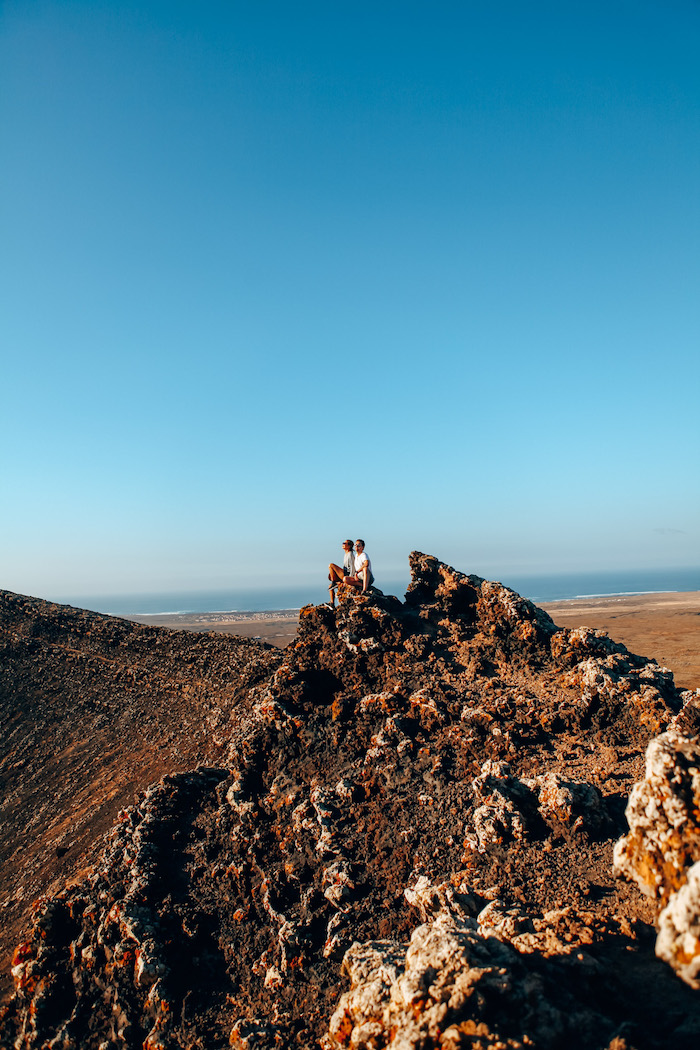
Whether you want to enjoy the beach, or need some adventures, or want some great food there is something for everyone in the Canary Islands.
If you like to party , prioritise Gran Canaria . On top of having a great nightlife , Gran Canaria is also one of the most diverse islands in the Canary. Hence, you will be able to combine excursion during the day and partying at night! Here are the 20 best things to visit in Gran Canaria.
If you like hiking , then without a doubt Tenerife will be the best island to visit. Indeed, Tenerife is home to mount Teide the highest mountain in Spain! It is one of the most visited natural park in the whole of Europe! Full guide here to climb to the summit (it’s not as hard as you would imagine…)
If you want a complete change of landscape, then Lanzarote is the one! Lanzarote is a perfect place to feel the volcanic power of the Canary Islands, some places will make you feel on the moon.
For those you like water-sports such as surfing or kitesurfing , then the best island for that would be Fuerteventura! Here we listed the best outdoor activities in Fuerteventura and here the best spots for surfing in the Canary Islands .
If you want something more calm and off the beaten track, head to La Gomera, La Palma or El Hierro. Those 3 islands are the wildest amongst all of the Canary Islands .
READ: WHICH ONE IS THE BEST CANARY ISLAND TO VISIT?
3. When is the best time to visit the Canary Islands?

The Canary Islands benefit from a very unique climate which makes some say that is an eternal spring . Indeed the climate is good all year round and doesn’t change much throughout the year.
However some months are a bit more rainy than others… To visit the Canary Islands in the most optimal conditions, it is generally preferable to travel during the months of May to November . Most likely you will never have to deal with rain…
In the middle of winter, the Canary Islands will be a popular refuge for Europeans escaping cold temperature in the mainland. During this period, some rainfall can be observed, but the temperature rarely drops below 20°C. In terms of crowds, the most popular periods are therefore the months of July and August, but also the winter months and January in particular.
- WHEN IS THE BEST TIME TO VISIT THE CANARY ISLANDS?
- BEST TIME OF THE YEAR TO VISIT LANZAROTE
- BEST MONTHS TO VISIT FUERTEVENTURA
- WHEN VISITING TENERIFE
- BEST TIME TO VISIT GRAN CANARIA
4. What budget should you plan to visit the Canary Islands?

To visit the Canary Islands without too much compromise, it is important to talk about the budget. This essential point of travel guides is always a sensitive aspect due to the volatility of prices and the countless parameters that influence them.
With regard to the Canary Islands, you must first know that the notions of high, low and medium season are essential. If you are traveling during the Christmas holidays or the months of July and August, expect to see prices skyrocket . So book well in advance!
You should also know that at the same time, the islands of El Hierro or La Gomera are much cheaper than Tenerife and Gran Canaria, for example.
In terms of accommodation and in general, you can find everything. From the small youth hostel at 20 euros per night to the most luxury hotels at 200 euros per night. What we found very expensive is eating in restaurants . A paella for 2 with 2 glasses of Sangria, would easily cost us 50 EUR… As we were traveling for 3 months, we decided to eat most of the time in our apartment. This helped our budget considerably!
Also remember to include car rental, which will amount to around 30 or 40 euros per day with decreasing rates if you opt for longer rental periods and of course depending on the type of car you rent. As for us we always rented a Fiat 500, which is generally the cheapest model. We loved it, except in Fuerteventura where the roads can be very bumpy. More on that here .
5. How to get to the Canary Islands from the rest of Europe?

By plane is obviously the fastest and cheapest way to get to the Canary Islands. There are many connections from the major cities in Europe. The best company to get to the Canary Islands , is Easy Jet. Remember that the earlier you book, the better fares you will get, which is absolutely essential if you choose to travel during the busy periods mentioned above.
However, there is a more adventurous way to get to the Canary Islands if you have sufficient time. You can take your car and drive down to the south of Spain. The cities of Cadiz or Huelva allow you to reach the islands of Las Palmas or Gran Canaria by ferry ! The crossing lasts between 30 and 40 hours depending on the weather conditions.
We didn’t know about it, until we saw cars with Swiss plates or German plates driving in the Canary Islands. We fell that this was a fantastic way to travel to the Canary Islands. And all islands are connected by ferry which makes it super easy to travel with your own car. Awesome, isn’t it?
If that’s an option for you, check out Direct Ferries to book your ride.
6. How to get around the Canary Islands?

Once you reach the Canary Islands, it is highly recommended to rent a car . To get the cheaper rate we used Rentalcars.com . Check it out here for the best deals.
Taking a taxi is also possible, however you will have less freedom to travel or take your time to visit certain sights. Especially for those who want to go hiking… There are also bus lines, but they will be relatively limited once you get off the beaten track. Finally, cycling can also be a good way to discover the Canary Islands .
If you want to visit multiple islands while you are in the Canaries, which we recommend, then using the ferry would be the best way . You can book all your ferry rides here .
7. Best traditional dishes in the Canary Islands?

Visiting the Canary Islands without eating a potato dish is practically impossible! Since its introduction by the Spaniards, potato has been integrated into many typical dishes. Try the Ropa Vieja , a kind of stew made with chickpeas and strips of beef and chicken or Pucherio Canario a stew with chorizo, bacon, cabbage, courgettes or pumpkin. Also taste the Papas Arrugadas , a delicacy of potatoes boiled in salted water and always accompanied by their Mojo sauce, often very spicy and extremely tasty.
The Gofio is a flour of wheat, or corn previously roasted, and which is used with all the sauces in the islands. This traditional food can be used to thicken soups, but can also be eaten with milk or even in the form of ice cream.
Meat lovers will appreciate the Canary Islands for the diversity of their dishes, which include pork and rabbit as well as chicken and goat. Seafood lovers will be served with cod, bass, sardines and of course octopus.
As for desserts, we particularly recommend the Leche Asada , a cinnamon cream caramelized with palm honey.
Finally, to drink, you can try delicious local wines and don’t forget the Barraquito, a multi-layered coffee consisting of an espresso, condensed milk and a touch of Licor 43 which is Spain’s number 1 liqueur. Really delicious!
8. What are the best things to do in the Canary Islands?
If we were to list all the great things to do in the Canary Island, the list would be way too long! We probably have over a 100 recommendations.
So we to make it simple, we prepared some of the highlights on each island such as below.
What to see in Lanzarote ?

- TIMANFAYA NATIONAL PARK , the unmissable thing to see in Lanzarote: here
- PAPAGAYO BEACH , the most beautiful beach in Lanzarote: here
- FAMARA , a charming village and surf paradise: here
- JAMEOS DEL AGUA , our favorite sight in Lanzarote: here
- CACTUS GARDEN in Lanzarote: here
What to see in Tenerife ?

- PUERTO DE LA CRUZ, one of the best town in Tenerife: here
- MASCA, the most remote village in Tenerife: here
- MOUNT TEIDE , the highest peak in Spain: here
- SAN CRISTÓBAL DE LA LAGUNA , the ancient capital of Tenerife: here
- LOS GIGANTES , most impressive cliffs in Tenerife: here
- GARACHICO , one of the prettiest towns in Tenerife: here
What to see in Gran Canaria?

- VISITING LAS PALMAS, the capital of Gran Canaria: here
- TEROR , one of the most charming towns in Gran Canaria: here
- MASPALOMAS a desert in Gran Canaria: here
- PUERTO DE MOGÁN , our favorite place in Gran Canaria: here
- AGÜIMES , a fantastic historical town in Gran Canaria: here
- TEJEDA , visit one of the prettiest village in Gran Canaria: here
What to see in Fuerteventura?

- CORRALEJO DUNES NATURAL PARK , full guide: here
- EL COTILLO, a charming village near Corralejo in Fuerteventura: here
- COFETE , the best beach in Fuerteventura: here
- HIKING CALDERON HONDO in Fuerteventura: here
- OASIS PARK in Fuerteventura: here
9. Useful information
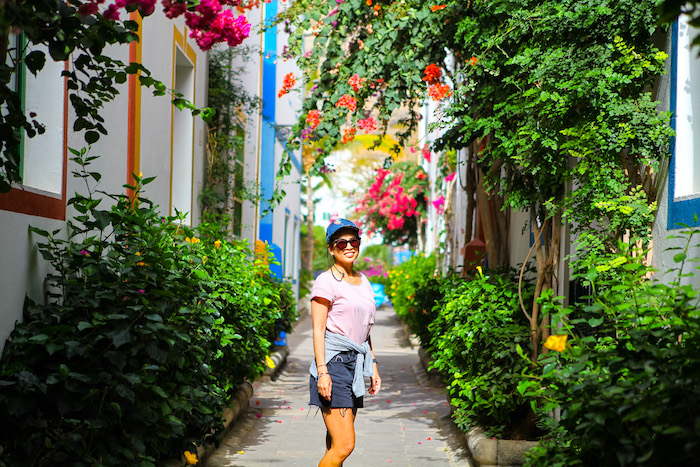
Money : the Canary Islands belong to Spain, so the currency is the euro.
Passport : Spain belongs to the Schengen Convention area, you do not need a passport to go there.
Vaccines : no particular vaccine is necessary.
Language : the official language is Spanish, but all seasonal workers speak English and sometimes even French.
Tipping : It is appreciated if customers leave a tip in taxis, hotels or restaurants to approximately 5 to 10% of the price.
Safety : the Canary Islands are safe but, as with any tourist destination, be careful with your belongings and do not leave anything in sight.
READ: 10 BEST REASONS TO VISIT THE CANARY ISLANDS
10. CONCLUSION
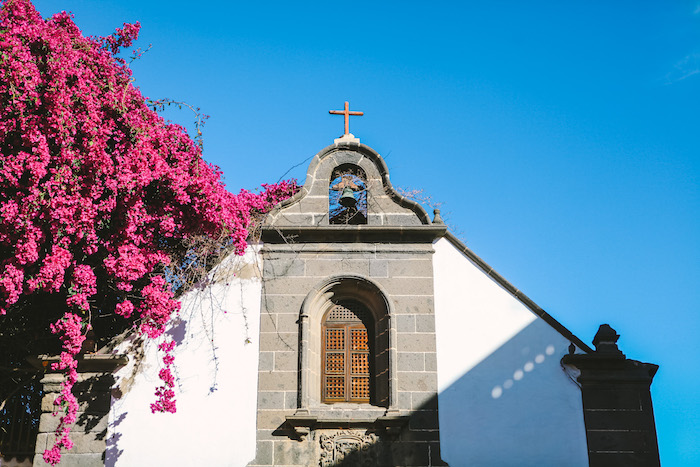
The Canary Islands are a real gems with full of surprise. During our 3 months traveling through the Islands, we realized how beautiful but more importantly how diverse each island is. There are so many things to do and see in the Canary islands. Even during our 3 months we couldn’t see it all. Each island has its own treasures!
READ: 10 BEST BEACHES IN THE CANARY ISLANDS
So what are you waiting for? Did you book your flight yet? Book here for the best prices .
We hope that this post was useful to prepare for your visit to the Canary Islands. If you have any questions, feel free to leave a comment below.
We are Hammer and Guillaume, a fun couple traveling the world. We will take you to some of the most amazing places on earth. Hammer is a yoga instructor and Guillaume a true water baby, enjoying all kinds of water sports. Follow-us to get the latest update about our travels.
Similar Posts

Why visiting Fuerteventura? What are the best things to see on the Islands? Here are 10 reasons why you should visit Fuerteventura.

GOZO’S FIESTAS: A VIBRANT CELEBRATION IN MALTA
Gozo’s fiestas are vibrant summer celebrations with fireworks, processions, and music, honoring patron saints and showcasing local traditions
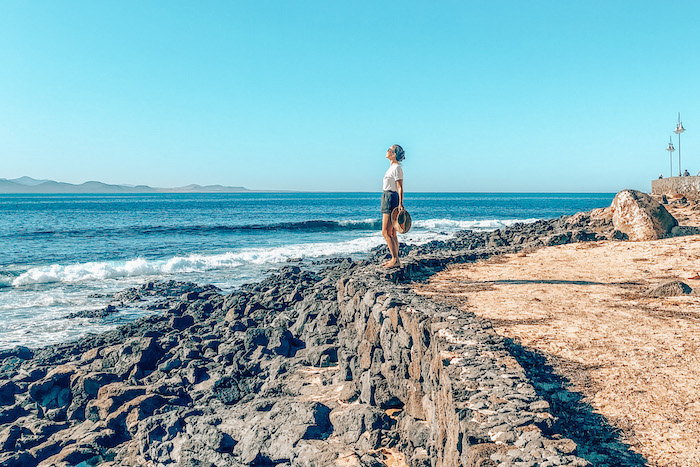
WHERE TO STAY IN LANZAROTE – 5 BEST AREAS
Where to stay in Lanzarote? From which area is it easier to visit Lanzarote? Where is the best beach? Here is your full guide.
![canary islands inter island travel 15 BEST BEACHES IN SANTORINI [+ HIDDEN GEMS]](https://afuncouple.com/wp-content/uploads/2023/10/Best-beaches-in-Santorini-2-768x514.jpg)
15 BEST BEACHES IN SANTORINI [+ HIDDEN GEMS]
Although not famous for its great beaches, Santorini has a few hidden gems. In this post we listed the 15 best beaches in Santorini Island!

8 BEST THINGS TO SEE AT AGAETE IN GRAN CANARIA
Agaete is a beautiful town in Gran Canaria located on the northwest of the island along the coast. Here is our full guide.
![canary islands inter island travel 25 BEST THINGS TO DO IN LANZAROTE [TRAVEL GUIDE]](https://afuncouple.com/wp-content/uploads/2022/01/Lanzarote_Lanzarote-11.jpg)
25 BEST THINGS TO DO IN LANZAROTE [TRAVEL GUIDE]
Are you planning a trip to Lanzarote and wondering what to do and see? This post is for for you! We compiled the perfect guide to Lanzarote.
Leave a Reply Cancel reply
Your email address will not be published. Required fields are marked *
- Gran Canaria
- Fuerteventura
- Canary Islands News
- Canary Islands Weather
- Canary Islands Money Saving Tips
- Island Hopping (Ferries and Flights)
- Rip-offs and Scams in the Canary Islands
- Which Canary Island has the best Weather?
- Top Luxury Hotels in the Canary Islands
- Beer in the Canary Islands
- Are the Canary Islands one hour ahead of the UK?

- El Hierro, Canary Islands
- Fuerteventura, Canary Islands
- Gran Canaria, Canary Islands
- La Gomera, Canary Islands
- La Palma, Canary Islands
- Lanzarote, Canary Islands
- Tenerife, Canary Islands
- Fake Villa Rental Websites
Island Hopping in the Canaries
- Top All-inclusive Hotels in the Canary Islands

Surprisingly, island hopping is not a well-known or well-developed concept in the Canary Islands. There are some historic reasons for this (more on this below), however many of the obstacles to island hopping have now disappeared and it is now much easier to fly to one island, travel to another, then fly back to your home country from there. Nowadays, there are plenty of inter-island flight and ferry connections, so it’s easy to get around, once you have a basic understanding of the locations of the ports and frequency of sailings.
So why do so few people Island-hop in the Canaries?
The main reason is a government subsidy of inter-island flights and ferries that applies only to residents of the islands. This means that inter-island travel is very expensive for tourists – ferries cost roughly double that of equivalent routes in the Greek Islands. The 50% subsidy for residents has allowed a near-monopoly to develop for inter-island flights, where it is often cheaper to fly to London than to fly to a neighbouring island.
Another historic reason, which no longer applies, was the dominance of package holidays in the islands, though the emergence of low-cost airlines and hotel booking websites means that it is now much easier for the independent traveller to make their own arrangements. We would still recommend booking your room in advance though, as you won’t find people waiting to sell you a room at the ferry port, and most Hotel’s published ‘rack’ rates are a lot higher than those that you’ll find online.
Binter Canarias is the largest inter-island airline and operate in all of the main Canary Islands airports. Although they don’t operate direct flights between all of the islands, connecting flights without re-check-ins can be booked with ease on their website. Travellers should note that Tenerife has two airports, with most inter-island flights operating from Tenerife North. For a supplemental fee, a ferry transfer to La Graciosa is also available. Binter also offer flights to the Azores, Cape Verde Islands, Madeira and several African cities.
CanaryFly are a relatively new airline and operate flights from Gran Canaria to Fuerteventura, Tenerife North and Lanzarote, and from Tenerife North to La Palma, Lanzarote and Gran Canaria.
Binter Canarias Canaryfly
As well as avoiding the security process in the airport, the ferry connections in the Canary Islands will often bring you closer to your accommodation, since most of the Islands’ airports are quite far from the main cities and tourist towns. A ferry will bring you right into the heart of major cities such as Las Palmas or Santa Cruz de Tenerife, or large tourist centres such as Playa Blanca or Los Cristianos.
Ferry Routes
From lanzarote, from fuerteventura, from gran canaria, from tenerife, from la palma, from la gomera, from el hierro.
Trasmediterranea operate a ferry between Cadiz (in Mainland Spain) and Santa Cruz de La Palma, stopping in Santa Cruz de Tenerife, Las Palmas, Puerto del Rosario and Arrecife. It is slow, but does offer a direct route between Las Palmas and Santa Cruz de La Palma.
Fred Olsen offer some bus-ferry combination tickets; e.g. from from Puerto del Carmen in Lanzarote to Corralejo in Fuerteventura (with bus transfer between Puerto del Carmen and the ferry port in Playa Blanca included). Connecting tickets with stop-overs are also available. Sometimes ferry tickets are available at a discount through alternative channels such as excursion ticket offices or as part of a coach excursion. Return tickets between Playa Blanca and Corralejo are usually cheaper from one of the small excursion offices at Playa Blanca port.
Leave a Reply Cancel reply
Your email address will not be published. Required fields are marked *

Canary Islands Travel Essentials
Useful information to help you start your trip to the canary islands.
Our Canary Islands Travel Essentials lays out the essential information you need to help you plan your trip to one of the world’s most popular island destinations. No matter how frequently you travel, some questions will always need answers: What’s the weather like? How can I get from Gran Canaria Airport to my hotel? What currency and type of plug do I need?
We have all these answers plus other basic info about the best time to go, getting there, getting around, and a few useful travel tips. You’ll learn about the most popular landmarks in the Canary Islands, such as Mount Teide, Timanfaya National Park, and Roque Nublo. You’ll also learn about the most popular towns and resorts around the Canary Islands, including Las Palmas, Santa Cruz de Tenerife, and Betancuria. It’s all compiled in this Canary Islands Travel Essentials. After going through this short and easy-to-read guide, you’ll be a little more prepared to start your trip to the Canary Islands.
What are the main towns and villages around the Canary Islands?

The Canary Islands archipelago is a Spanish territory comprising 8 inhabited islands off the coast of Western Sahara. The largest and most popular island is Tenerife with Santa Cruz de Tenerife as its main town. Fuerteventura is the 2nd largest island, with Betancuria among its most charming towns. Las Palmas on Gran Canaria serves as the archipelago’s shared capital, while Teguise in Lanzarote offers atmospheric strolls through its preserved historical center.
Las Palmas, Gran Canaria
As the capital of the Canary Islands, Las Palmas is a great place to base yourself when visiting the archipelago. The largest city in the Canaries itself offers world-class attractions such as the urban beach of Playa de las Canteras, as well as various historical landmarks and museums.
Santa Cruz de Tenerife, Tenerife
The capital city of Tenerife combines old and new with its modern facilities and rich colonial history. Castles and fortifications in the city date back to the 16th century. There are various museums and galleries where you can admire pre-Castilian art and artifacts.
Betancuria, Fuerteventura
Betancuria may be small, but it's one of the most beautiful villages in Fuerteventura. Its Old Town once served as the capital of the Canary Islands. Well-preserved French Gothic historical landmarks, such as the San Buenaventura Convent and the Cathedral of Santa María de Betancuria, grace its quaint streets.
Teguise, Lanzarote
Centrally located Teguise is one of the most important historic towns in the Canaries. Preserved buildings with bright white walls the town – the likes of Spinola Palace, Santa Barbara Castle, and the 16th-century Nuestra Señora de Guadalupe cathedral – all give Teguise a nostalgic vibe. There is an unmissable market held in the town center on Sunday mornings.
When is the best time to travel to the Canary Islands?

- The Canary Islands’ subtropical Mediterranean climate brings pleasantly mild weather throughout the year. Temperatures average between 15°C and 21°C from December to March and between 20°C and 30°C from June to September.
- The rainiest months are between November and January. December is the wettest, with an average of 5 days of rain. It’s all sunny and bright from May to September .
- July and August are the warmest months in the Canary Islands, with temperatures averaging 28°C. January – March is the coldest period , with low temperatures averaging 15°C.
- March–May and September–November are generally considered the best times to visit the Canary Islands. Both winter (December–March) and summer (June–September) are considered peak seasons in terms of tourism and usually sees higher prices.

10 Best Family Things to Do in the Canary Islands

10 Best Nightclubs in Tenerife


10 Free Things to Do in Lanzarote
Canary islands basics.

- Plug type: C, E and F
- Electricity: 230 V – 50 Hz
- Currency: Euro (€)
- International dialing code: +34
- Emergency telephone number: 112
How to get to my hotel in the Canary Islands?

The Canary Islands is one of the most popular island destinations among European travelers. As a Spanish territory, it is part of the Schengen Neighborhood. Most of the islands have their own airports, but the Gran Canaria Airport and Tenerife South Airport are the busiest of them all. By sea, you can get to the main islands from Huelva in Spain and Portugal’s island of Madeira.
Gran Canaria Airport (LPA)
The Gran Canaria Airport (LPA) or Aeropuerto de Gran Canaria is the Canary Islands’ busiest international airport. It’s served well by various international airlines. You can get direct flights to LPA from many different European cities, including Barcelona, Oslo, Amsterdam, Manchester, Berlin, Copenhagen, London, Milan, Stockholm, Helsinki, and Dublin.
The airport offers free Wi-Fi and facilities for people with reduced mobility. You can find the taxi stand just outside the arrivals hall. Many visitors opt for automobile rentals as a budget alternate as taxi cab fares can be high for traveling on the island. Automobile rental desks the likes of TopCar, AutoReisen, GoldCar-InterRent, Avis, Hertz, and Europcar are on the first floor of international arrivals.
Tenerife South Airport (TFS)
The Tenerife South Airport is on the largest island in the Canaries and the 2nd busiest after Gran Canaria’s. It’s served by many international airlines with direct flights to Tenerife from major cities across the European continent.
The taxi stands are just outside the arrivals hall. The airport also has bus services outside arrivals, which cost only a fraction of the taxi cab fare. Tenerife’s TITSA public buses are affordable alternatives, serving all parts of the island. Renting a automobile is a popular way of getting around the island. Rental desks of major companies such as Autoreisen, Budget, Cicar, Enterprise, Europcar, Goldcar, Hertz, Sixt, and Thrifty are on floors 0 and 1.
Ferry ports of Las Palmas, Arrecife, and Santa Cruz
The Port of Las Palmas (Puerto de Las Palmas de Gran Canaria) on Gran Canaria, the ferry port of Santa Cruz de Tenerife in La Palma, and the Port of Arrecife (Puerto de Arrecife) on Lanzarote are your main ports of call. Most of the ferries run inter-island transfers but you can also cross by ferry from the ports of Cadiz (Puerto de Cádiz) and Huelva (Puerto de Huelva) on mainland Spain’s southwest coast. Ferries also depart from Marina do Funchal in Madeira, Portugal.
How to get around the Canary Islands?

Travel tips
The Canary Islands are well connected by inter-island flights and ferries. Most of the islands have airports – there are 11 in total with 2 on Tenerife and 3 on Gran Canaria. Inter-island flights are mostly served by turboprops.
On the islands, hiring a automobile is usually the best way to get around and for a good balance between budget and convenience. You’ll be able to discover the remote regions of each island freely. You can also continue driving to closer islands such as Fuerteventura and Lanzarote with a ferry crossing.
Taking a taxi cab
Taxi cabs on the Canary Islands are abundant and easy to hail down the street around the islands’ major towns. They’re quick and easy and are quite a common means of getting around. However, frequent trips by taxi cab can get be heavy on your budget. There are ranks outside the arrivals of most airports and you can call arrange for one easily.
Notable taxi cab companies include Taxi cab Rivas Santa Cruz de Tenerife (+34 617 79 04 27), TAXI Ramon Leonard Dulgheru (+34 677 25 82 11), Taxi cab Santa Cruz de Tenerife (+34 644 26 07 85), Taxi cab La Palma (+34 669 25 25 33), and Taxi cab Gran Canaria (+34 828 04 80 10). Ensure that the taxi cabs are metered and agree on the destination and price before getting in. Uber is not available on the Canaries.
Traveling by bus
Buses are commonly called guagua (pronounced with a silent ‘g’) in the Canary Islands and are an affordable way for getting around most of the islands. In villages and small towns, they usually terminate on a particular street or plaza. Buy your ticket on the bus.
Each island has its own distinctive urban bus service and cities on the larger islands such as Tenerife and Gran Canaria have better and more efficient public transportation systems that can take you around the whole islands.
You can hop on a bus from the bus stations ( estación de guaguas ) or certain streets and plazas in villages and smaller towns. Not all drivers know English very well, so having the name of your destination written on a card may help. Bus passes are available from the various bus companies on each island. Among them are Global Provides Gran Canaria (+34 928 25 26 30), Tiadhe in Las Palmas (+34 928 85 57 26), TITSA in Tenerife (+34 922 47 95 00), TransHierro El Hierro (+34 922 55 11 75), and Transportes Insular La Palma (+34 922 41 19 24).
Renting a automobile in the Canary Islands
Among the different means of getting around the Canary Islands, renting a automobile is the most recommended. This is especially true if you’re planning to explore more of the islands beyond the resort neighborhoods. Rental rates are fairly reasonable and they’re readily available at the major airports. Even so, booking ahead for one is recommended. Most rental companies allow you to drive inter-island, with crossings by ferry.
Presenting an international driver's license is often – but not always – required, but you must be at least 21 years of age and have a valid driver's license. Driving is on the right-hand side of the road. Wear a seatbelt when driving at all times.
Inter-island crossing by ferry
Ferries run between the islands daily, with frequent services between the closer ones like Fuerteventura and Lanzarote. Ferry companies include Fred Olsen that also has services between La Gomera, La Palma and El Hierro with a transfer in Tenerife and between Gran Canaria and Tenerife. Most crossings take around 2.5 hours, so plan your travels carefully.
What are the main annual events in the Canary Islands?
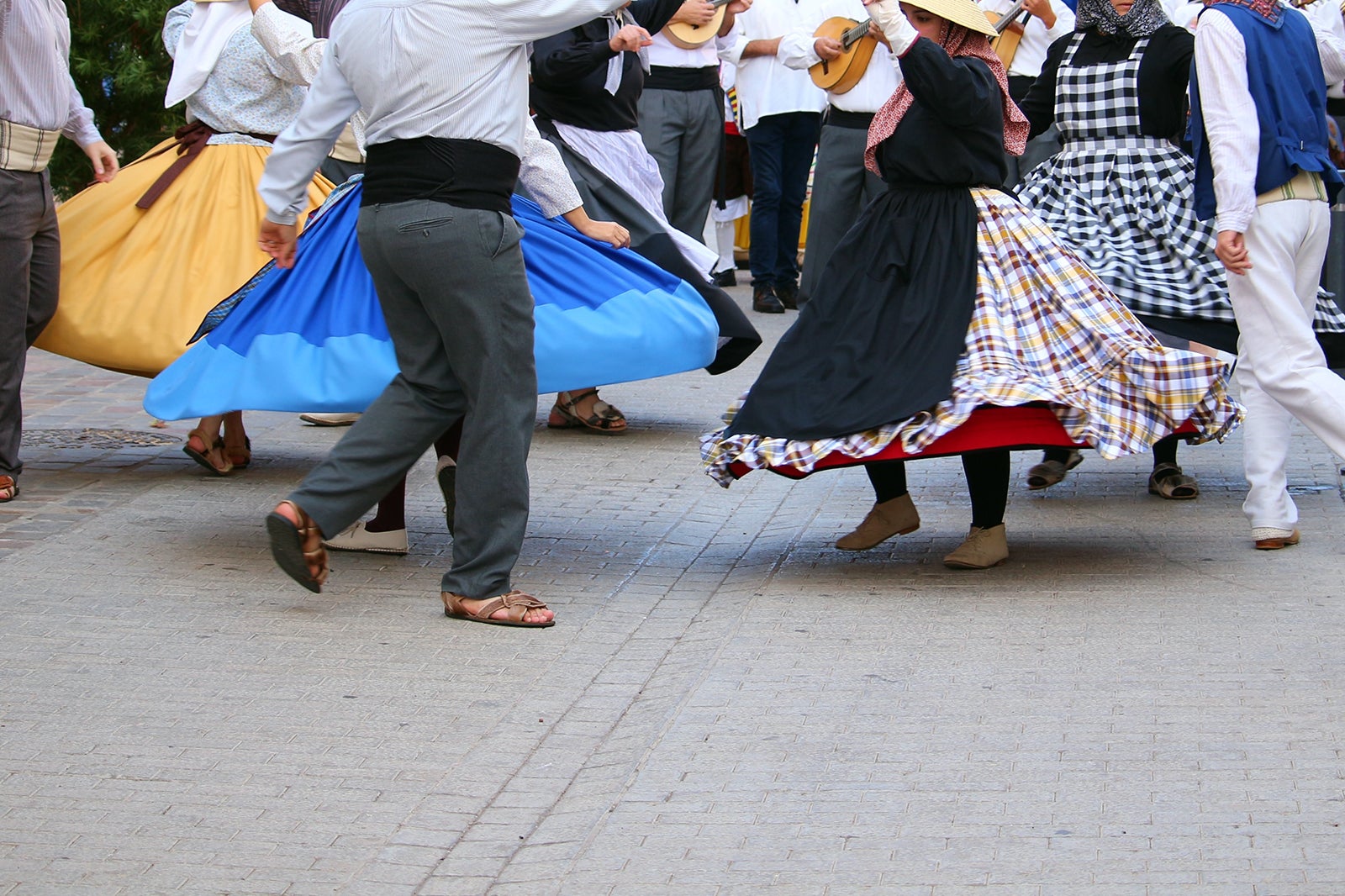
Carnival of Santa Cruz de Tenerife
- February/March
- A lively celebration held in the capital of Tenerife. Widely considered the biggest carnival of its kind after Rio de Janeiro’s, this major event draws visitors to the island from all over the world annually.
- Where: Santa Cruz de Tenerife
Corpus Christi
- This Catholic feast features parades all over Tenerife on a Thursday following Trinity Sunday. Around this time, you’ll be able to learn about local folklore and witness music performances and colorful street parades. The town of La Orotava in northern Tenerife often has the most elaborate celebrations.
- Where: throughout Tenerife
- Also called Fiesta de La Rama, this unique annual event honors the Virgin of Las Nieves. Thousands of people dance to the jovial music along the streets, before arriving at the shrine of the Virgin at Nuestra Señora de la Concepción in Agaete.
- Where: Agaete, Gran Canaria
What are the main landmarks in the Canary Islands?

Mount Teide, Tenerife
A still-active volcanic peak on Tenerife is the jewel of Teide National Park. It's the highest point in Spain and the highest point above sea level in the islands of all the Atlantic.
Timanfaya Natinoal Park, Lanzarote
A national park on the southwestern edge of Lanzarote. It's named after a volcanic peak that is still active and comprises a series of streaming volcanoes, lava fields, and a visitors center.
Parque Natural de Corralejo, Fuerteventura
This vast coastal nature preserve on the northeast of Fuerteventura features the largest spread of dunes in all of the Canary Islands. The exotic landscapes are starkly bordered by the turquoise waters of the Atlantic Ocean.
Roque Nublo, Gran Canaria
This 67-metre-tall volcanic rock is part of the UNESCO Biosphere Reserve of Gran Canaria. It's one of the island’s most striking natural features, found high up in the mountains at 1,813 meters above sea level.
This article includes opinions of the Go Guides editorial team. Hotels.com compensates authors for their writing appearing on this site; such compensation may include travel and other costs.
Start planning your trip
Related stories.

10 Best Things to Do in Isora

10 Great Restaurants in Tenerife

10 Best Beaches in Gran Canaria

10 Free Things to Do in Gran Canaria

10 Best Places to Watch Sunsets in the Canary Islands
Keep exploring.
- Canary Islands
- Fuerteventura
- Gran Canaria
- Cabo de Gata
- Castell-Platja d'Aro
- Chiclana de la Frontera
- Conil de la Frontera
- Costa del Maresme
- Ibiza Island
- Lloret de Mar
- Mallorca Island
- Roquetas de Mar
- San Sebastian
- Santiago de Compostela
- Torremolinos
- Tossa de Mar
- Balearic Islands
- Basque Country
- Costa del Sol
- Bosnia and Herzegovina
- Netherlands
- Northern Ireland
- Switzerland
- United Kingdom
Australia - New Zealand and the South Pacific
Mexico and central america, middle east, north america, south america, top destinations.
- Hotels in Las Vegas
- Hotels in New York
- Hotels in Chicago
- Hotels in Orlando
- Hotels in New Orleans
- Hotels in San Diego
- Hotels in Nashville
- Hotels in San Francisco
- Hotels in Los Angeles
- Hotels in Miami
- Hotels in Paris
- Hotels in Denver
- Hotels in Washington
- Hotels in Austin
- Hotels in Atlanta
- Hotels in San Antonio
- Hotels in Boston
- Hotels in Atlantic City
- Hotels in Key West
- Hotels in London
- Hotels in Virginia Beach
- Hotels in Seattle
- Hotels in Anaheim
- Hotels in Dallas
Top Countries & Regions
- Hotels in Aruba
- Hotels in Turks and Caicos
- Hotels in Singapore
- Hotels in Maldives
- Hotels in Bermuda
- Hotels in Malta
- Hotels in Jersey Shore
- Hotels in Maui
- Hotels in Puerto Rico Island
- Hotels in Kauai
- Hotels in Oahu
- Hotels in Cape Cod
Support & FAQs
Website feedback.
- Review a property
For Suppliers, Affiliates, and the Media
- Affiliate with us
- Expedia Partner Solutions
- Promote with us
- Travel agents
User terms & Privacy
- Terms & Conditions
- Do not sell my personal information
- About our ads
- Legal Information
List your property
- Hotels near me
- Travel Guides
- Vacation Rentals
* Some hotels require you to cancel more than 24 hours before check-in. Details on site.
© 2024 Hotels.com is an Expedia Group company. All rights reserved.
Hotels.com and the Hotels.com logo are trademarks or registered trademarks of Hotels.com, LP in the United States and/ or other countries. All other trademarks are the property of their respective owners.
Canary Islands

- 2.1 Demographics
- 2.2 History
- 2.3 Climate
- 3.1 By plane
- 3.2 By boat
- 4.1 By public transport
- 4.2 By rental car
- 4.3 By taxi
- 4.4 By boat
- 4.5 By plane
- 5 See and do
- 9.1 Pickpocketing
- 9.2 Natural hazards
The Canary Islands (Spanish: Islas Canarias ) are an Atlantic territory of Spain off the coast of Morocco and Western Sahara .
Islands [ edit ]

The Canary archipelago consists of 8 inhabited islands, and a few smaller uninhabited ones.
- 28.268611 -16.605556 1 Tenerife – The largest and most populous island with an area of 2,034 km² and also the most popular tourist destination of the archipelago, with about 6 million tourists per year. It has many museums and monuments that serve as portrayals of its rich history, but suffers under low cost mass tourism from the European mainland . Its oldest mountain ranges are young compared to its neighbouring islands, and volcanic activity did not begin to occur here until 8-12 million years ago, while other islands had it well over 20 million years ago. The highest mountain of Spain and 3rd largest volcano in the world (3,715 m), El Teide , dominates the landscape of the island. Santa Cruz de Tenerife is home to the Canary Island Parliament, while San Cristóbal de La Laguna is home to the oldest university on the Canary Islands. The main resorts are Puerto de la Cruz and Playa de las Américas .
- 28.4 -14 2 Fuerteventura – Second largest island, with an area of 1,660 km², but compared to Tenerife relatively thinly populated with only 117,000 (2019) inhabitants. There are fewer attractions, but in turn the island has not yet fallen prey to mass tourism. Its capital, Puerto del Rosario , is fairly laid back and has a few architectural gems to offer. Fuerteventura is a paradise for windsurfing and the only Canary Island with natural golden sandy beaches rather than naturally black volcanic sand. The main resorts of Fuerteventura are Corralejo, Caleta de Fuste and Morro Jable.
- 27.958611 -15.5925 3 Gran Canaria – The third largest island and second most popular (after Tenerife ) receiving over 4 million tourists every year–green and steep in the north, dry and flat in the south. It has the highest population density of the Canary Islands, with 540 inhabitants per km², and with tourists added to that number it gets a bit crowded at times. The main resorts on the Island are Las Palmas, Maspalomas, Puerto Rico and Playa del Ingles. Its capital city Las Palmas de Gran Canaria has the shared title of capital of the Canaries.
- 29.035 -13.635 4 Lanzarote – About half the size of Gran Canaria , but low lying and arid, with a spectacular volcanic landscape in the west of the island preserved as Timanfaya National Park . The greatest recorded eruptions occurred between 1730–1736. The capital is Arrecife and has its own airport, and draws most of the 2.9 million tourists visiting Lanzarote annually. There is a bustling nightlife in four main resorts—Arrecife, Costa Teguise, Puerto del Carmen and Playa Blanca.
- 29.231389 -13.501944 5 La Graciosa – The smallest inhabited island of the Canaries, being only 29 km² in size and having a population of approx. 735 (2018). Its capital is Caleta de Sebo, and it's a few kilometres to the north of Lanzarote .
- 28.666667 -17.866667 6 La Palma – The population is about 83,000 (2019), of which about half live in the capital, Santa Cruz de la Palma and in Los Llanos de Aridane . La Palma's geographic layout is a result of the volcanic formation of the island. The southern part of La Palma is dominated by the Cumbre Vieja, a volcanic ridge formed by numerous volcanic cones built of lava and scoria. The Cumbre Vieja is active but mostly dormant, with the last eruption occurring in 2021.
- 28.115 -17.225 7 La Gomera – The Magic Isle, with San Sebastián as capital, is a paradise for hikers. It is shaped like an orange that has been cut in half and split into segments. The terrain is rough, which has left deep ravines or barrancos between them. These barrancos, in turn, are covered by the laurisilva (laurel rain forest). The local wine has a distinct taste, and is often accompanied with a tapa (snack) of local cheese, roasted pork or goat meat. Other cultural dishes include almogrote , a cheese spread, and a syrup extracted from palm trees called miel de palma . The local people have a unique way of communicating across deep ravines by using a whistled speech called Silbo Gomero. This whistled language is indigenous to the island, and its existence has been documented since Roman times.
- 27.75 -18 8 El Hierro – "The edge of the world". It is also known as the Meridian Island, and Valverde is its capital.
All islands use the same time zone: Western European Time ( WET ). This means the time is the same as Portugal and United Kingdom .
Understand [ edit ]
Pico del Teide (on Tenerife) at 3,715 metres above sea level is the highest point in both the Canary Islands and Spanish territory.
Demographics [ edit ]
The islands have a population of 2.2 million (2019). Since the Canary Islands are a major European tourist destination, all the major islands have well-developed communication systems, airports, and ports.
Ethnically the population is mostly a mix of Spanish, European (German and British), South American, especially Cuban and Venezuelan as well as Northern and Sub-Sahara African. There are also historical minorities such as Indians, Koreans and lately Russians.
Each island speaks with a slightly different accent and there is a strong rivalry between the main islands of Tenerife and Gran Canaria. Most of the accents in the Canary Islands are closer to Latin American Spanish than to Castilian Spanish spoken in continental Spain.
The Canary Islands are very modern, very European, and extremely liberal.
History [ edit ]
Ancient legend claims the Canary Islands are the ‘lost islands’ of Atlantis. They have also been referred to as the lands without sorrow, holding on to the edge of the world. The first settlers were known as Guanches, thought to have arrived in the 10th century BC. The main economic system was built around agriculture and animal farming. During the 14th century, the islands were continuously invaded by different European countries. Sugar cane became the dominant crop, and since the early 20th century, bananas have been widely farmed.
During the Age of Sail, the islands were an important waypoint on the Cape Route .
In contrast to Spanish North Africa and other Spanish overseas territories, the Canary Islands have been an integrated part of Spain for centuries.
Climate [ edit ]
Often referred to as the islands of eternal spring , the Canary Islands are known for their mild climate. On average, they feature mild winters, although there is a lot of wind virtually every day, which makes temperatures feel cooler. Summers are dry and temperatures are generally comfortable but can feel chilly with the wind. The average temperature is 13°C in January and 19°C in July. Sunshine is somewhat abundant in summer and relatively scarce in winter.
Get in [ edit ]
Just like mainland Spain , the Canary Islands are part of the European Union and the Schengen area . Arrivals from other Schengen territories usually don't need to clear immigration.
By plane [ edit ]
There are regular flights from mainland Spain and elsewhere in Europe to the larger islands of Gran Canaria ( LPA IATA ), La Palma ( SPC IATA ), Fuerteventura ( FUE IATA ), Lanzarote ( ACE IATA ), and Tenerife which has two airports: the north ( TFN IATA ) near Santa Cruz and the south ( TFS IATA ) near Golf del Sur.
El Hierro and Gomera are reached by inter-island flights. La Graciosa has no airport.
By boat [ edit ]

The Spanish company Naviera Armas has weekly connections between Huelva and Cadiz in Spain and Arrecife (Lanzarote), Las Palmas (Gran Canaria) and Tenerife . Fred Olsen also has weekly connections from Huelva to Tenerife and Gran Canaria . A detailed map of these three routes can be found on Ferrygogo .
Cruise ships will often plan a stop at the Canary Islands when crossing the Atlantic Ocean or navigating along the eastern coast of Africa . Longer cruises around the Western Mediterranean will also often include a stop at the Canaries, and a few operators like Marella will even offer Canaries-only trips.
Get around [ edit ]
Travel between the islands is overly expensive for tourists, and it is generally not worth it since most islands have enough to offer to keep you busy. Transport for locals is subsidised, but the normal price for tourists is widely overdrawn compared to the rest of Europe for such services. Ferry and plane monopolies play into the situation.
By public transport [ edit ]
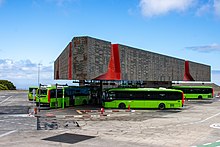
Public transport is available on most islands, varying widely in price and efficiency though—see the specific islands for more information. Do not expect bus drivers to know more than a couple of sentences in English or German, though they will try to be helpful.
By rental car [ edit ]
Renting a car is often the best option for discovering the remote and wildness regions— Tenerife might be an exception with its very efficient bus system. There are several well-established local rental companies that are well worth considering, already starting at €100/week or less, especially in off-season starting from April. On smaller islands like La Palma, the variety of companies is reduced though.
Local rental companies (always compare!):
- AutoReisen – Cheap, reliable and no deposit—from €9/day. Not very well known nor listed on the common price comparison websites. Pickup and drop-off is only possible at airports and on the same island. You must be at least 23 years old, and the rental price can only be paid by a credit or debit card in the driver's name. Ask around and you will see that people are very happy with them.
- PlusCar Rent a Car – Conditions are similar to AutoReisen—sometimes cheaper, sometimes more expensive. Likewise no deposit.
- CICAR a.k.a. Cabrera Medina – Reliable and well-known. A bit more expensive than AutoReisen and PlusCar, but with a wider range of models and a much denser network of rental branches all across the islands. No deposit for the car (but for the fuel).
- PaylessCar – Affordable and good.
- TopCar – From €12/day, but many people complain about consecutively being charged for fuel or cleaning. Deposit: €500.
- CarzRent (Tenerife only) – Always open, large deposits and avarage prices.
International rental companies:
- Goldcar, Dollar, Interrent – Not worth the stress—they are well known for ripping off their customers. If you still decide to use them, make sure you understand their terms & conditions, since there may be hidden fees or other tricks.
- Avis, Europcar, Thrifty, Hertz, Enterprice – Probably not worth the extra money, unless you have a membership thing or get a good discount.
The rental conditions of the local companies typically include unlimited mileage, a free second driver and free booster seats for your kids. As a general rule, the driver must be at least 21 years old. Fuel is not included, so make sure to fuel up before returning your vehicle to avoid additional costs.
As roads can often be narrow and unpaved, there is a real risk of damaging cars by ricocheting stones and pebbles. That's why most of the local companies include full insurance by default. When your rental car is fully insured, returning the vehicle is as simple as dropping off the key. Otherwise, inspect your rental car carefully before signing the contract, and consider adding insurance to the contract conditions for a surcharge.

Choose a car that is just large enough to fit all passengers and luggage, but try to keep it as small as possible. A small car is much easier to find a parking spot for in the historic centres of towns and cities, and passing another vehicle coming from the opposite direction becomes less of an adventure on narrow mountain roads. If you intend to do a lot of hiking, some extra ground clearance can occasionally come in handy, as paved parking lots can be a rare good in the mountains. Something like a Jeep Wrangler would be overkill for this, but if you've got money to burn, some of the local rental companies offer those too.
By taxi [ edit ]
Taxis can be expensive, and inside a city they are not worth the money unless you are in a real hurry or cannot balance yourself after a shopping day.

If you want to travel between the islands, a good option might be to take a ferry . Most ferries are modern, but they are pricey unless you have a residency status. Ferrygogo has a good overview of the different routes that are served by the two main companies:
- Naviera Armas / Transmediterránea – Has many connections all across the region with a large mixed fleet of regular and high-speed ferries.
- Fred Olsen – Focuses on high speed connections.
There are also a couple of scheduled water bus and on-demand water taxi connections available for shorter trips:
- Lineas Romero – Short distance passenger ferries connecting Lanzarote with Fuerteventura, and La Graciosa with Lanzarote.
- Fuertecharter – Offers daily trips from Fuerteventura to Isla de Lobos and Lanzarote.
Check their website for the best prices. There is of course also a number of companies offering whale watching tours and the like.
Renting a yacht (or bringing your own) is also a great way to get around if you know what you're doing. The islands offer numerous harbors and more than 30 marinas to moor in. Sailing the waters can be challenging, though, so plan your trip carefully. Some nautical information and useful links are available at the official website .
If you are afraid of the sea, or get sick just by staring at a ferry, then a plane is what you need to travel between the islands. With the exception of Graciosa (which only has a helipad for medical emergencies) all of the larger islands are served by regional airlines:
That usually means a turboprop ATR-72 or ATR-42, especially when going to the regional airport of La Gomera or El Hierro that are too small for regular airliners to land on. They are perfectly safe and adequately fast, as you are likely to spend more time at the airport than in the plane. Especially between Tenerife and Gran Canaria there are also sometimes airlines that fly from further afield and stop in both islands—whether they sell tickets for that last leg alone is rather hit and miss, however.
See and do [ edit ]
- Teide National Park on Tenerife , with at its centre Mount Teide, the tallest mountain of Spain and one of the world's tallest volcanoes.
- The historic centre of San Cristóbal de La Laguna on Tenerife , dotted with colonial architectural gems.
- The subtropical rainforest of La Garajonay National Park on La Gomera .
- The archaeological site of Risco Caído on Gran Canaria .
- Isla de El Hierro
- Gran Canaria
- Fuerteventura
- Macizo de Anaga
Otherwise the islands impress with:
- Numerous beaches
- Volcanoes and volcanic landscapes great for hiking
- Historical architecture in the old town of Las Palmas
Buy [ edit ]
Money [ edit ].
The euro (€) is the currency of the Canaries. The islands are outside the EU VAT area and have a separate sales tax from the VAT levied in mainland Spain.
Withdrawing money from Spanish ATM s will often result in an extra charge by the machine of €1–8. Cash can therefore be an alternative, but bears certain risks. However, since COVID credit cards are widely accepted as payment option, even for the tiniest amounts—cash-only is likely a source of tax evasion concerns. So, you are probably best off bringing a few €50–100 in cash and paying the rest with credit card, in case you want to avoid ATM fees.
Bizum is very popular with locals, and even some bars and restaurants—as an alternative to PayPal or Venmo. However, you need a Spanish bank account to use it.
Eat [ edit ]

- Goat – If any kind of meat is popular in the Canary Islands, it's goat. Locals and tourists equally will rave about good places they had goat in. If meat is your thing, you should definitely find such a place.
- Fish – You will find a wide variety of fish and seafood with restaurants that allow you to choose a fish from their selection (often hand caught), which they will cook for you. Two popular fish dishes from Tenerife are Caldereta, a meal with tomatoes, goat meat and potatoes and the Sancocho Canario, a salted fish, usually white, in a “mojo” sauce.
- Morcilla Dulce Canaria – A sweet blood sausage, almost a cake or a pudding, very popular on the islands. The taste feels delicious and disgusting at the same time.
- Plantain bananas – The Canary Islands are Europe's only exporter of these famously delicious, and usually fried bananas.
- Mousse de gofio or gofío amasado – A dessert made from gofio , miel de palma , and plantains.
Drink [ edit ]
- Barraquito – Also called barraco, is a coffee speciality from the Canary Islands and particularly popular on Tenerife but also on La Palma.
- Beer – There are three local breweries (Dorada, Tropical and Reina).
- Coffee – Cafe solo (espresso) and Cortado (espresso with milk) are the most ordered coffee variations on the islands.
- Rum – There are also well known rum distilleries, especially in Gran Canaria (Artemi and Arehucas). The ron miel is a sweet liquor made from rum and honey.
- Wines – There are several brands of wines in the islands. North of Tenerife, La Geria in Lanzarote or La Palma have excellent vineyards.
Stay safe [ edit ]
112 is the common emergency number.
Pickpocketing [ edit ]
While being a safe place, beware of pickpockets in major tourist and resort areas. Do not take electrical devices, credit cards or large amounts of cash to the beach, if you plan to leave your goods unattended while swimming, or when going out for clubbing. Already many mobile phones have been snatched around the islands from drunken lads, especially at night.
Natural hazards [ edit ]
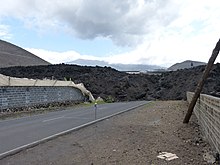
The islands are of volcanic origin, and the latest outbreak on La Palma in 2021 is proof that they are indeed still active. Outbreaks are rare, though, and any seismic activities are closely monitored to provide early warnings to the population. Moderate earthquakes can occur, but they typically do not exceed magnitudes of 5.5. Tropical storms sometimes reach the archipelago and can cause flooding and destruction in the coastal areas. All of the above mean that the terrain can be steep and unstable, making falling rocks and landslides a very real danger. If a mountain road or hiking trail is closed, that is usually because of this.
Episodes of heavy Calima (see Climate ) may lead to respiratory problems, coughing, nasal obstruction and itchy eyes. Consider wearing a N95 type respirator outside, hydrate enough, and stay indoors if it gets too dusty.
Heat strokes and sunburn are an underestimated risk, as solar radiation so close to the equator is much stronger than many European tourists expect. The latter is maybe even more of a concern in the high mountains, where the air is thinner and feels more breezy.
There are no poisonous or otherwise dangerous wild animals around, and while mosquitoes may bite you on occasion, they do not carry infectious diseases .
Go next [ edit ]
- Spain – Regular ferry connections exist between the Canary Islands and mainland Spain.
- Morocco – There used to exist a ferry connection, but nowadays using the plane is the only option.
- Madeira and Azores – Regular flights are available.
- Has custom banner
- Has mapframe
- Maps with non-default size
- Has map markers
- Eat listing with no coordinates
- Outline regions
- Outline articles
- Region articles
- Has Geo parameter
- All destination articles
- Pages with maps
Navigation menu
Canary Islands Travel Guide
Courtesy of Westend61 | Getty Images

Getting Around Canary Islands
The best ways to get around the Canary Islands are by car and by plane. Although there are bus systems available on all the islands, most don't run frequently enough to be useful to tourists. And the islands' attractions are far too spread out to see completely on foot. A car will enable you to get where you want to go quickly and efficiently. When you want to island hop, a plane is a reliable and efficient way to get around. If you'd rather get around by boat, several companies also offer inter-island ferry services.
Although all seven islands have airports, the busiest airports are Tenerife South Airport (TFS), Tenerife North Airport (TFN) and Gran Canaria Airport (LPA). At the moment, however, there are no direct flights from the U.S. to the Canary Islands. To reach the islands, you'll have to first make a pit stop at a European airport like Madrid . When it comes to ground transportation, all of the airports offer some combination of taxis, car rental agencies and buses.
Explore More of Canary Islands

Things To Do

Best Hotels

You might also like

# 7 in Best Places to Visit in Africa in 2023

Hawaii - The Big Island
# 3 in Which Hawaiian Island is the Best to Visit? Our 2024 Ranking

# 3 in Best Cheap European Vacations for 2023-2024
If you make a purchase from our site, we may earn a commission. This does not affect the quality or independence of our editorial content.
Recommended
The 18 Best Napa Valley Wineries to Visit in 2024
Lyn Mettler|Sharael Kolberg April 23, 2024

The 25 Best Beaches on the East Coast for 2024
Timothy J. Forster|Sharael Kolberg April 19, 2024

The 50 Best Hotels in the USA 2024
Christina Maggitas February 6, 2024

The 32 Most Famous Landmarks in the World
Gwen Pratesi|Timothy J. Forster February 1, 2024

9 Top All-Inclusive Resorts in Florida for 2024
Gwen Pratesi|Amanda Norcross January 5, 2024

24 Top All-Inclusive Resorts in the U.S. for 2024
Erin Evans January 4, 2024

26 Top Adults-Only All-Inclusive Resorts for 2024
Zach Watson December 28, 2023

Solo Vacations: The 36 Best Places to Travel Alone in 2024
Lyn Mettler|Erin Vasta December 22, 2023

26 Cheap Beach Vacations for Travelers on a Budget
Kyle McCarthy|Sharael Kolberg December 4, 2023

The 50 Most Beautiful White Sand Beaches in the World
Holly Johnson December 1, 2023


The Perfect 2-Week Canary Islands Itinerary
- Pinterest 148
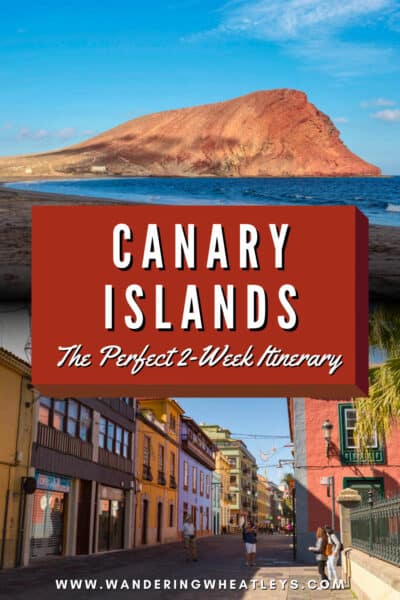
Fondly known as the islands of eternal spring, the Canary Islands are as close as you can get to Hawaii without leaving Europe. These volcanic islands enjoy a blissfully warm subtropical climate throughout the year, making them a great choice if you’re looking to shake off the snow and enjoy some glorious winter sunshine.
During your 14-day Canary Islands trip , you’ll have the chance to discover just how diverse the landscape of the Canaries really is. From wind-swept black sandy beaches that stretch on for miles and sleepy fishing villages that time forgot to lush jungles home to mysterious hidden walking trails and urban cities that will make you feel like you’re in Madrid or Barcelona, there’s absolutely loads to explore here.
Compiling your own travel itinerary can be a big challenge. Especially if you’ve never been to the place you’re visiting before. There are so many must-see places in the Canary Islands that it can feel overwhelming just getting started.
To help you out, we’ve done a lot of the hard work for you and have put together a fun-filled guide you can follow to explore the very best that the Canary Islands have to offer. We’ve also added some tips to help you get off to a great start before you even book your flight!
Disclaimer: This post may contain affiliate links. If you make a purchase or booking through one of our links we may earn a small commission (don’t worry, it’s at no extra cost to you).
Two Weeks in the Canary Islands
Preparing for the canary islands.
The Canary Islands form part of the EU. So as long as you plan on spending fewer than 90 days within the archipelago, you don’t need a visa to travel to the Canary Islands. All you need is a passport that’s valid for at least three months following your planned departure date from the Canary Islands. Your passport also needs to have been issued within the past 10 years.
The above information is true for most countries, including the US, but not all of them. To be safe, check official sources to find out exactly what paperwork you need to travel before leaving home for your 2-week trip to the Canary Islands. The Canary Islands’ currency is the euro. It’s possible to exchange your money for euros before you travel. But it’s a better idea to wait until you arrive on the islands before getting euros. All you need to do is go to an ATM and withdraw the cash directly from the machine. Getting euros this way is reliably cheaper than exchanging your money.
If you don’t want to use cash at all, you don’t have to. Almost everywhere, from tiny minimarkets to fine dining restaurants, accepts all major credit cards, with the exception of American Express.
Things to Know Before You Go
If you speak Spanish and you want to try to talk to the locals during your 2 weeks in the Canary Islands, you may struggle a little. While they do speak the same variety of Spanish that locals do on the mainland (Castellano/Castillian), they’ve got a distinct dialect that can be difficult to understand.
To make it worse, each island has its own dialect with its own slang words! Don’t worry too much about it. A lot of locals on the island speak at least basic English, so you shouldn’t have too much of a problem.
Most people in the Canary Islands have an extremely laid-back attitude. When your waiter tells you they’ll be back “in 2 minutes” with your bill, don’t be surprised if they take more than 10 minutes. Get used to being on Canarian time, and you’ll have a much more chilled-out vacation.
Avoid doing anything important in the middle of the day, on Saturday afternoons, or any time on Sunday. Many important businesses, such as banks, pharmacies, post offices, and supermarkets, close between 1 pm and 5 pm on weekdays, from 2 pm onwards on Saturdays, and all day on Sundays. Use the time to get out into nature and enjoy the gorgeous landscape.
Getting Around the Canary Islands
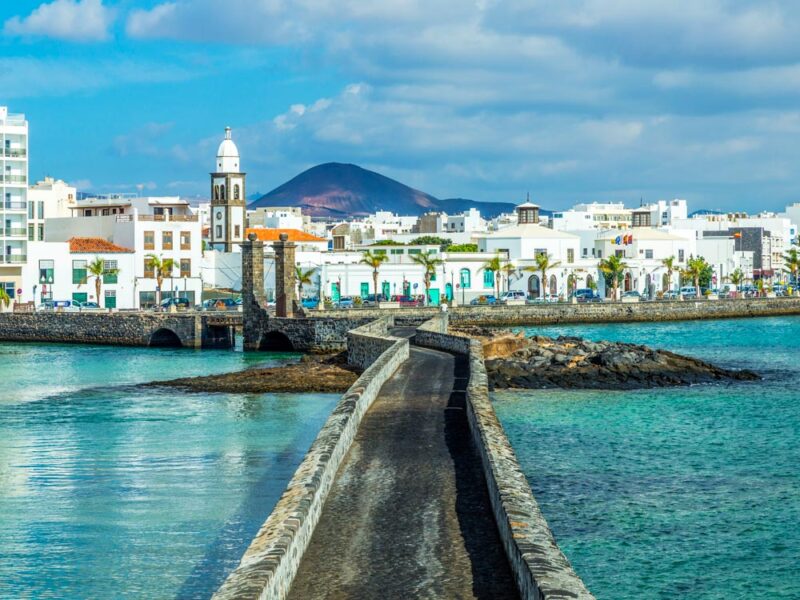
Depending on where you’re traveling from, you may find it a little tricky to get to the Canary Islands. We recommend you fly to Tenerife South Airport because this airport has the most connections to the rest of Europe. If you’re planning a big European trip, try to end up in Barcelona or Madrid before visiting the Canary Islands. You’ll find it easy to fly between the islands and these two cities.
There are no ridesharing companies in the Canary Islands, and taxis can be pricey. Public transport (buses and trams) are an option, but they can often be very infrequent and unreliable.
Because of this, we recommend flying into your starting airport and renting a car. Gas is very affordable in the Canary Islands compared to a lot of other places in the world. There are also very low-cost ferry routes that go between many of the islands several times each day.
Renting a car and moving between the islands via ferry allows you to be flexible with your schedule and carry all your stuff without worrying about paying extra for baggage.
Canary Islands Itinerary: 2 Weeks to Explore the Highlights
Tenerife north – 2 nights.
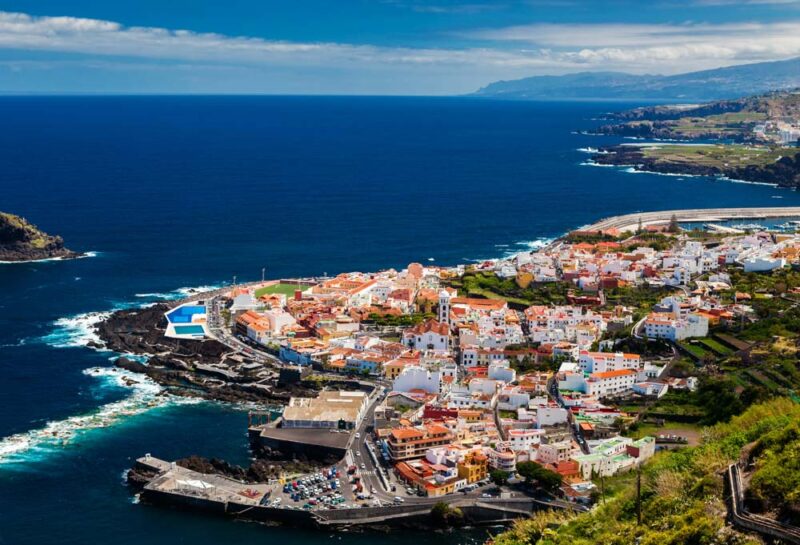
The north of Tenerife is the first stop on your Canary Islands itinerary. This part of the island is blanketed in lush greenery, dotted with hidden villages, and home to some of the most spectacular volcanic beaches you’ll ever see if your life.
Things to do in Tenerife North
Mount teide.

Start your 2-week trip to the Canary Islands with a visit to Mount Teide. The highest peak in Spain, this impressive volcano and the surrounding landscape look like something you’d find on an alien planet, not a subtropical island.
Guachinches

The north of Tenerife is where you’ll find “guachinches.” These are small Canarian restaurants that dish up great local food for less than the loose change in your pocket. We suggest checking out Guachinche Como En Casa .
Loro Parque

Loro Parque is, without a doubt, one of the top places to visit in the Canary Islands for animal and plant lovers. Or, for something a little less touristic, go hiking in the Anaga Mountains. This is one of the most stunning parts of the island, with trails ranging from 30 minutes up to 8+ hours.
Getting To Tenerife North
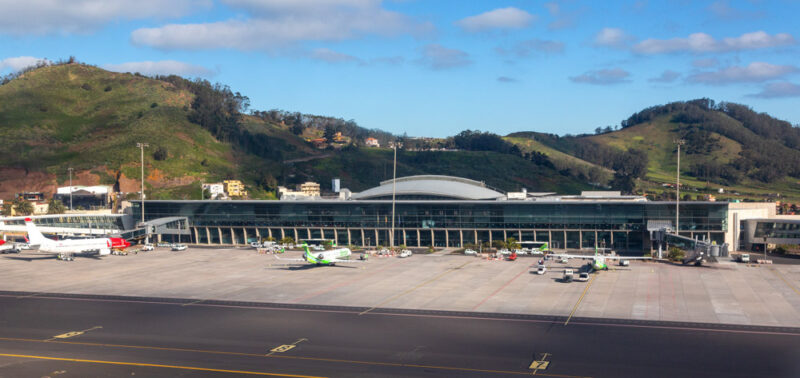
The easiest way to get to Tenerife North is to fly into Tenerife Norte-Ciudad de La Laguna Airport from mainland Spain or one of the other Canary Islands. There are cheap flights leaving from Barcelona and Madrid several times each day.
After you arrive in Tenerife North, we recommend you rent a car. Car rentals and gas are incredibly affordable in the Canary Islands. Driving yourself is the cheapest, quickest, and most convenient way to get around.
Where to stay in Tenerife North
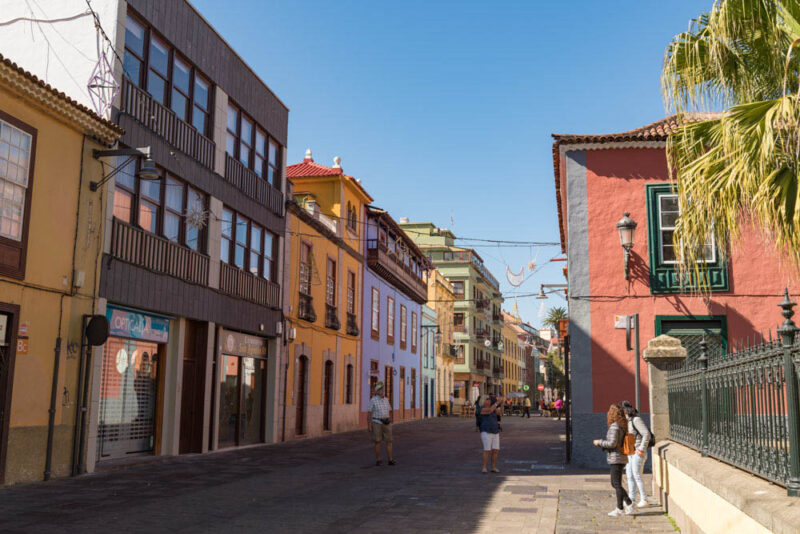
If you’re craving a bit of urban life, consider staying in Santa Cruz. This is the island’s capital city and is the liveliest place in the north of the island. The biggest vacation resort town in Tenerife North is Puerto de la Cruz. Here you’ll find loads of great hotels and attractions with a more laid-back vibe than the resorts in Tenerife South.
For a unique experience, stay in La Laguna. A UNESCO World Heritage Site, La Laguna is full of stunning buildings and beautiful parks with a distinctly local, Canarian feel.
Tenerife South – 2 nights
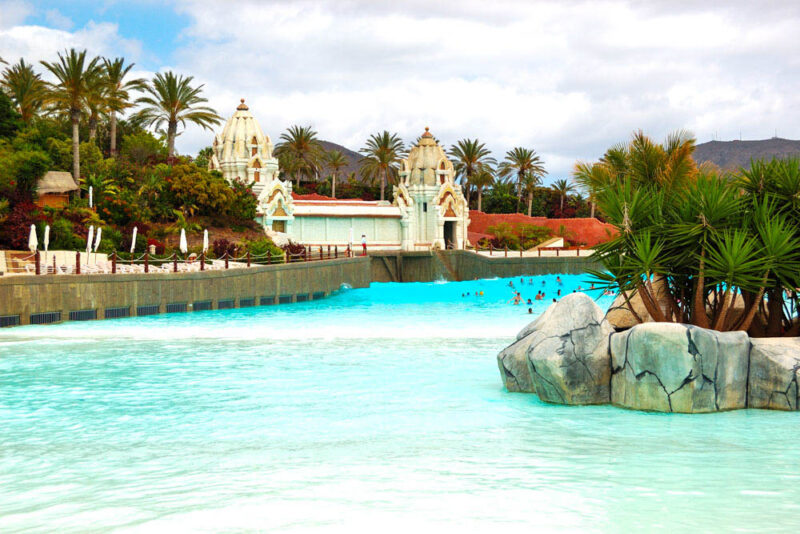
The most popular vacation destination in all the islands, the south of Tenerife boasts luxury resorts, dazzling beaches, and world-class attractions. Because the island is so compact, you can easily visit rural Canarian villages, mystical forests, and breathtaking viewpoints after just a short drive.
Things to do in Tenerife South
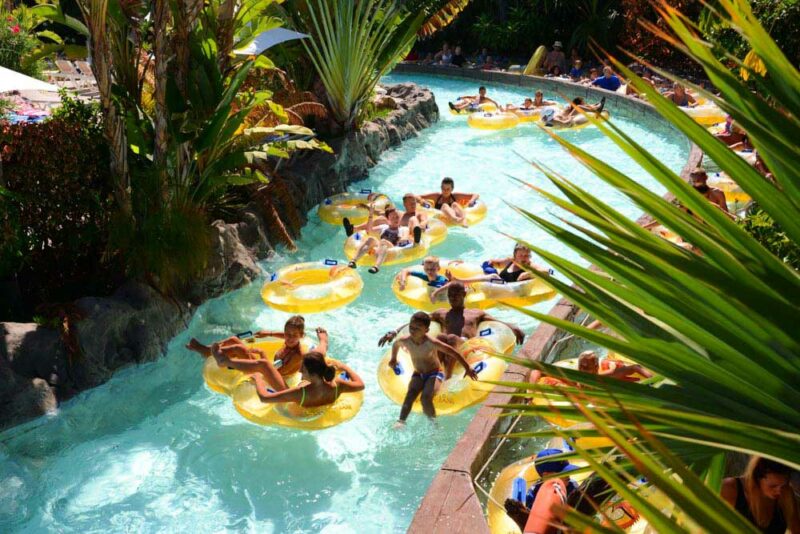
Tenerife South is home to so many of the best Canary Islands attractions that you’ll be exhausted after the end of your second leg! Siam Park , voted the best water park in the world for more than seven years running, is an absolute must-visit. If high-speed watercoasters aren’t your thing, there are plenty of beaches where you can enjoy a chilled-out day in the sun. Playa del Duque is one of the best.
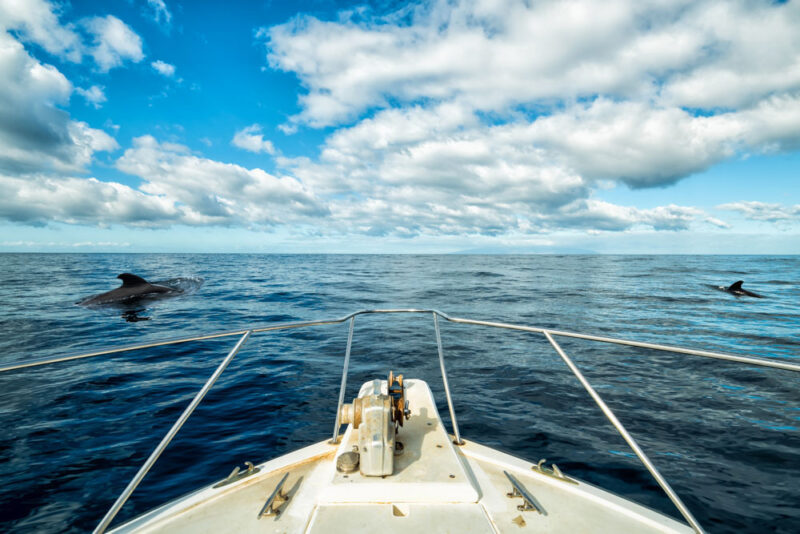
Tenerife is an amazing place for wildlife, so hop on an eco-friendly boat tour and go searching for whales and dolphins. When you need time to unwind, head to the bohemian surfer resort town of El Medano and barhop while enjoying the gorgeous views.
Getting To Tenerife South
The easiest way to get from Tenerife North to Tenerife South is to simply drive there. If you decide against renting a car, hop on the bus. While a taxi is convenient, the trip will be very expensive.
Where to stay in Tenerife South
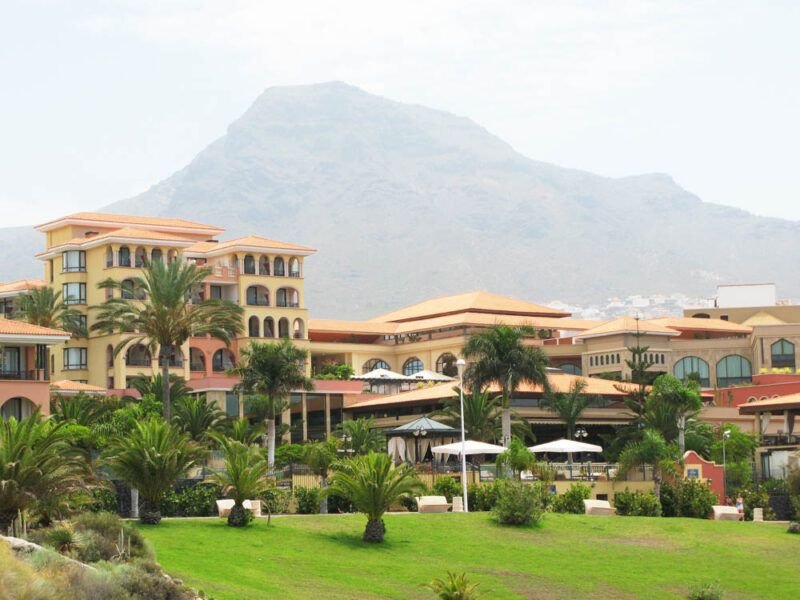
As Tenerife South is mostly a purpose-built vacation resort, there are plenty of fantastic places to stay. Costa Adeje is in the center of the region and boasts countless hotels, cafes, bars, restaurants, and stores. For something a little more laid-back, we suggest the older and more peaceful area of Los Cristianos.
If you want to get away from the tourist areas, consider staying in La Tejita. This neighborhood has a very local vibe and is home to the largest natural beach in Tenerife.
La Gomera – 2 nights
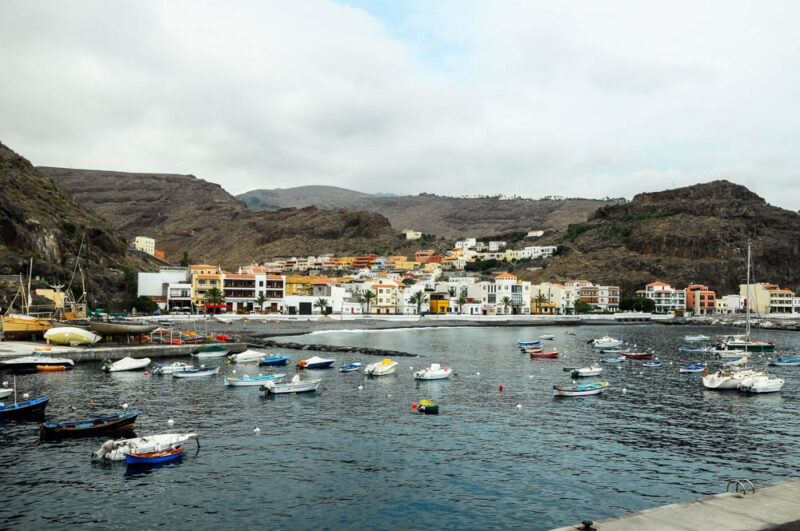
One of the smallest Canary Islands, La Gomera feels like a place that time forgot. This clandestine island is one of the best places in the Canary Islands, home to a never-ending number of hiking trails and viewpoints. Very few people speak English here, so brush up on your Spanish before you go!
Things to do in La Gomera
Garajonay national park.
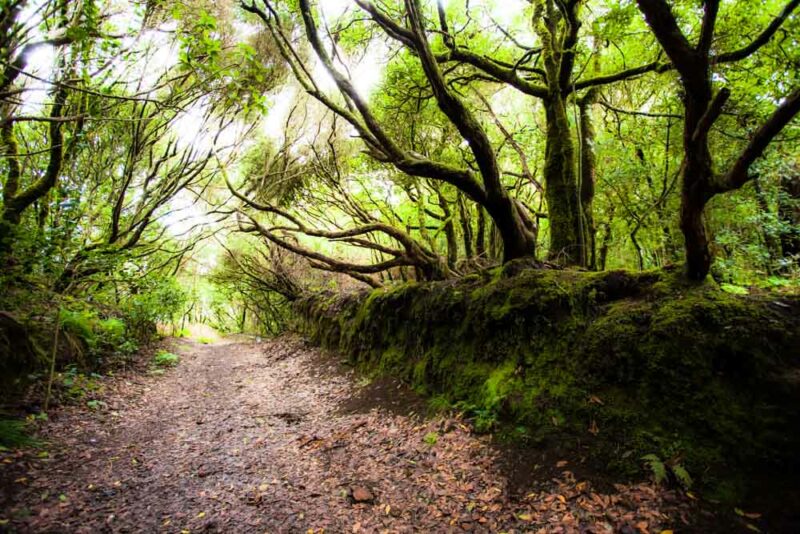
The best 2-week Canary Islands itinerary has to include hiking in La Gomera. The island is blanketed in thick, verdant forests that hide trickling waterfalls, centuries-old bridges, and fountains that boast some of the purest water you’ll ever drink. Whether or not you plan on hiking, the Garajonay National Park is a magical place to visit, with a labyrinth of trails, picnic and BBQ areas, and a visitors center.
Abrante Viewpoint
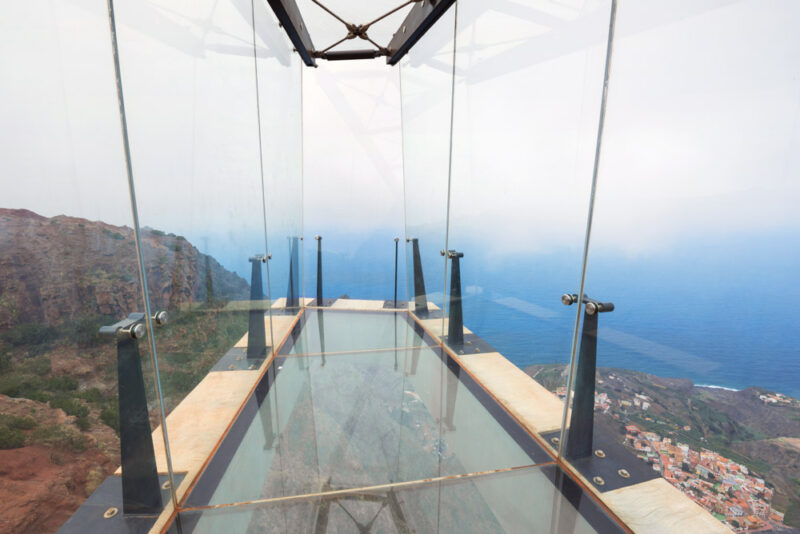
For an awesome view, visit Abrante Viewpoint. Here you’ll find a glass platform you can step out onto and gaze 1,300 feet below you, across the ocean and all the way to Tenerife. To get a little closer to the ocean, spend a lazy day at the volcanic beach at Valle Gran Rey.
Getting to La Gomera
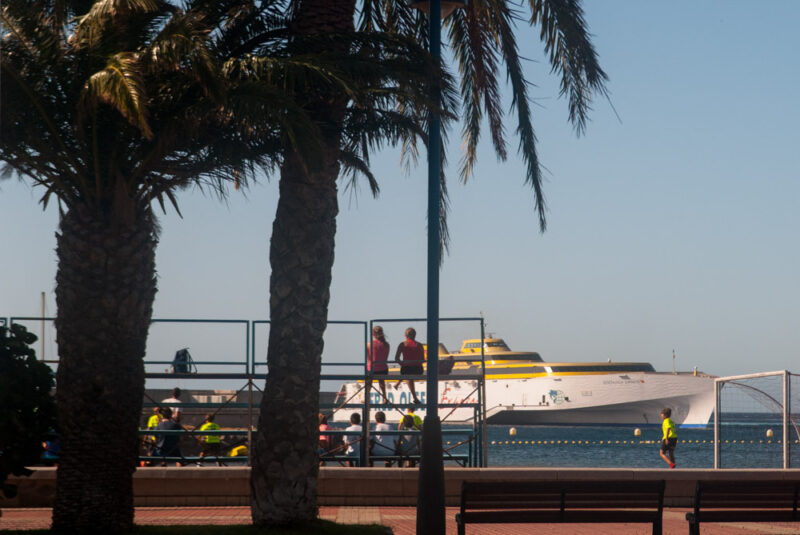
If you’ve decided to rent a car, you can reach La Gomera from Tenerife South via ferry. Fred Olsen is the fastest and cheapest ferry service, with several connections every day between Los Cristianos in Tenerife South and San Sebastian in La Gomera.
If you’re using public transport, you can fly from Tenerife South Airport to La Gomera Airport with Binter. The flight goes via Gran Canaria. So even if you don’t have a car, we still recommend you travel via ferry for a speedier journey.
Where to stay in La Gomera
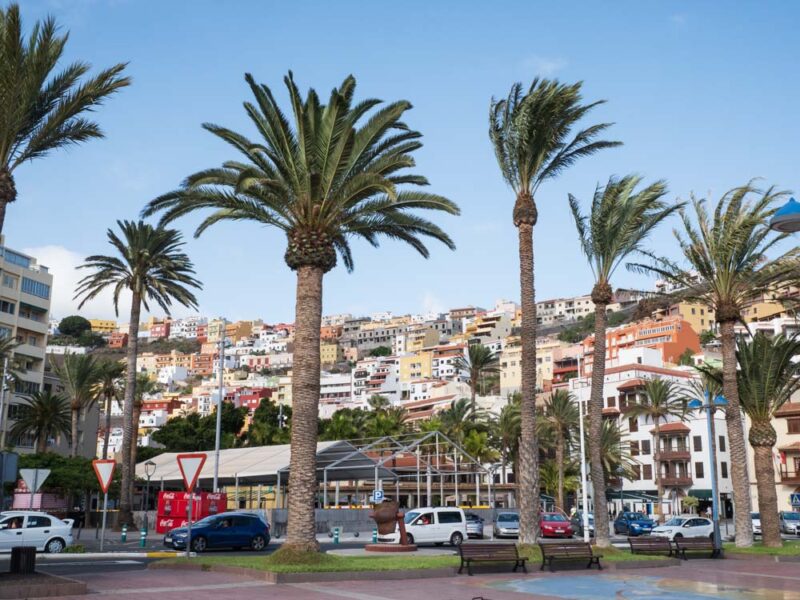
San Sebastian is the main city in La Gomera. Here you’ll find a decent selection of bars, cafes, and restaurants, which are all within walking distance. Valley Gran Rey is the biggest vacation resort on the island, although it has a much more serene and local vibe than anything you will have experienced in Tenerife.
La Palma – 2 nights
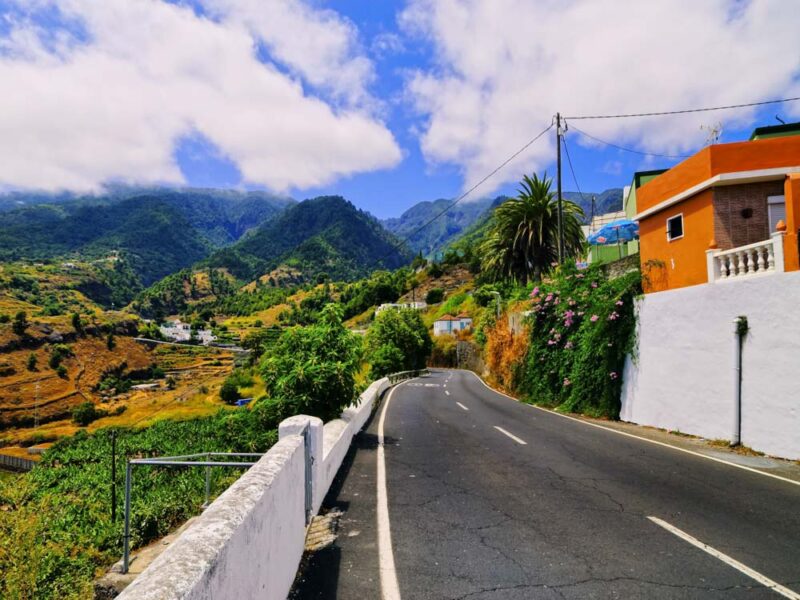
La Palma is where you’ll find some of the most stunning places to see in the Canary Islands. Fondly nicknamed “La Isla Bonita” (the Beautiful Island), La Palma is filled with misty forests, dramatic volcanoes, and a spectacular coastline.
The island was recently devastated by a volcanic eruption that lasted months. Although everything has settled down now and it’s completely safe to visit today, you can still see the remarkable aftermath of the natural destruction.
Things to do in La Palma
Start your La Palma adventure by hopping in your car and heading for one of the best places to go in the Canary Islands. The volcano that erupted (Cumbre Vieja) is located in the southern center of the island. Drive anywhere in this area, and you’ll be surrounded by giant mounds of ash the volcano left behind.
Salinas de Fuencaliente
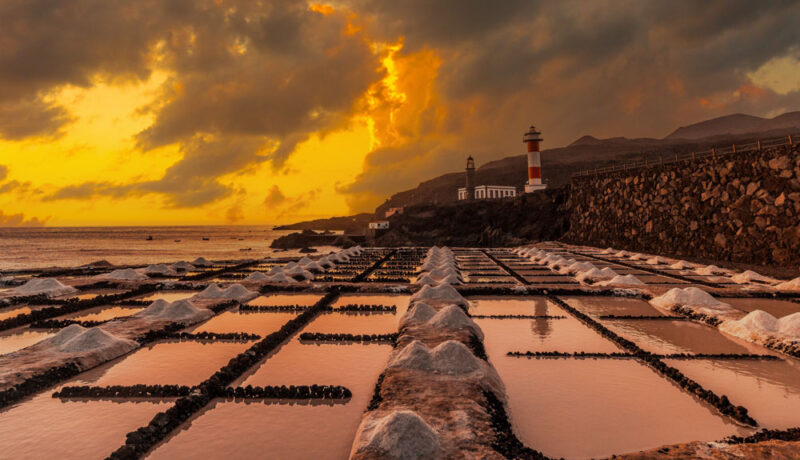
When you need a breath of fresh air, head to the coastline and visit Salinas de Fuencaliente . This fascinating place shows you how salt is harvested from the sea and used to make all kinds of wonderful products. If you’d prefer something a little sweeter, visit Quesería Luna de Awara and Bodegas Carballo for some cheese and wine tasting.
Roque de Los Muchachos

La Palma is one of the best places in the world for stargazing. End your visit to the island with a guided tour to Roque de Los Muchachos , where you’ll learn about everything in the night sky.
Getting to La Palma
You can reach La Palma from La Gomera by taking the Fred Olsen or Naviera Armas ferry. Both ferry lines operate between San Sebastian in La Gomera and Santa Cruz in La Palma. Alternatively, you can fly with Binter between La Gomera Airport and La Palma Airport.
Where to stay in La Palma
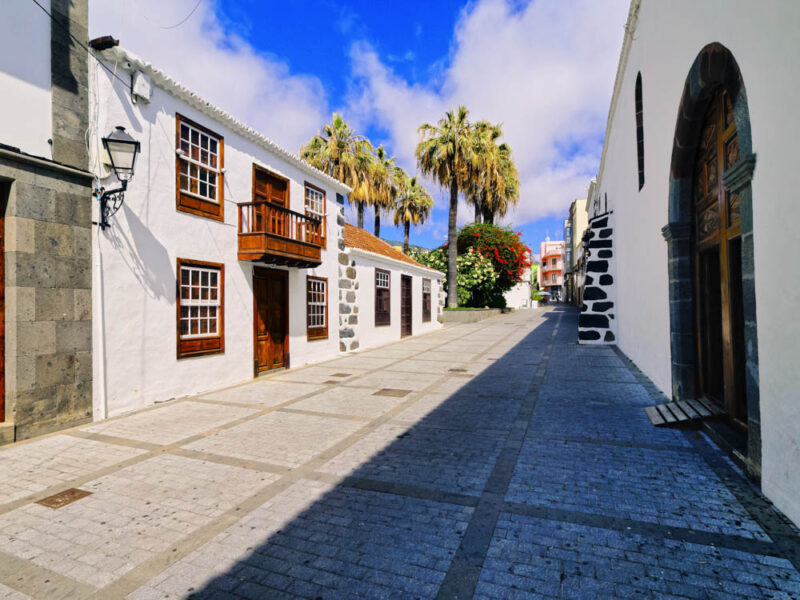
Llanos de Aridane is the most built-up part of La Palma, with the most cafes, restaurants, bars, boutiques, and stores. It’s very central, and staying here makes it easy to travel anywhere on the island. If you want to chill out somewhere and enjoy plenty of beach time, Tazacorte is the place for you. This small coastal village has black sandy bays and one stunning upmarket hotel.
Gran Canaria – 2 nights
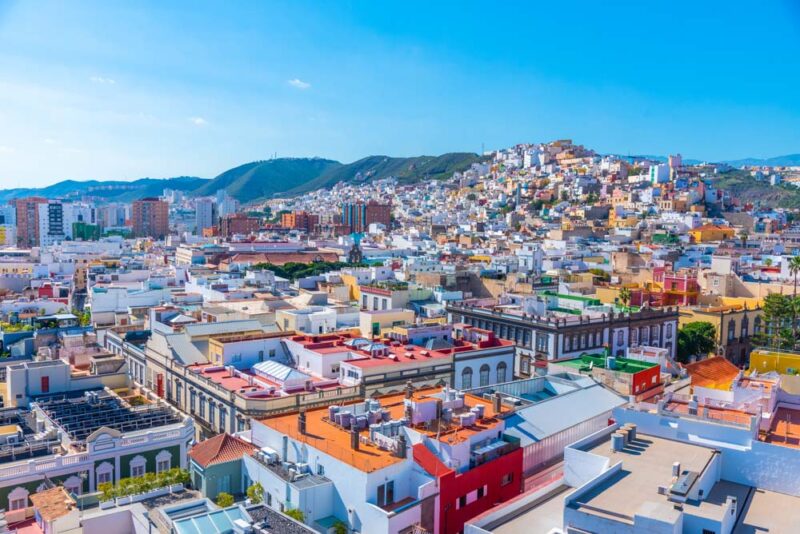
Part desert and part tropical paradise, Gran Canaria is where you’ll find some of the best places to visit in the Canary Islands. The second most popular of the Canaries, after Tenerife, Gran Canaria has it all. From wild, rugged landscapes and beaches that stretch on for miles to amazing family attractions and stunning coastal villages, you’ll have a great time here.
Things to do in Gran Canaria
Maspalomas dunes.
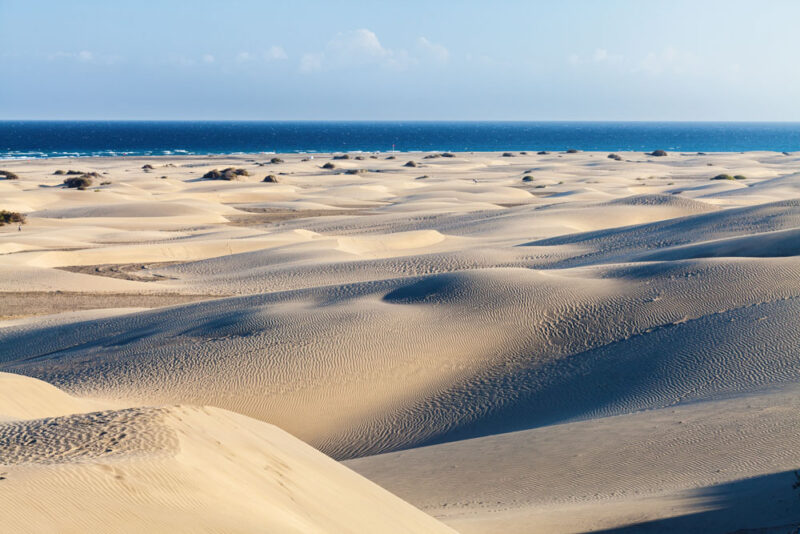
Start off the Gran Canaria leg of your journey with one of the best things to do in the Canary islands – the Maspalomas Dunes. Located in the south of the island, these undulating mountains of sand will transport you to a remote desert in an instant. For something a little less dry and arid, check out Poema del Mar . This amazing aquarium is packed with enough exhibits to keep you entertained for hours.
Poema del Mar

Whether you’re in the mood to explore or relax, Las Canteras Beach is a great place to visit. Here you can lounge under the sun on the soft golden sand or take a walk along the promenade that stretches on for 2 miles.
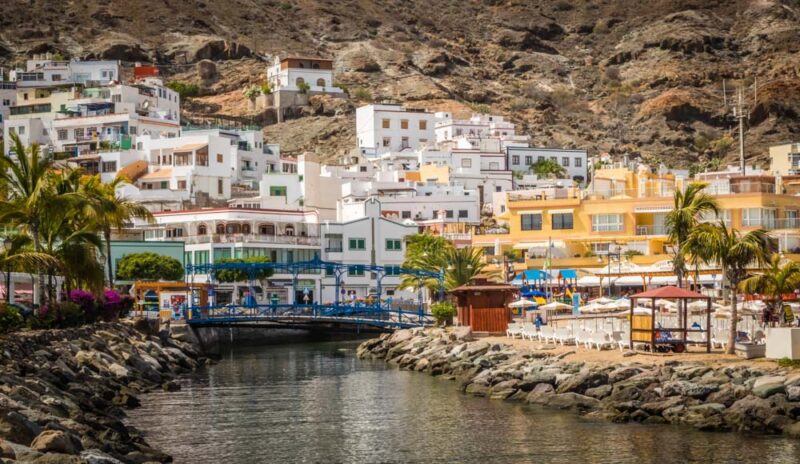
If you’ve got time, check out the resort town of Mogan. With gorgeous bougainvillea, rippling canals, and cute bridges, this place is as close as you can get to Venice without leaving the Canary Islands.
Getting to Gran Canaria
To get to Gran Canaria from La Palma, simply hop on the ferry at Santa Cruz. In a few hours, you’ll arrive at the Port of Las Palmas in Gran Canaria. A quicker option is to fly from La Palma Airport in La Palma to Las Palmas Airport in Gran Canaria.
Try not to get confused with the similar names! This journey takes less than one hour, although you’ll have to drop off your rental car in La Palma and pick another one up in Gran Canaria.
Where to stay in Gran Canaria
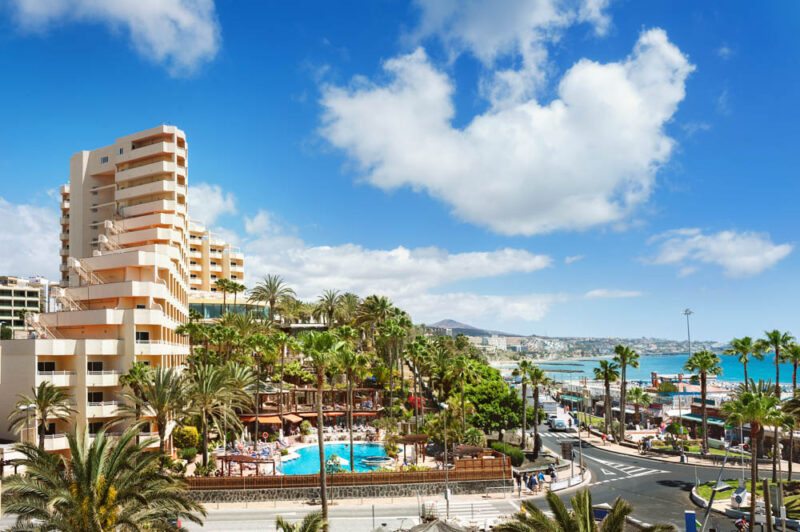
If you’re seeking a lively vibe with plenty of bars, restaurants, and nightclubs, plan to stay in Maspalomas or Playa del Ingles. You’ll find loads of evening entertainment here, as well as gorgeous hotels and dazzling beaches. For something a bit more peaceful, we suggest Puerto de Mogan, San Agustin, or Puerto Rico.
While there are still plenty of dining options and beaches at these resorts, they’re slightly more upmarket and peaceful. Check out our picks for the best hotels in Gran Canaria .
Fuerteventura – 2 nights
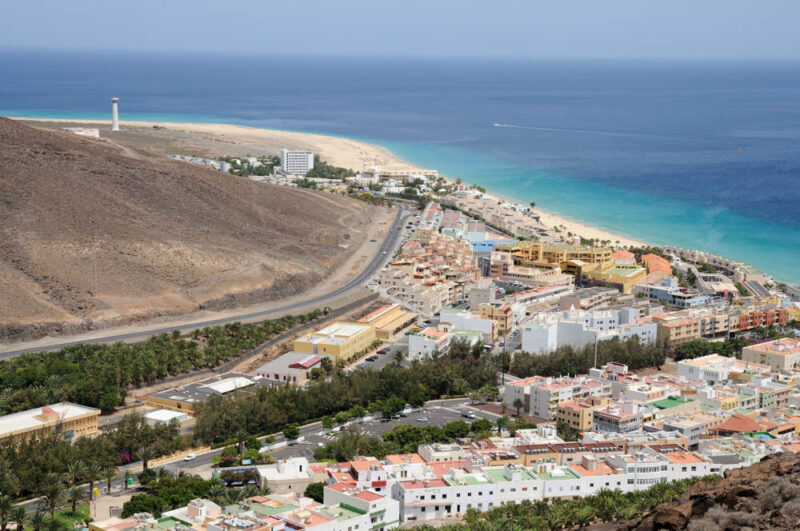
Not as developed as Tenerife and not as primitive as La Gomera, Fuerteventura is figuratively nestled comfortably in the middle of the two. While the island is home to some of the best cities to visit in the Canary Islands, Fuerteventura is best known for its dramatic sand dunes, rugged coastline, and spectacular conditions for all kinds of watersports. It’s a wonderful place to visit if you want to surround yourself with nature while still being just a short walk away from civilization.
Things to do in Fuerteventura
Caleta de fuste.
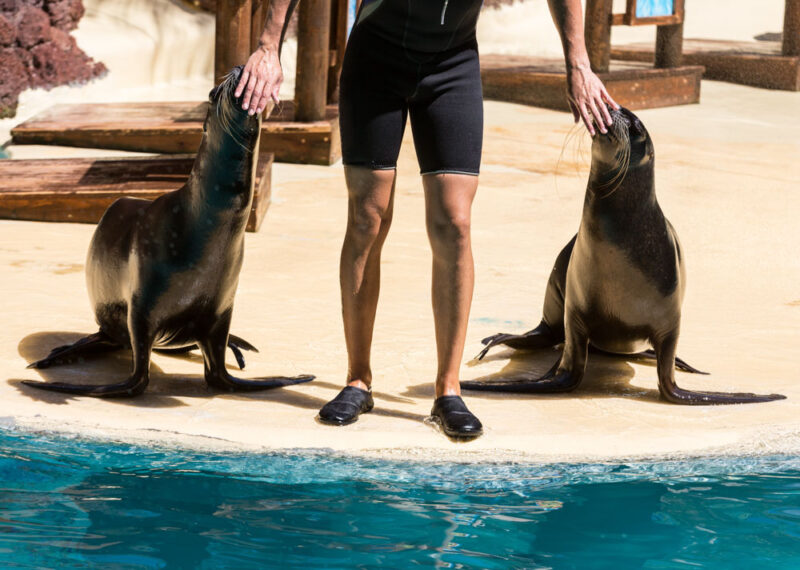
For an experience you’ll never forget, head to Caleta de Fuste and go swimming with sea lions. The port in this resort is home to three friendly sea lions who love showing off their skills and playing with visitors. For more animal antics, dry off and take a gentle stroll along the coastline. Keep a look out, and you’ll spot countless cute chipmunks hiding and playing among the rocks!
Corralejo Natural Park
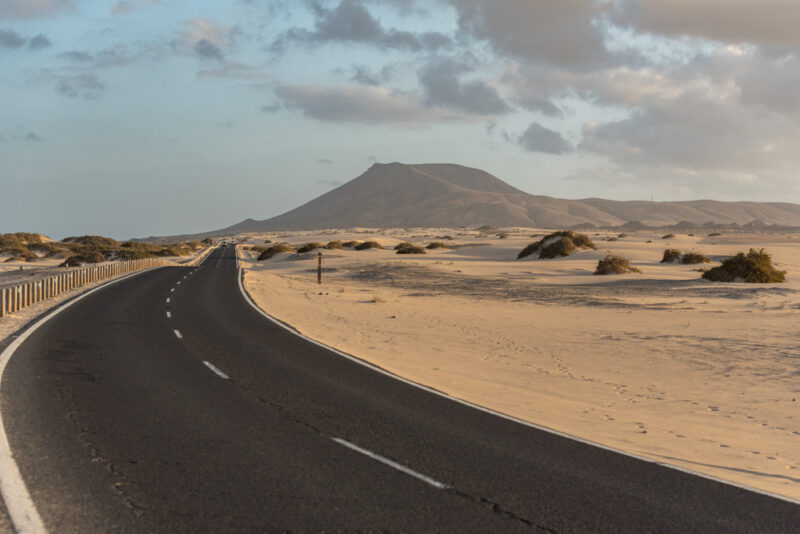
The must-visit attraction in Fuerteventura is the Corralejo Natural Park. With giant golden sand dunes that stretch into the sky, this part of the island is an excellent place to snap some amazing photos.
Majorero Cheese

When you need a break from all the sightseeing, visit one of the island’s many cheese museums. Fuerteventura is famous for its delicious Majorero cheese, which is something you’ve absolutely got to try.
Getting to Fuerteventura
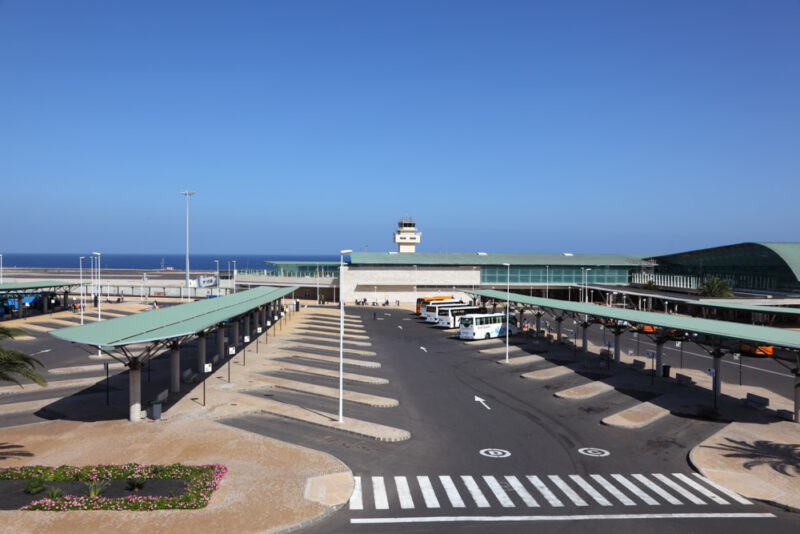
Getting from Gran Canaria to Fuerteventura is easy if you’ve got a rental car. Simply drive to the Port of Las Palmas and hop on a Fred Olsen or Naviera Armas ferry. In just a couple of hours, you’ll arrive at Puerto del Rosario in Fuerteventura.
If you want to avoid the ferry, you can also fly between the islands. There are several cheap flights every day connecting Las Palmas Airport in Gran Canaria with Fuerteventura Airport (also known as El Matorral Airport).
Where to stay in Fuerteventura
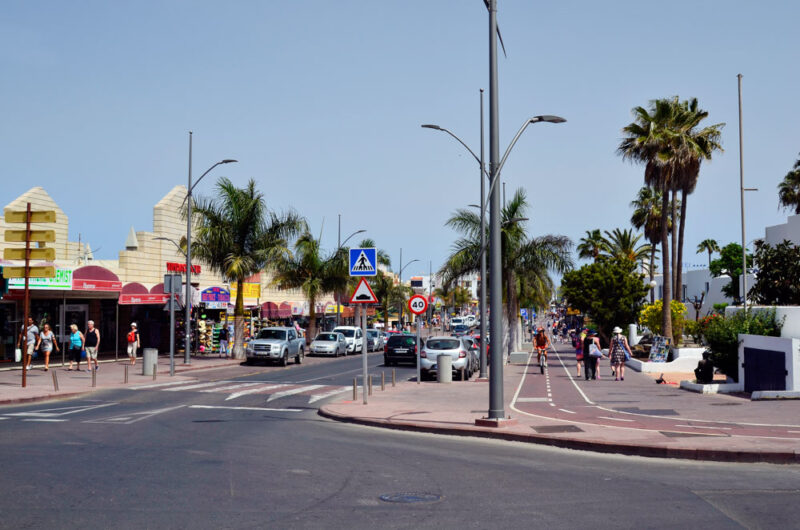
Corralejo is the liveliest place to stay in Fuerteventura. This part of the island is home to luxury hotels and small boutique inns, as well as great beaches, cool cocktail lounges, and trendy restaurants.
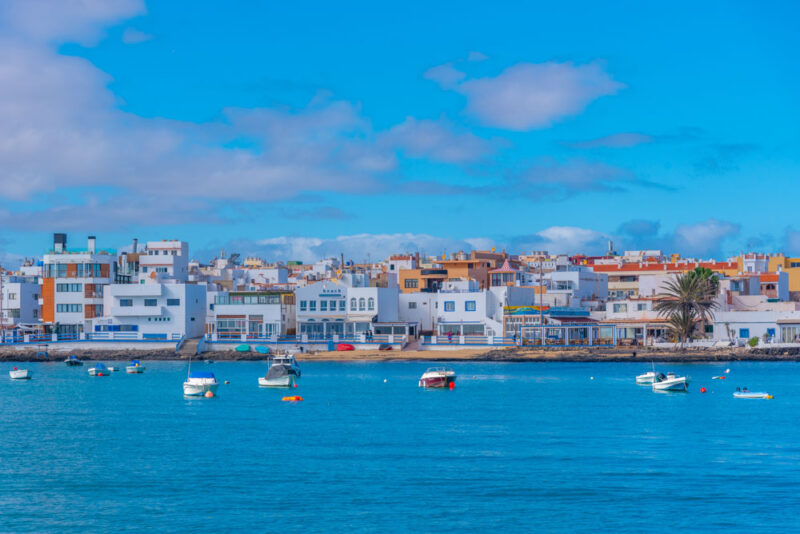
For something a bit more tranquil, consider staying in El Cotillo or Caleta de Fuste. These peaceful resort towns boast gorgeous beaches and natural volcanic swimming pools, as well as a good number of fish and seafood restaurants. Check out our picks for the best hotels in Fuerteventura.
Lanzarote – 2 nights
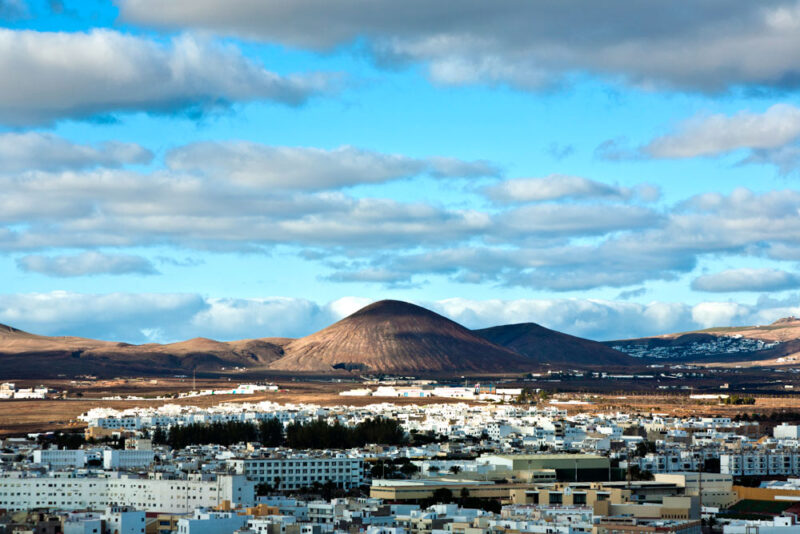
Last up on your Canary Islands itinerary is Lanzarote . This stunning island was formed by a volcanic eruption 180 million years ago and, as a result, has a spectacular landscape full of surprises. The coastline is dotted with luxury vacation resorts and gorgeous beaches, while inland, you’ll find incredible volcanic scenery and some of the most beautiful cities in the Canary Islands.
Things to do in Lanzarote
Timanfaya national park.

If you only do one thing in Lanzarote, you’ve got to visit the Timanfaya National Park. Here you can surround yourself with a phenomenal alien-like landscape created over millions of years. You can also stop by El Diablo restaurant and have your food cooked using the heat of a volcano!
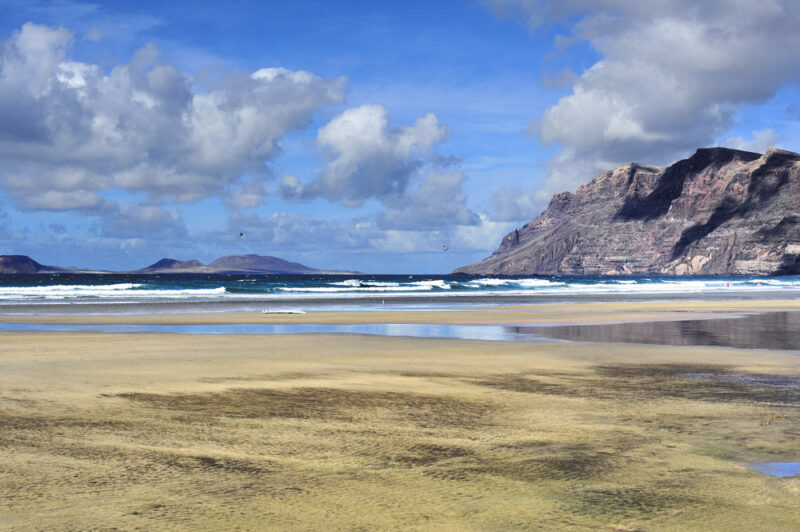
When you’ve had enough of mountains and volcanoes, head to the coast. If you want to stay on top of the ocean, try your hand at surfing in Famara. If you’d rather get underwater, go diving and discover the very first underwater museum in Europe .
Jardín de Cactus
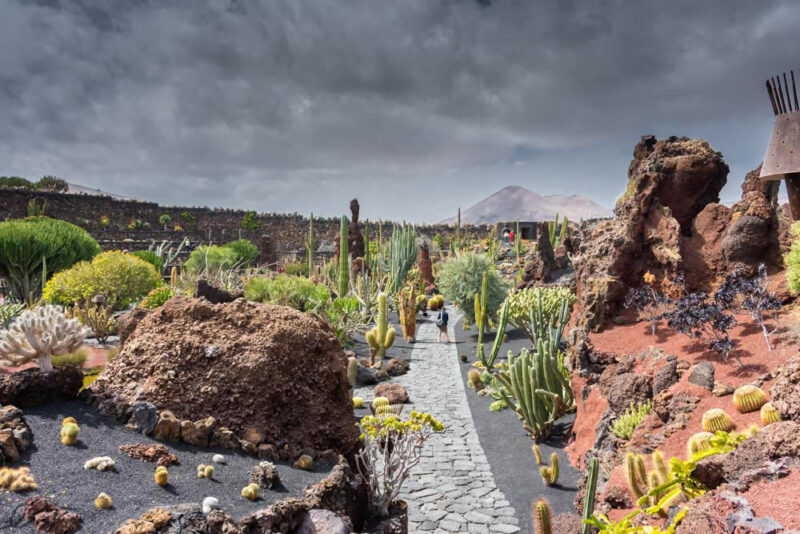
Not a fan of water? Stay on dry land and discover thousands of plant species at the Jardín de Cactus. Or visit the César Manrique Foundation and check out the amazing house where the famous local artist used to live.
Getting to Lanzarote
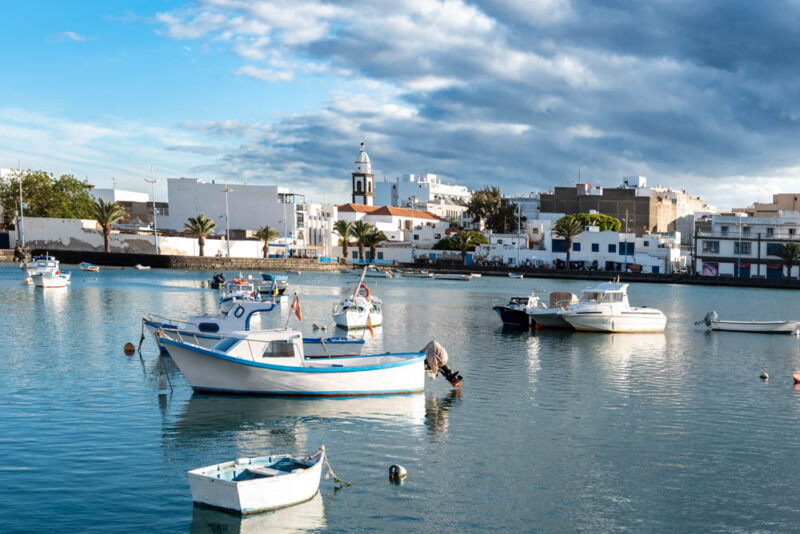
The final leg of your journey is just as simple as the others. Fuerteventura and Lanzarote are extremely close. Hop on a Fred Olsen or Naviera Armas ferry in Puerto del Rosario in Fuerteventura, and in 30 minutes, you’ll arrive at Arrecife Port in Lanzarote.
If you’d rather catch a plane, you can fly from Fuerteventura Airport to Lanzarote Airport (César Manrique-Lanzarote Airport). But there are no direct flights – you have to fly via Gran Canaria. Because of this, we definitely recommend catching a ferry. It’s both quicker and cheaper.
Where to stay in Lanzarote
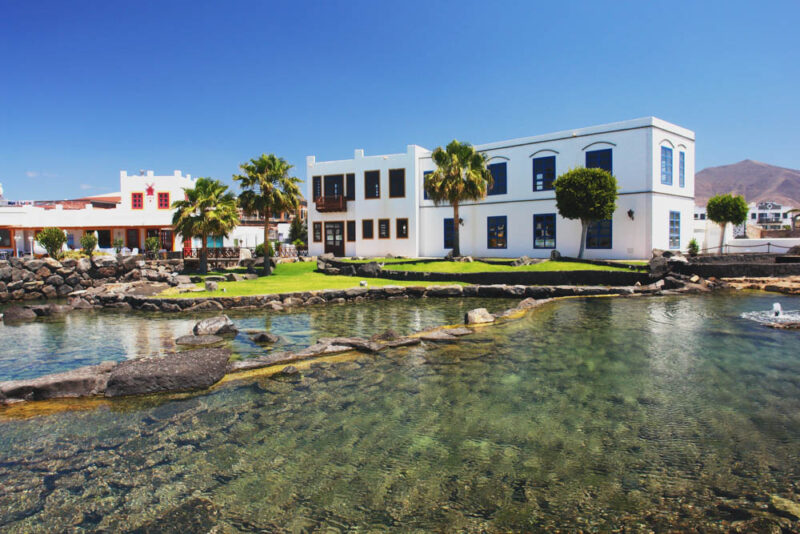
If you’re visiting Lanzarote as a family, Playa Blanca and Costa Teguise are great places to stay. These resort towns are in the middle of all the action, home to great hotels, bars, restaurants, shops, and beaches.
Consider staying in Famara if you’re an avid surfer and you want to catch some waves. This part of the island always has amazing surfing conditions. Or, for a little bit of peace and quiet, consider the laid-back resort of Haria. Check out our picks for the top boutique hotels in Lanzarote !
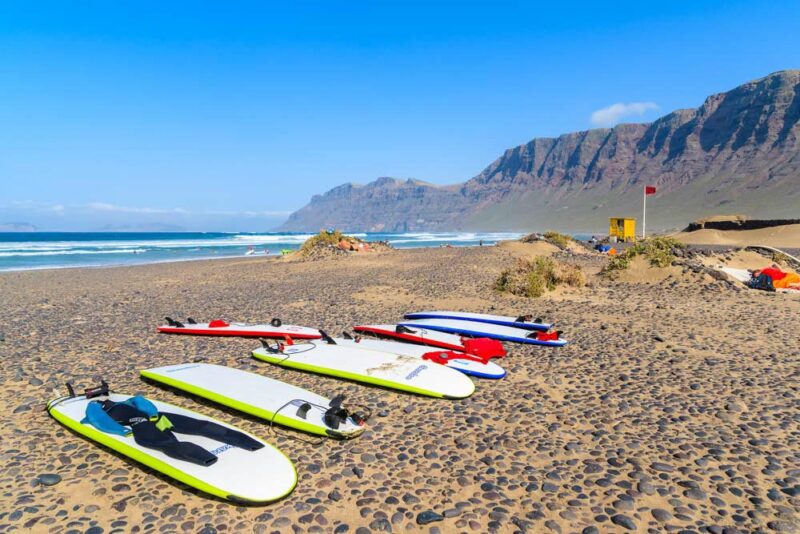
There you have it! That’s our perfect 2-week Canary Islands itinerary. Where will you be traveling on your trip to the Canary Islands?
Share this on pinterest.
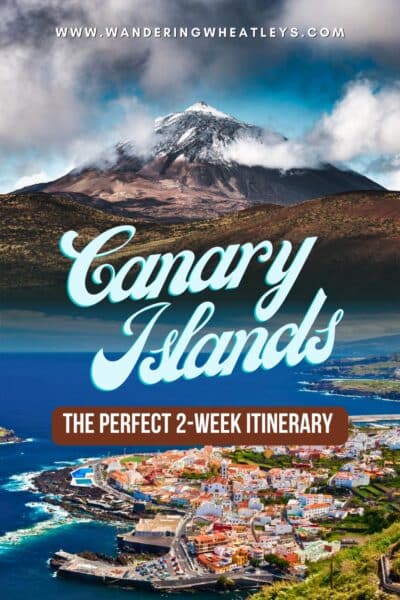
About the Author:

Nicola is a freelance writer with an insatiable hunger for travel. She swapped her home in the UK for the sunny Canary Islands when she was just 11 and she has been based there ever since. From crawling on her hands and knees inside pyramids in Egypt to swimming with baby sharks in Bali and searching (fruitlessly!) for the Northern Lights in Iceland, Nicola takes every chance she gets to explore new places. The incredible experiences she has around the world fuels her writing and inspires her to plan even more adventures for the future.
View all posts
Related Posts

The 12 Best Boutique Hotels in Frankfurt, Germany

The 12 Best Boutique Hotels in Tuscany, Italy
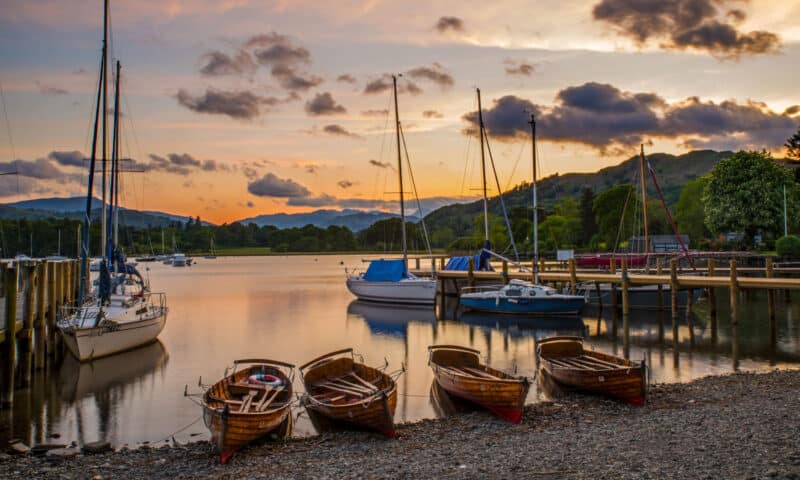
The 12 Best Things to Do in the Lake District, UK
Leave a comment cancel reply.
Your email address will not be published. Required fields are marked *
Tenerife Gran Canaria Lanzarote Fuerteventura La Palma La Gomera El Hierro
- La Graciosa
- Fuerteventura
- Gran Canaria
- Means of Transport
- Natural Parks
- Theme Parks
- Aquatic and Theme Parks
- Hotels in Tenerife
- Hotels in Gran Canaria
- Hoteles de Fuerteventura
- Hotels in Lanzarote
- Hotels in La Palma
- Hotels in La Gomera
- Hotels in El Hierro
- Apartaments
- Canary Islands
- Prepare your holidays
- What to see
- Canary Food and Drinks
- Privacy and Policy
Travel by Ferry in the Canary Islands (Tenerife and others)
Discover how to buy your ferry tickets in the canary islands (tenerife, lanzarote, gran canaria, fuerteventura, la gomera, la palma and el hierro):.
A good option both to get to the Canary Islands as to travel between each other is to take a ferry. If you wish to use the ferry you should know that there are many regular trips per day and usually they are very punctual. You might also take your own car on the Ferry.
According to your departure, there are different ferry types which will take more or less time. As an example you should know that a trip from Cadiz to Lanzarote might take from 1 to 2 days.
Ferry to the Canary Islands and Tenerife from Spain:
The main Ferry lines between the Peninsula and the Canary Islands are:
Gran Canaria – Cádiz – Gran Canaria Lanzarote - Cádiz – Lanzarote Tenerife - Cádiz – Tenerife
Ferry in the Canary Islands to travel between the different islands:
If you’ve already decided to travel between the Canary Islands by Ferry you should know that there are many different combinations to nearly every island. As, for example, you wish to go from Cadiz to Fuerteventura and, for some reason, the dates don’t match your wishes, you might always go from Cádiz to Lanzarote and from Lanzarote to Fuerteventura as this trip will only take 30 minutes and it’s very accessible.
Main Ferry lines between islands:
La Palma – Tenerife Tenerife – (Gran Canaria, La Palma, Gran Canaria, La Gomera and el hierro) Gran Canaria – (Tenerife, Fuerteventura, Lanzarote) Fuerteventura – (Gran Canaria, Lanzarote) Lanzarote (Fuerteventura y Gran Canaria) .
List of the most used/recommended means of transport:
- Means of transport to travel inside an island:
- How I can go from one island to another?
- Means of transport to travel between different islands:
- Rent a Bike
Flight Offers:
Compare flight offers and book in advance to save some money.
Book now your Hotel or Apartment:
- Hotels in Arona
- Hotels in Costa Adeje
- Accommodation in Los Cristianos
- Accommodation in Santa Cruz de Tenerife
- Hotels in Las Palmas de Gran Canaria
- Hotels in Maspalomas
- Accommodation in Playa del Inglés
- Hotels in Corralejo
- Apartaments in Costa Teguise
- Hotels in Valle Gran Rey
Find the largest offer in car rental for your holidays:
How To Travel Between Canary Islands: The Ultimate Guide

There are two main ways to travel from Canary Island to Canary Island: Boat and plane. Most travelers will try the latter first these days. That’s because flying is not only a whole load quicker but also cheaper in many cases.
Ferries are slower and tend to be more expensive when it comes to getting between the major islands. Reasons you might want to take them include the ability to transport cars and more luggage, but also the pleasantness of the ride itself ( whale spotting is a possibility , you know?).
There are pretty darn good links between this set of Spanish isles . Flights and ferries combine to offer a whole load of different options, both quick and interesting, affordable and comfy. Let’s dig a little deeper…
Table of Contents
How to travel between the Canary Islands – a quick overview

Now we’ve got the geography lesson out of the way, let’s take a look at how you can hop and cross that 300 miles of Atlantic Ocean from west to east, east to west, all in search of perfect beaches and the best volcano hikes. Let’s begin by stating the obvious: There are only two ways to cross from isle to isle, by sea or by air. To put it another way, by plane or by boat.
Mhmm, there are no bridges that link any of the isles, no underwater tunnels, no causeways. You’re going to have to ditch the wheels for this one. The good news is that actually makes things pretty simple, as you always know there are only ever two choices for getting from A to B in these parts.
Generally speaking, flying is considered the fastest option while sailing is more relaxed. However, there are some routes that you might have to do by one method simply because there is no boat or flight connection on the menu. That’s why it’s worth getting to know a bit about both modes of transport…
How to travel between the Canary Islands by plane

Here’s the good news: Every single major island of the eight in the Canaries has its own airport, while Tenerife – one of the most popular – even has two. That probably makes this one of the best-connected regions for aviation in the whole of Europe, although most of the terminals are pretty small and only host a handful of carriers.
Talking of carriers…there are two main names to know about when it comes to internal flying here. Let’s take a quick look at each in turn:
- Binter Canarias – The biggest of the two carriers who operate domestic routes throughout the Canaries, Binter, as it’s known for short, has an encompassing array of links between major islands but also serves international destinations in mainland Spain and other Atlantic archipelagos like Cabo Verde.
- Canaryfly – A relatively new name on the block, Canaryfly was founded in 2008 and currently runs flights on eight of the most popular routes in the chain.
Both of the above operate airplanes designed specifically for short haul carrying. That means no massive Boeing and Airbus models, but rather smaller prop planes built by Bombardier and the like. The upshot? Capacity tends to be smaller so flights can sell out faster, but there’s also not an overload of demand and there are often multiple departures each day on the most popular routes.
Route wise, things are pretty good when it comes to moving from major islands to other major islands. For example, you can get upwards of 10 connections a day on Binter Canarias between Lanzarote and Gran Canaria. The same can’t be said for getting to smaller islands like La Gomera, which only has two or three daily links to Gran Canaria, and sometimes no links to other islands at all, meaning a stopover will be needed if you want to do certain legs in a single trip.
Prices tend to be VERY attractive for flights. As an example, springtime fares on Binter from Tenerife North to La Palma can be as low as €12.50 ($13.15) each way, while connections on the most popular routes rarely swell past €27 ($28.40) each way. These are also full-service fares, mostly allowing for some changes and with a checked baggage allowance of 20kg per person (10kg for infants). Not bad, eh?
The truth is that flying from Canary to Canary is now the number-one choice among travelers. Dropping airfare and high convenience means it’s very often the best way to get from A to B, especially when looking to move quite far across the archipelago, say from Lanzarote in the east all the way to La Palma in the west.
How to travel between the Canary Islands by boat

If you don’t have a head for heights or want to travel slow, then there’s always the option of the boats. At least four big companies still offer a comprehensive array of island-to-island links here, including Armas , Biosfera Express, Líneas Romero, and Fred Olsen. Some specialize in different regions of the Canaries, while others cover the whole shebang.
Laying out every route there is by ferry in the Canaries would take a short book but suffice to say there are lots to pick from. A good starting point for planning a trip is to get to know the major ports of each island. That’s Arrecife in Lanzarote, for example, but Las Palmas in Gran Canaria , and then much smaller Puerto de la Estaca over in El Hierro. Knowing the places where the boats depart from makes it easy to search for routes out to the places you want to go, helping you put together island-hopping itineraries in full.
Ferry links naturally take longer than connections in the air. While a flight from Lanzarote to Gran Canaria is in the range of 45 minutes, a boat trip can clock up 5.5-6.5 hours in all. It’s certainly not for commuters or hurried vacationers. In fact, one of the great draws of the trip by water is the journey itself – it’s not unusual to spot dolphin pods and whales as you go, while the vistas of other islands passing by can be wonderful.
Sadly, the prices don’t seem to mirror the extra effort it takes on many routes, so ferries in the Canaries are a bit of a labor of love. You can pay under €20 for a ride from Arrecife to Gran Canaria by plane but will have to fork out nearly €100 for the same trip done by the sea!
Of course, the major upside of ferry travel is that you can transport more than just yourself and your baggage. You can take whole cars and motorbikes if you like. However, if you plan on doing that and are renting a car, it’s certainly worth checking with your hire company that their policy allows for inter-island travel.
Reece is the creator and editor of Travel Snippet. He has visited more than 38 countries over a 10-year period. His travels have taken him through the majestic mountains of Italy, into the cities of central Europe, across the islands of Indonesia, and to the beaches of Thailand, where he is currently living. He is passionate about travel and shares his expertise by providing the best travel tips and tricks to help you plan your next adventure.
Related posts
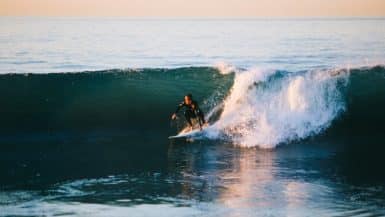
The 5 Best Fuerteventura Surf Spots For Beginners

Whale Watching In Tarifa: Best Time, Prices, & Tour Operators

The Best Snorkeling In Spain: 7 Spots To Dive Into
C a n a r y F o r u m
Canary Islands; Inter-Island Travel
Just because you've chosen one of the islands as your main destination, doesn't mean you can't visit one or more of the others. Flight time from one island to another is around 45 minutes.
The ferry service between Fuerteventura and Lanzarote takes around 20 minutes, between Tenerife and La Gomera, little over an hour and less than an hour between Tenerife and Gran Canaria. Of course, people have been known to swim between islands but this limits you on the amount of luggage you can take with you.
The easiest way would be to see a holiday rep once you've arrived and ask about booking a day trip. This way, they take care of getting you to the port/airport on time, provide transport and once at your destination, take you to the most interesting places and provide you with meals.
If you're not traveling with a tour operator, you can still call in to one of their complexes and ask to go on one of their tours.
The main airline that travels between the islands is Binter Canarias. They run regular flights during the day from one island to another. Advanced booking is advised as the flights can become full with queues of people and the waiting lists. CanaryFly also travel between the islands
If you have a confirmed seat then check in is usually 45 minutes before the flight is due to depart. There's no allocation of seats until you actually get on the plane itself so if you want a good one, be the first in the queue when the flight's and then just run!
The Ferry Companies that run between the islands are Spain's national ferry service, Transmediterranea , Fred Olsen and Armas . They each have regular ferry and jetfoil services, the latter being the faster but slightly more expensive option.
Longer journeys - Gran Canaria to the north of Fuerteventura or Tenerife to La El Hierro are examples - can be traveled overnight, 8 hours asleep in a cabin.
With all the ferry companies, CanaryFly & Binter Airways, you can switch their web sites into English, look at the latest timetables and check out the cost of each journey. If you're happy with what you find there you make your booking online for a "ticketless flight".
In my experience, rather than hiring a car on one island and taking it over on the ferry, it's cheaper to leave it at the port and hire another one at the port your going to. Also with many of the car hire companies you won't be insured if you take the car to a different island.
The cost of flights to any of the major islands are very similar so it's also feasable/economical to fly into one island, cross over to another then fly back home from there.
- Gran Canaria Booking Form
- Tenerife Booking Form
- How does it work?
- Gran Canaria Airport Transfer Reviews
- Blog - All Articles
Navigating The Travel Restrictions In The Canary Islands: What You Need To Know
- Last updated Aug 01, 2023
- Difficulty Intemediate
- Category United States
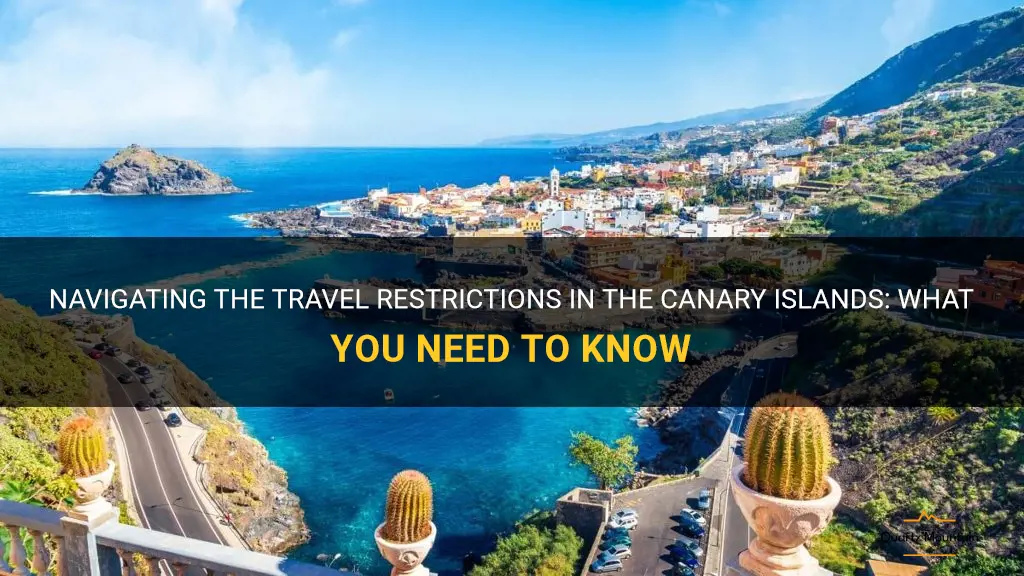
Have you been dreaming of escaping to a place of endless sunshine, beautiful beaches, and stunning natural landscapes? Look no further than the Canary Islands. However, before you pack your bags, it's important to understand the latest travel restrictions in place due to the ongoing pandemic. From mandatory testing to quarantine requirements, navigating the current regulations can seem daunting. But don't worry, we've got you covered. In this article, we'll break down all the essential information you need to know before embarking on your Canary Islands adventure. So, grab your sunblock and get ready to explore this tropical paradise while staying safe and compliant with the travel restrictions in place.
What You'll Learn
What are the current travel restrictions in place for the canary islands, are there any quarantine requirements for travelers entering the canary islands, are there any specific entry requirements or documentation needed to travel to the canary islands, are vaccinated individuals exempt from any travel restrictions in the canary islands, are there any restrictions on inter-island travel within the canary islands.

The Canary Islands, located off the northwest coast of Africa, are a popular destination for travelers from around the world. However, due to the ongoing COVID-19 pandemic, there are currently travel restrictions in place for the Canary Islands to help prevent the spread of the virus.
As of the time of writing, the travel restrictions for the Canary Islands vary depending on the country of origin of the traveler. The Spanish government has established a traffic light system to categorize countries based on their COVID-19 risk level. The classification of countries can change regularly, so it is important to stay updated before planning a trip to the Canary Islands.
Travelers from countries classified as "green" are allowed to enter the Canary Islands without restrictions. These countries are considered low risk for COVID-19 transmission. However, all travelers, regardless of their country of origin, must complete a health control form online before traveling.
Travelers from countries classified as "amber" are required to provide a negative COVID-19 test result taken within 72 hours before their arrival to the Canary Islands. This test can be a PCR or antigen test. If a negative test result is not provided, travelers may be denied entry. In addition to the test requirement, travelers must also complete the health control form.
Travelers from countries classified as "red" are subject to stricter measures. They must provide a negative COVID-19 test result taken within 72 hours before their arrival and also undergo a mandatory 10-day quarantine upon arrival. This quarantine can be carried out at their place of accommodation. Travelers must also complete the health control form.
It is important to note that these restrictions may change at any time, and travelers are advised to regularly check for updates before planning their trip to the Canary Islands. It is also recommended to follow any additional measures or protocols put in place by the local authorities.
In addition to the travel restrictions, it is also important to be aware of any requirements for travel insurance and COVID-19 health coverage. Some countries may require travelers to have specific insurance coverage in case they contract COVID-19 while abroad.
Travelers should also be prepared for health and safety protocols in place within the Canary Islands. These may include the wearing of face masks in public spaces, social distancing measures, and enhanced hygiene practices.
In conclusion, there are currently travel restrictions in place for the Canary Islands due to the COVID-19 pandemic. The restrictions vary depending on the country of origin of the traveler and can change regularly. It is important for travelers to stay informed and follow any updated guidelines and requirements set by the local authorities.
New York Implements Strict Travel Restrictions to Control COVID-19 Spread
You may want to see also
As the world continues to grapple with the COVID-19 pandemic, travel restrictions and quarantine requirements have become the new norm. If you are planning a trip to the beautiful Canary Islands, it is essential to stay updated on the latest travel regulations to ensure a smooth and hassle-free journey.
The Canary Islands, a Spanish archipelago located off the northwest coast of Africa, have implemented certain quarantine requirements for travelers entering the islands. These measures are designed to protect the health and safety of both residents and visitors.
As of the time of writing, all travelers aged six years and above must present a negative PCR (Polymerase Chain Reaction) test result upon arrival to the Canary Islands. The test must be taken no more than 72 hours before arrival and must be an official document issued by a certified laboratory. It is important to note that antigen tests and self-administered tests are not accepted.
In addition to the PCR test requirement, travelers must also complete a health control form before their arrival. This form, known as the "Health Control Form" or "FCS," can be filled out online or through a mobile app. The FCS requires travelers to provide personal information, contact details, and details about their trip, including flight and accommodation information.
Upon arrival at the airport in the Canary Islands, travelers may be subject to a temperature screening. If a passenger displays symptoms of COVID-19 or has a temperature above 37.5 degrees Celsius, they may be required to undergo a second health assessment, including a PCR test and a possible 14-day quarantine.
It is important to note that these requirements may be subject to change as the COVID-19 situation evolves. Travelers are advised to regularly check for updates from official sources such as the Spanish Ministry of Health and the Canary Islands' official tourism websites.
It is also advisable to check with your airline or travel agency for any additional requirements or restrictions that may apply to your specific travel plans. Some airlines may have their own health and safety protocols in place.
In summary, travelers entering the Canary Islands are currently required to present a negative PCR test result taken no more than 72 hours before arrival. They must also complete a health control form prior to their trip. Upon arrival, travelers may be subject to temperature screenings and additional health assessments. It is crucial to stay updated on the latest regulations and requirements to ensure a smooth and safe journey.
Exploring the Current Travel Restrictions in Chicago: What You Need to Know
If you are planning a trip to the beautiful Canary Islands, you may be wondering about any specific entry requirements or documentation needed for your visit. Here is a guide to help you navigate the necessary travel documents needed for a smooth journey.
Passport: All visitors to the Canary Islands must have a valid passport. Your passport should have at least six months of validity remaining from the date of your departure from the Canary Islands. It is important to check the expiration date of your passport and renew it if needed before your trip.
Visa: Depending on your nationality, you may need a visa to enter the Canary Islands. The Canary Islands are a part of Spain and are a part of the Schengen Agreement. This means that visitors from countries within the Schengen Area, such as the European Union member states, do not need a visa to travel to the Canary Islands. However, if you are a citizen of a country outside the Schengen Area, you may need to obtain a visa.
ESTA (Electronic System for Travel Authorization): If you are a citizen of a country that is eligible for the Visa Waiver Program (VWP), such as the United States, you are required to have a valid ESTA. The ESTA allows eligible travelers to visit the Canary Islands for up to 90 days without obtaining a visa. It is essential to complete the ESTA application online and receive authorization before traveling.
COVID-19 restrictions: Due to the ongoing COVID-19 pandemic, there may be additional entry requirements and restrictions in place to ensure the safety of travelers and residents of the Canary Islands. It is crucial to check the latest travel advisories and requirements before your trip. This might include completing a health declaration form, showing proof of a negative COVID-19 test, or providing evidence of vaccination.
Travel insurance: While travel insurance is not a mandatory requirement, it is highly recommended to have travel insurance coverage when visiting the Canary Islands. Travel insurance can provide crucial protection in the event of travel delays, medical emergencies, or unexpected cancellations.
In summary, to travel to the Canary Islands, you will need a valid passport with at least six months of validity remaining. Depending on your nationality, you may need to obtain a visa or an ESTA. Due to the ongoing COVID-19 pandemic, additional entry requirements and restrictions may be in place, so it is essential to stay informed and plan accordingly. Lastly, having travel insurance can provide peace of mind during your trip. Remember to check the latest travel advisories and requirements before your departure to ensure a smooth journey to the enchanting Canary Islands.
Exploring the Impact of Travel Restrictions in Indiana: A Comprehensive Guide
As the COVID-19 pandemic continues to affect travel worldwide, many countries and regions have implemented various travel restrictions to limit the spread of the virus. In the case of the Canary Islands, an archipelago located off the coast of northwest Africa and part of Spain, there are specific regulations in place regarding travel restrictions for vaccinated individuals.
The Canary Islands, being a popular holiday destination known for its beautiful beaches and mild climate, has put great emphasis on reopening its borders to tourists in a safe manner. As a result, they have implemented a system that provides certain exemptions to vaccinated individuals in terms of travel restrictions.
According to the current regulations in the Canary Islands, individuals who have received a complete vaccination against COVID-19 are exempt from certain travel restrictions. These restrictions include mandatory quarantine requirements and the need for a negative COVID-19 test result upon arrival. This means that vaccinated individuals can enter the Canary Islands without having to undergo mandatory quarantine or provide a negative test result as long as they can prove their vaccination status.
To be considered fully vaccinated, individuals must have received the complete dose of a COVID-19 vaccine at least 14 days prior to their arrival in the Canary Islands. It is important to note that only vaccines authorized by the European Medicines Agency (EMA) or the World Health Organization (WHO) are accepted for the purposes of exemption from travel restrictions.
Additionally, individuals must provide official documentation of their vaccination status, which can be in the form of a vaccination certificate, a digital vaccine passport, or any other official proof recognized by the authorities in the Canary Islands. This documentation should clearly indicate the individual's name, the type of vaccine received, the date of vaccination, and the number of doses received.
It is important to mention that these exemptions apply to vaccinated individuals traveling to the Canary Islands from both domestic and international destinations. However, it is essential to stay updated with the latest travel regulations and requirements, as they may change depending on the evolving situation of the pandemic.
It is crucial to note that while vaccinated individuals may be exempt from certain travel restrictions, they are still expected to comply with other health and safety measures in the Canary Islands. These measures may include wearing face masks in public spaces, practicing good hand hygiene, and maintaining social distancing guidelines.
In conclusion, vaccinated individuals traveling to the Canary Islands are exempt from certain travel restrictions, including mandatory quarantine and the need for a negative COVID-19 test result upon arrival. However, it is essential to provide official documentation of vaccination status and adhere to other health and safety measures implemented in the Canary Islands. It is advisable to stay updated with the latest travel regulations and requirements as they may change based on the current situation of the pandemic.
The Impact of Travel Restrictions on Unvaccinated Individuals in the USA
As of the current regulations, there are no restrictions on inter-island travel within the Canary Islands. Travelers are free to move between the different islands without the need for any specific permits or documentation. This means that you can easily explore the unique landscapes, beaches, and attractions that each island has to offer.
The Canary Islands, which consist of Tenerife, Gran Canaria, Lanzarote, Fuerteventura, La Palma, La Gomera, El Hierro, and La Graciosa, are well connected by ferry services and domestic flights. Both options provide convenient transportation for those looking to hop between islands during their stay.
Ferries are a popular mode of transportation for inter-island travel, offering regular services between the major islands. These ferries are operated by different companies, and you can choose from various departure times and routes depending on your preferences. The journey durations can vary depending on the distance between the islands, but most trips are relatively short, ranging from 20 minutes to a few hours.
Alternatively, domestic flights are also available for inter-island travel within the Canary Islands. Several airlines offer regular flights between the different airports, making it easy to reach your desired destination quickly. Flight durations are typically short, ranging from 20 minutes to an hour, making it a convenient option for those with limited time.
When planning your inter-island travel, it is essential to check the ferry or flight schedules in advance, as they can vary depending on the time of year and demand. It is also advisable to book your tickets in advance, especially during peak travel seasons, to secure your preferred departure time.
While there are no specific restrictions on inter-island travel, it is important to note that there may be certain travel requirements in place due to COVID-19. It is recommended to check the latest travel advisories and guidelines issued by the local authorities before making any travel arrangements. These guidelines may include the need for negative COVID-19 test results, proof of vaccination, or other health and safety protocols.
In conclusion, inter-island travel within the Canary Islands is generally unrestricted, allowing travelers to explore the diverse beauty of each island. Whether you choose to travel by ferry or plane, the transportation options are convenient and readily available. However, it is important to stay informed about any COVID-19 related travel requirements and guidelines to ensure a smooth and safe journey.
Exploring the Current Travel Restrictions in Laos: What Travelers Need to Know
Frequently asked questions.
Yes, you can travel to the Canary Islands, but there are certain travel restrictions in place.
Currently, travelers arriving in the Canary Islands must provide a negative COVID-19 test result taken within 72 hours prior to their arrival. They must also complete a health form and undergo a temperature check upon arrival.
No, as long as you have a negative COVID-19 test result and do not display any symptoms, you do not need to quarantine upon arrival in the Canary Islands.
The requirements for returning to your home country from the Canary Islands will vary depending on your country of residence. It is important to check with the relevant authorities or your airline for the most up-to-date information on any testing or quarantine requirements.
Yes, inter-island travel within the Canary Islands is currently allowed. However, it is recommended to check for any specific travel restrictions or requirements within each individual island before making any travel plans.

- Pop Panupong Author Reviewer Traveller

- Annie Rangel Author Editor Reviewer
It is awesome. Thank you for your feedback!
We are sorry. Plesae let us know what went wrong?
We will update our content. Thank you for your feedback!
Leave a comment
United states photos, related posts.

10 Romantic Activities to Experience in Macon GA
- May 07, 2023

Essential Items to Pack for a Trip to Hawaii
- Feb 13, 2024

12 Amazing Free Things to Do in Lubbock

Glowing Fun: Creative Ideas with Glow in the Dark Paint
- Jun 29, 2023

Essential Items to Pack for an RV Trip with Your Baby
- Jan 21, 2024

What Not to Pack on American Airlines: Essential Guidelines for Smooth Travel
- Nov 26, 2023
‘The future of the Canary Islands is hanging by a thread’ – why Spain is falling out of love with tourists
Campaigners in spain say it’s time for a tourism moratorium as numbers rise beyond the country’s capacity.
Members of the 'Canaria se agota' ('Canaria is exhausted') movement protest. Photograph: Desiree Martin/AFP/Getty Images
:quality(70)/s3.amazonaws.com/arc-authors/irishtimes/cf76ca8d-3f5e-45a9-b58c-8f9281c17b46.jpg)
The summer season is approaching, traditionally a time of bonanza for the Spanish tourism industry. But this year is different.
Tourist arrivals have returned to pre-pandemic levels – and in many cases surpassed them – and the impact of these visits has led the country to what appears to be a tipping point.
On Saturday, thousands of people across the Canary Islands plan to take to the streets to demand a halt to tourism-related development, in the first such mass demonstration the archipelago has seen. Last week, six protesters on the island of Tenerife began a hunger strike in protest at the local authorities’ refusal to halt the construction of two major tourism projects.
“Time is running out,” Víctor Martín, a spokesman for the hunger strikers and the activist group Canarias Se Agota (Canary Islands have had enough), told reporters earlier this week. “It is not only the health of those who are on hunger strike that is at risk – the future of the Canary Islands is hanging by a thread. Stop this race to the precipice and introduce a tourism moratorium.”
That They May Face the Rising Sun: The best Irish film in a very long time
:quality(70):focal(2210x780:2220x790)/cloudfront-eu-central-1.images.arcpublishing.com/irishtimes/OQ6NEH52IVC2BJVVSTSV766YRE.jpg)
‘When our last embryo failed, the clinic told us there was nothing more they could do for us’
:quality(70):focal(646x590:656x600)/cloudfront-eu-central-1.images.arcpublishing.com/irishtimes/VBJDWPVX75G3LJCRUOULJPFZLA.jpg)
Take That in Dublin review: ‘Whose idea was it to have stairs?’ puffs Gary Barlow as the band roll back the years with dazzling show
:quality(70):focal(2852x2143:2862x2153)/cloudfront-eu-central-1.images.arcpublishing.com/irishtimes/63VOH6GY2FDITBTY3UXQMH52RM.jpg)
Martín and his fellow protesters are demanding that construction work on the La Tejita hotel and the Cuna del Alma macro-resort, in southern Tenerife, be stopped and that no further projects be started until a debate has been held on the islands’ tourism model.
The Canary Islands received 13.9 million foreign tourists in 2023, more than six times their population. More than five million were from the UK, with Germany and France the next biggest markets. Ireland was the fourth-biggest provider of foreign visitors to the islands, with more than 700,000 tourists.
“Since 2022, it’s been unbelievable, I’ve never seen anything like it,” Martín said. “We have exceeded our capacity and the territory cannot handle any more. It’s not the fault of the tourists. They buy their ticket to come here. It’s the fault of the local authorities who are not putting a brake on all this.”
Martín and his fellow campaigners say the negative impact of such numbers is manifold: packed towns and beaches and queues of traffic make the islands less inhabitable; the archipelago’s renowned natural spaces are suffering; and locals also suffer socio-economic repercussions.
But the discontent is not confined to the Canary Islands.
“We have seen it in Barcelona, in some parts of Andalucía, in the Balearic Islands and now we are seeing it for the first time in a really noticeable way on the Canary Islands,” said Ábel López Díaz, a professor of geography at Tenerife’s La Laguna University. “And this is all linked to the tourist model we have across virtually all of Europe.”
“There used to be lots of really cool bars, those really old quirky classic Spanish bars. But they’re gone. Everything around the centre of the city has become more generic, a bit diluted.” — Paul Slevin
He added: “We know that tourism is a very important economic motor and it’s going to continue being so. But we need to ensure we have a much more sustainable type of tourism in terms of management of resources, being more sustainable economically and, of course, in terms of social impact.”
Spain received a total of 85 million visitors last year, 2 per cent more than 2019. With tourism contributing 13 per cent of GDP, the industry’s strong performance has been driving the Spanish economy’s growth.
On mainland Spain, Barcelona has for years been grappling with the challenge of striking the right equilibrium between welcoming tourists and avoiding being overwhelmed. But as the numbers of arrivals there have continued to soar, the balance appears to have been lost.
[ ‘We don’t want to be Venice’: Barcelona battles an influx of tourists ]
One of the casualties has been smaller local businesses, which have been replaced by souvenir shops and franchise restaurants.
“There used to be lots of really cool bars, those really old quirky classic Spanish bars,” says Paul Slevin, an Irishman who owns Dinamo language academy and has lived in Barcelona for 15 years. “But they’re gone. Everything around the centre of the city has become more generic, a bit diluted.”
The cruise liners that stop off in the city’s port have become perhaps the most contentious aspect of Barcelona’s status as a tourism hub. Last year more than 3.5 million tourists visited on liners, many of them stopping off for just a few hours and seeing only the congested city centre. This year numbers are expected to increase further, with more than 900 liners due to visit.
The city’s previous mayor, the left-wing Ada Colau, took steps to stem the tide of tourism, including limiting the availability of hotel rooms in some parts of the city and shutting down 6,000 illegal holiday apartments. Colau was replaced last year by the socialist Jaume Collboni, who has announced plans to implement similar measures although he is seen as being more business friendly.
Barcelona, like the Canary Islands, has seen a backlash from locals. Anti-tourist graffiti has appeared in some areas and last summer, local people took to the streets to protest, blocking the entrance to one of the city’s biggest attractions, the Güell Park. As this year’s high season approaches, Barcelona – and most of the surrounding Catalonia region – is having to deal with an additional challenge in the shape of its worst-ever drought. A state of emergency has been declared, restricting water use, and last month activists drew attention to the extra pressure tourism exerts on this resource by briefly cutting off the water supply of Barcelona’s Tourism Consortium.
“I think if people come to Barcelona and behave themselves, [local] people don’t mind,” says Slevin. “What they don’t want is horrible, cheap tourism. They don’t want the stag and hen parties.”
This also seems to be the view of the local authorities and many in the industry.
Jordi Clos, the president of the Tourism Consortium, which is a public-private entity, has spoken of the need to transform the type of tourism Barcelona offers. He recently underlined the need “to avoid the masses who don’t bring any benefit to the city and who saturate places like the Ramblas [boulevard], and who, at the very most, end up eating a pre-cooked paella”.
The issue has been fiercely debated in the political arena. The insistence by Colau’s party on vetoing the building of a new leisure resort in Tarragona even triggered the end of the regional legislature in Catalonia.
“They say that we have an impeccable tourism model but it turns out that the people who work within that model are living in slums.” — Víctor Martín
But arguably the most widespread impact of Spain’s tourism boom has been on housing. Rental rates have been soaring across the country due to a shortage of available homes. Tourist apartments have pushed them up further in many areas.
That trend has been particularly pronounced on the Balearic island of Ibiza, where unemployment is low but so too are wages. Rentals have spiralled since the pandemic and some residents have seen increases of 40-50 per cent in the last year alone.
That has led to drastic situations, with some professionals commuting to the island from elsewhere in the Balearics each day while others, including some junior police officers, sleep in cars.
The local government in Ibiza, where 84 per cent of the economy is based on tourism, blames the housing crisis on holiday apartments. Although it has introduced a minimum time frame of six months for each rental, that regulation is constantly being flouted by owners who rent out their homes for just a few days at a time.
[ ‘There are just too many people moving here’: The popularity problem in China’s idyllic Yunnan province ]
The Canary Islands have had a similar problem. With the second-lowest average salary in Spain, at around €23,000 per year, many employed locals are priced out of the housing market.
“They say that we have an impeccable tourism model but it turns out that the people who work within that model are living in slums,” says Víctor Martín, who explains that many workers are sleeping in tents, cars and even caves. “That shows that we have exceeded our limit.”
Martín and many others hope that this weekend’s protests on the Canary Islands will prompt a major change in how the archipelago – and Spain as a whole – manage an industry that keeps on growing.
- Sign up for push alerts and have the best news, analysis and comment delivered directly to your phone
- Find The Irish Times on WhatsApp and stay up to date
- Listen to our Inside Politics podcast for the best political chat and analysis
IN THIS SECTION
When did hotels stop offering single-occupancy rooms at a reasonable price, birding and beyond: the marvellous mystique of the basque country, ‘america is nuts about guns … experiencing it for real is different’, the best places to visit around ireland on a daytrip, six arrested after gardaí ‘attacked’ at site earmarked for asylum seekers in wicklow, td’s daughter not allowed make savings investment because of family relationship to him, ‘she will live on in the hearts and minds of her many family and friends’: cyclist killed in dún laoghaire crash named, ‘i’m alone pretty much all the time. the older i become, the less hopeful i am this will change’, joe duffy’s snap judgment on simon harris’s stardust apology somehow captures the wider mood, latest stories, baby reindeer and dangerous amateur sleuthing: should netflix have seen it coming.
:quality(70):focal(240x145:250x155)/cloudfront-eu-central-1.images.arcpublishing.com/irishtimes/ICHVZA3BQRFORO45FOS2JTAB6Y.jpg)
McEntee defends gardaí after clashes with protesters at Wicklow site earmarked for asylum seekers
:quality(70)/cloudfront-eu-central-1.images.arcpublishing.com/irishtimes/WQEADOTRWZDFJCJQZYDFQWQR7Q.jpg)
Anglo American rejects ‘highly unattractive’ BHP offer
:quality(70)/cloudfront-eu-central-1.images.arcpublishing.com/irishtimes/DUWSWU2HMMZVWO44WRKUNVWGVA.jpg)
Your top stories on Friday: Gardaí ‘attacked’ at Wicklow asylum seeker site; tributes to young cyclist killed in Dublin
:quality(70)/cloudfront-eu-central-1.images.arcpublishing.com/irishtimes/FXK366B5GGSODJIEHJQBFRBJLM.JPG)
Spain’s Bankinter to enter Irish banking market
:quality(70)/cloudfront-eu-central-1.images.arcpublishing.com/irishtimes/REK35OSNBL7DQVKABS5OLBEWUM.jpg)
Person released after questioning about death of woman suspected to have been moved into driver’s seat after crash
:quality(70)/cloudfront-eu-central-1.images.arcpublishing.com/irishtimes/WDJFJSZPW3SY2Z2LKBOFZ47L6Y.jpg)
NatWest first-quarter profit slumps 27% as savings, mortgage competition bite
:quality(70)/cloudfront-eu-central-1.images.arcpublishing.com/irishtimes/L6O46M7TESKQJFXWCNH3UY2BGI.jpg)
Cavan-based Kingspan sees sales drop in first quarter as it warns on costs
:quality(70)/cloudfront-eu-central-1.images.arcpublishing.com/irishtimes/C23RMTDQTRKWRIOPKZI7QLIHCE.jpg)
- Terms & Conditions
- Privacy Policy
- Cookie Information
- Cookie Settings
- Community Standards

IMAGES
COMMENTS
Inter-island Travel. Tenerife makes the perfect base to explore the Canary Islands with direct flights available to all of the other islands and ferry connections with all of the western islands as well as Gran Canaria, Lanzarote and Fuerteventura. The majority of Inter-island flights operate from Tenerife North Airport with the southern ...
Canaryfly. Travelling by boat between the islands is usually cheaper and offers a different setting in which it is easy to spot dolphins and other species. You can go from one island to another with the different companies that connect the islands. The services are frequent and the fares reasonable. There is also the possibility of going round ...
Lanzarote - La Graciosa island hopping. The ferry route from Lanzarote to La Graciosa is one of the best island-hopping adventures you can try in the Canaries! The two islands are frequently connected and are very close. Also, island-hopping tickets are only €15 one-way with Líneas Romero and Biosfera Express.
Canary Islands Travel Tips. Best Months to Visit. ... Stay put The costs for inter-island planes and ferries can add up. Instead of island-hopping, save some coin by soaking in all of the charms ...
Ah, the Canary Islands - a land of smoke-belching volcanos, black-sand beaches, barreling surf breaks, and buzzy resort towns where end-of-holiday tans are all but guaranteed. This sunny archipelago is considered one of the greatest spots in Spain, and, for some travelers, hitting just one island is simply never enough.
Esme Fox 28 January 2020. The Canary Islands lie approximately 100 kilometres from the south coast of Morocco. An archipelago of seven main islands, they may be part of Spain, but seem to have more in common with the Caribbean due to their laid-back vibe, island time and stunning beaches. Many of the Canary Islands have been awarded UNESCO ...
Island hopping in the Canary Islands. 23rd October 2020 Skyscanner. With the Canary Islands back on the UK's travel corridors list, we can start dreaming about a relaxing winter break to Lanzarote, Fuerteventura, Tenerife, or one of the other beautiful islands of the Canary archipelago. From 4 am on Sunday 25 October, UK travellers returning ...
The Canary archipelago is made up of seven principle islands; Lanzarote, Tenerife, Gran Canaria, Fuerteventura, El Hierro, La Gomera and La Palma. These seven islands are well-connected by Flights, Ferries and Fast-Ferries. Since the Canaries are less than 500km across, it is possible to take day-trips to see the other islands.
Tenerife is the only Canary island blessed with Michelin stars - six at last count, with temples to haute cuisine running from Martín Berasategui's two-star, Basque-inspired M.B to the Padrón brothers' seafood sensation El Rincón de Juan Carlos. Make the most out of every adventure with help from our weekly newsletter delivered to your ...
Another option for inter island travel between the Canary Islands, is to take the ferry. There are four companies that you can book; all other ones are intermediairs. Residents of the Canary Islands get a 75% discount on the ferry. Fred Olsen is probably the most known and has the most connections between the islands and between the peninsula.
The main inter-island airlines. The ample connectivity, variety of schedules and flights available make travelling between the islands by plane one of the most convenient and fastest ways of getting around. These are the main island airlines that operate between the islands on a daily basis. ... To travel to the Canary Islands by ferry, the ...
The islands are connected by inter-island ferry services, and you can get around the islands themselves with buses or taxis. Many travelers prefer to rent a car to have the freedom to tour and explore on their own time. ... The Canary Islands are a safe travel destination, but it's best to exercise caution when traveling. ...
The best company to get to the Canary Islands, is Easy Jet. Remember that the earlier you book, the better fares you will get, which is absolutely essential if you choose to travel during the busy periods mentioned above. However, there is a more adventurous way to get to the Canary Islands if you have sufficient time.
Island Hopping in the Canaries. Surprisingly, island hopping is not a well-known or well-developed concept in the Canary Islands. There are some historic reasons for this (more on this below), however many of the obstacles to island hopping have now disappeared and it is now much easier to fly to one island, travel to another, then fly back to ...
Ease of Travel and Exploration: The Canary Islands are well-connected, making island hopping easy. This, combined with a range of accommodation options and readily available information on travel and local customs, makes the archipelago an accessible and tourist-friendly destination. ... Transportation: Inter-island flights, ferries, and local ...
Travel tips. The Canary Islands are well connected by inter-island flights and ferries. Most of the islands have airports - there are 11 in total with 2 on Tenerife and 3 on Gran Canaria. Inter-island flights are mostly served by turboprops.
28°24′54″N 15°54′0″W. Map of Canary Islands. The Canary archipelago consists of 8 inhabited islands, and a few smaller uninhabited ones. 28.268611 -16.605556. 1 Tenerife - The largest and most populous island with an area of 2,034 km² and also the most popular tourist destination of the archipelago, with about 6 million tourists ...
To travel from La Gomera to Gran Canaria (with a stopover in Tenerife) on Binter Canarias, you'll find that a basic fare is €63 EUR (around $87 USD). The total in-air time is about 90 minutes ...
Garajonay National Park. The best 2-week Canary Islands itinerary has to include hiking in La Gomera. The island is blanketed in thick, verdant forests that hide trickling waterfalls, centuries-old bridges, and fountains that boast some of the purest water you'll ever drink.
A good option both to get to the Canary Islands as to travel between each other is to take a ferry. If you wish to use the ferry you should know that there are many regular trips per day and usually they are very punctual. You might also take your own car on the Ferry. According to your departure, there are different ferry types which will take ...
There are two main ways to travel from Canary Island to Canary Island: Boat and plane. Most travelers will try the latter first these days. That's because flying is not only a whole load quicker but also cheaper in many cases. Ferries are slower and tend to be more expensive when it comes to getting between the major islands.
Canary Islands; Inter-Island Travel. Just because you've chosen one of the islands as your main destination, doesn't mean you can't visit one or more of the others. Flight time from one island to another is around 45 minutes. The ferry service between Fuerteventura and Lanzarote takes around 20 minutes, between Tenerife and La Gomera, little ...
In conclusion, inter-island travel within the Canary Islands is generally unrestricted, allowing travelers to explore the diverse beauty of each island. Whether you choose to travel by ferry or plane, the transportation options are convenient and readily available. However, it is important to stay informed about any COVID-19 related travel ...
The Canary Islands received 13.9 million foreign tourists in 2023, more than six times their population. More than five million were from the UK, with Germany and France the next biggest markets.